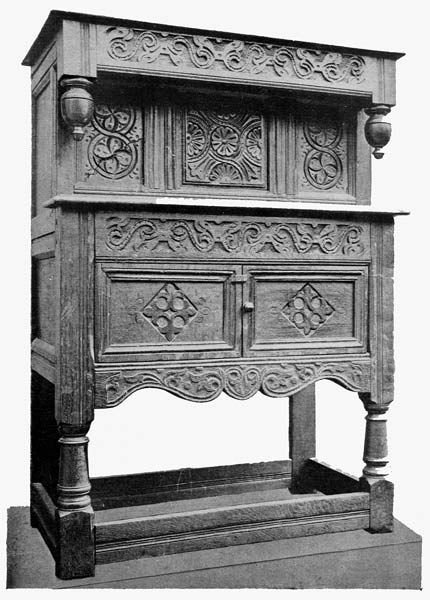
SIDEBOARD OF CARVED OAK. ENGLISH, SEVENTEENTH CENTURY.
(In the Victoria and Albert Museum.)
Frontispiece.
Title: Chats on Cottage and Farmhouse Furniture
Author: Arthur Hayden
Contributor: Hugh Phillips
Release date: January 6, 2014 [eBook #44603]
Most recently updated: October 23, 2024
Language: English
Credits: Produced by Chris Curnow, Mary Akers and the Online
Distributed Proofreading Team at http://www.pgdp.net (This
file was produced from images generously made available
by The Internet Archive)
Transcriber's note:
Spelling and punctuation inconsistencies have been harmonized.
The original hyphenation and use of accented words has been
retained. Obvious printer errors have been repaired. Please see the
end of this book for further notes.
COMPANION VOLUME BY THE SAME AUTHOR
CHATS ON OLD FURNITURE
Illustrated by 72 Full-page Plates.
CONTENTS
| CHAPTER | |
| I. | The Renaissance on the Continent |
| II. | The English Renaissance |
| III. | Stuart or Jacobean (Early Seventeenth Century) |
| IV. | Stuart or Jacobean (Late Seventeenth Century) |
| V. | Queen Anne and Early Georgian Styles |
| VI. | French Furniture: the Period of Louis XV. |
| VII. | French Furniture: the Period of Louis XVI. |
| VIII. | French Furniture: the Period of Louis XVI. |
| IX. | French Furniture: the First Empire Style |
| X. | Chippendale and his Style |
| XI. | Adam, Hepplewhite, and Sheraton Styles |
| XII. | Hints to Collectors |
CHATS ON
COTTAGE AND
FARMHOUSE FURNITURE
BOOKS FOR COLLECTORS
With Coloured Frontispieces and many Illustrations.
Large Crown 8vo, cloth.
CHATS ON ENGLISH CHINA.
By Arthur Hayden.
CHATS ON OLD FURNITURE.
By Arthur Hayden.
CHATS ON OLD PRINTS.
By Arthur Hayden.
CHATS ON COSTUME.
By G. Woolliscroft Rhead.
CHATS ON OLD LACE AND
NEEDLEWORK.
By E. L. Lowes.
CHATS ON ORIENTAL CHINA.
By J. F. Blacker.
CHATS ON MINIATURES.
By J. J. Foster.
CHATS ON ENGLISH EARTHENWARE.
By Arthur Hayden.
(Companion Volume to "Chats on English China.")
CHATS ON AUTOGRAPHS.
By A. M. Broadley.
CHATS ON OLD PEWTER.
By H. J. L. J. Massé, M.A.
CHATS ON POSTAGE STAMPS.
By Fred J. Melville.
CHATS ON OLD JEWELLERY AND
TRINKETS.
By MacIver Percival.
CHATS ON COTTAGE AND FARMHOUSE
FURNITURE.
By Arthur Hayden.
(Companion Volume to "Chats on Old Furniture.")
LONDON: T. FISHER UNWIN.
NEW YORK: F. A. STOKES COMPANY.

SIDEBOARD OF CARVED OAK. ENGLISH, SEVENTEENTH CENTURY.
(In the Victoria and Albert Museum.)
Frontispiece.
BY
ARTHUR HAYDEN
AUTHOR OF "CHATS ON OLD FURNITURE," ETC.
WITH A CHAPTER ON
OLD ENGLISH CHINTZES
By HUGH PHILLIPS
AND SEVENTY-THREE FULL-PAGE ILLUSTRATIONS
NEW YORK
FREDERICK A. STOKES COMPANY
PUBLISHERS
(All rights reserved.)
TO
MY OLD FRIEND
FREDERIC ARUP
I DEDICATE THIS VOLUME
IN MEMORY OF A HAPPY LABOUR
OF LOVE COMPLETED
The number of works dealing with old English furniture has grown rapidly during the last ten years. Not only has the subject been broadly treated from the historic or from the collector's point of view, but latterly everything has been scientifically reduced into departments of knowledge, and individual periods have received detailed treatment at the hands of specialists.
Museums and well-known collections, noblemen's seats and country houses have furnished photographs of the finest examples, and these, now well-known, pieces have appeared again and again as illustrations to volumes by various hands.
It is obviously essential in the study of the history and evolution of furniture-making in this country that superlative specimens be selected as ideal types for the student of design or for the collector, but such pieces must always be beyond the means of the average collector.
The present volume has been written for that large class of collectors, who, while appreciating the beauty and the subtlety of great masterpieces of English 10 furniture, have not long enough purses to pay the prices such examples bring after fierce competition in the auction-room.
The field of minor work affords peculiar pleasure and demands especial study. The character of the cottage and farmhouse furniture is as sturdy and independent as that of the persons for whom it was made. For three centuries unknown cabinet-makers in towns and in villages produced work unaffected by any foreign influences. Linen-chests, bacon-cupboards, Bible-boxes, gate tables, and other tables, dressers, and chairs possess particular styles of treatment in different districts. The eighteenth-century cabinet-makers scattered up and down the three kingdoms and in America found in Chippendale's "Director" a design-book which stimulated them to produce furniture of compelling interest to the collector.
The examples of such work illustrated in this volume have been taken from a wide area and are such as may come under the hand of the diligent collector in various parts of the country.
In view of the increased love of collecting homely furniture suitable for modern use, it is my hope that this book may find a ready welcome, especially nowadays, when so many of the picturesque architectural details of old homesteads are being reproduced in the garden suburbs of great cities.
It is possible that the authorities of local museums may find in this class of furniture a field for special research, as undoubtedly specimens of local work should be secured for permanent exhibition before 11 they are dispersed far and wide and their identity with particular districts lost for ever.
In regard to the scientific study of farmhouse and cottage furniture, the ideal arrangement is that followed at Skansen, Stockholm, and at Lyngby, near Copenhagen. In the former a series of buildings have been erected in the open air, in connection with the Northern Museum, gathered from every part of Sweden, retaining their exterior character and fitted with the furniture of their former occupants. It was the desire of the founder, Dr. Hazelius, to present an epitome of the national life. Similarly at Lyngby, an adjunct of the Dansk Folkemuseum at Copenhagen, the life-work of Hr. Olsen has been given to gathering together and re-erecting a large number of old cottages and farmhouses from various districts in Denmark, from Iceland, the Faroe Islands, and from Norway and Sweden. These have their obsolete agricultural implements, and old methods of fencing and quaint styles of storage. The furniture stands in these specimen homes exactly as if they were occupied. It is a remarkable open-air museum, and the idea is worthy of serious consideration in this country. Old cottages and farmhouses are fast disappearing, and the preservation of these beauties of village and country life should appeal to all lovers of national monuments.[1]
12 In connexion with farmhouse furniture, old chintzes is a subject never before written upon. A chapter in this volume is contributed by Mr. Hugh Phillips, whose special studies concerning this little known field enable him to present much valuable information which has never before been in print, together with illustrations of chintzes actually taken from authentic examples of old furniture.
A brief survey is made of miscellaneous articles associated with cottage and farmhouse furniture. Some specimens of Sussex firebacks are illustrated, together with fenders, firedogs, pot-hooks, candle-holders, and brass and copper candlesticks.
The illustrations have been selected in order to convey a broad outline of the subject. My especial thanks are due to Messrs. Phillips, of the Manor House, Hitchin, for placing at my disposal the practical experience of many years' collecting in various parts of the country, and by enriching the volume with illustrations of many fine examples of great importance and rarity never before photographed.
To Messrs. A. B. Daniell & Sons I am indebted for photographs of specimens in their galleries.
In presenting this volume it is my intention that it should be a companion volume to my "Chats on Old Furniture," which records the history and
13 evolution of the finer styles of English furniture, showing the various foreign influences on English craftsmen who made furniture for the wealthy classes.
ARTHUR HAYDEN.
| CHAPTER I | ||
| PAGE | ||
| INTRODUCTORY NOTE | 25 | |
| The minor collector—The originality of the village cabinet-maker—His freedom from foreign influences—The traditional character of his work—Difficult to establish dates to cottage and farmhouse furniture—Oak the chief wood employed—Beech, elm, and ash used in lieu of mahogany and satinwood—Village craftsmanship not debased by early-Victorian art—Its obliteration in the age of factory-made furniture—The conservation of old farmhouses with their furniture in Sweden and in Denmark—The need for the preservation and exhibition of old cottages and farmhouses in Great Britain. | ||
| CHAPTER II | ||
| SEVENTEENTH-CENTURY STYLES | 43 | |
| Typical Jacobean furniture—Solidity of English joiners' work—Oak general in its use—The oak forests of England—Sturdy independence of country furniture—Chests of drawers—The slow assimilation of foreign styles—The changing habits of the people. | ||
| CHAPTER III | ||
| THE GATE-LEG TABLE | 83 | |
| Its early form—Transitional and experimental stages—Its 16 establishment as a permanent popular type—The gate-leg table in the Jacobean period—Walnut and mahogany varieties—Its utility and beauty contribute to its long survival—Its adoption in modern days. | ||
| CHAPTER IV | ||
| THE FARMHOUSE DRESSER | 113 | |
| The days of the late Stuarts—Its early table form with drawers—The decorated type with shelves—William and Mary style with double cupboards—The Queen Anne cabriole leg—Mid-eighteenth-century types. | ||
| CHAPTER V | ||
| THE BIBLE-BOX, THE CRADLE, THE SPINNING-WHEEL, AND THE BACON-CUPBOARD |
137 | |
| The Puritan days of the seventeenth century—The Protestant Bible in every home—The variety of carving found in Bible-boxes—The Jacobean cradle and its forms—The spinning-wheel—The bacon-cupboard. | ||
| CHAPTER VI | ||
| EIGHTEENTH-CENTURY STYLES | 155 | |
| The advent of the cabriole leg—The so-called Queen Anne style—The survival of oak in the provinces—The influence of walnut on cabinet-making—The early-Georgian types—Chippendale and his contemporaries. | ||
| CHAPTER VII | ||
| THE EVOLUTION OF THE CHAIR | 189 | |
| Early days—The typical Jacobean oak chair—The evolution of the stretcher—The chair-back and its development—Transition between Jacobean and William and Mary forms—Farmhouse 17 styles contemporary with the cane-back chair—The Queen Anne splat—Country Chippendale, Hepplewhite, and Sheraton—The grandfather chair—Ladder-back types—The spindle-back chair—Corner chairs. | ||
| CHAPTER VIII | ||
| THE WINDSOR CHAIR | 243 | |
| Early types—The stick legs without stretcher—The tavern chair—Eighteenth-century pleasure gardens—The rail-back variety—Chippendale style Windsor chairs—The survival of the Windsor chair. | ||
| CHAPTER IX | ||
| LOCAL TYPES | 265 | |
| Welsh carving—Scottish types—Lancashire dressers, wardrobes, and chairs—Hertfordshire, Bedfordshire, Cambridge, and Essex tables—Isle of Man tables. | ||
| CHAPTER X | ||
| MISCELLANEOUS IRONWORK, ETC. | 285 | |
| The rushlight-holder—The dipper—The chimney crane—The Scottish crusie—Firedogs—The warming-pan—Sussex firebacks—Grandfather clocks. | ||
| CHAPTER XI | ||
| OLD ENGLISH CHINTZES. (By Hugh Phillips) | 315 | |
| The charm of old English chintz—Huguenot cloth-printers settle in England—Jacob Stampe at the sign of the Calico Printer—The Queen Anne period—The Chippendale period—The age of machinery. | ||
| INDEX | 343 | |
CHAPTER I
INTRODUCTORY NOTE
The minor collector—The originality of the village cabinet-maker—His freedom from foreign influences—The traditional character of his work—Difficulty to establish dates to cottage and farmhouse furniture—Oak the chief wood employed—Beech, elm, and ash used in lieu of mahogany and satinwood—Village craftsmanship not debased by early Victorian art—Its obliteration in the age of factory-made furniture—The conservation of old farmhouses with their furniture in Sweden and in Denmark—The need for the preservation and exhibition of old cottages and farmhouses in Great Britain.
In regard to launching another volume on the market dealing with old furniture, a word of explanation is desirable, for nowadays of making books there is no end, and much study is a weariness to the collector.
In the present volume attention has been especially given to that class of furniture known as Cottage or Farmhouse. There is no volume dealing with this phase of collecting. Prices for old furniture of the finest quality have gone up by leaps and bounds, 28 and for those not possessed of ample means the collection of superlative styles is at an end. Singularly enough, the most native furniture and that most typically racy of the soil has not hitherto attracted the attention of wealthy collectors. The plutocrats who buy only the finest creations of Chippendale, who have immediate private information when an exquisitely designed Sheraton piece is found, who amass a mighty hoard of gilt Stuart furniture, or who boast of an unrivalled collection of Elizabethan oak, do not touch the minor furniture made during a period of three hundred years for the common people.
The finest classes of English furniture made by skilful craftsmen for wealthy patrons must always be beyond the range of the minor collector. Every year brings keener zest among those interested in furniture of a bygone day, and it is therefore increasingly difficult for persons of taste and judgment who cannot afford high prices to satisfy their longings. It is obvious that specimens of massive appearance finely carved in oak of the Tudor age, or of elegantly turned work in walnut of Jacobean days, must be readily recognised as valuable. Sumptuous furniture tells its own story. It is unlikely nowadays that such wonderful "finds," concerning which imaginative writers are always telling us, will occur again—except on paper. Popular enthusiasm has been awakened, and more often than not the possessor of some mediocre piece of furniture or china attaches a value to it which is absurd. The publication of prices realised at auction has whetted
31 the cupidity of would-be sellers who convert early nineteenth-century chairs by a nod of the head into "Queen Anne," and who aver with equal veracity that ordinary blue transfer printed ware has "been in the family a hundred years."
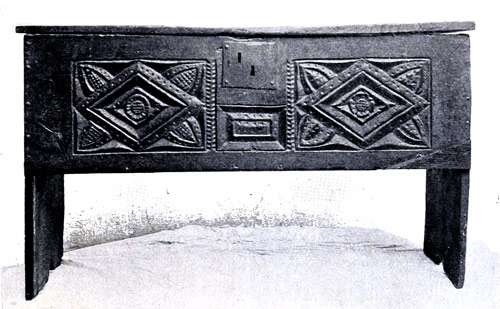
CHEST. MIDDLE SIXTEENTH CENTURY.
Gothic carving. Solid wood ends, forming feet. Made from six boards; with hand-forged nails and large lock, characteristic of Gothic chests.
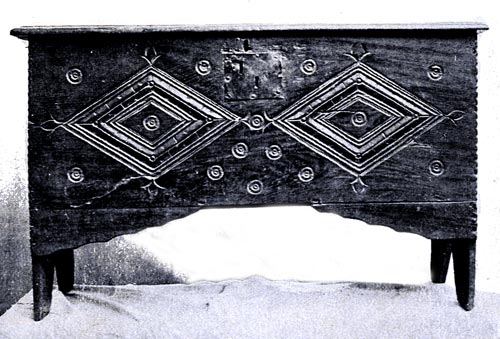
CHEST. SIXTEENTH CENTURY.
Lozenge panels, disc turning, and Gothic brackets (rare).
(By the courtesy of Mr. F. W. Phillips, Hitchin.)
Cottage and farmhouse furniture may be said to be in somewhat parallel case to English earthenware. A quarter of a century ago, or even ten years ago, collectors in general confined their attention mainly to porcelain. The rage was for Worcester, Chelsea, Derby, or Bow. With the exception of Wedgwood and Turner, the Staffordshire potters had not found favour with the fashionable collector. Nowadays Toft dishes, Staffordshire figures by Enoch Wood, vases by Neale and Palmer, and the entire school of lustre ware, have received attention from the specialist, and scientific classification has brought prices within measurable distance of those paid for porcelain.
What earthenware is to porcelain, so cottage and farmhouse furniture are to the elaborate styles made for the use of the richer classes. The French insipidities and rococo ornament of Chelsea and Derby and the oriental echoes of Worcester and of Bow are as little typical of national eighteenth-century sentiment as the ribbon-back chair and the Chinese fretwork of Chippendale or the satinwood elegances of Sheraton.
To Staffordshire and to local potteries scattered all over the country from Sunderland to Bristol, from Lambeth to Nottingham, from Liverpool to Rye, one instinctively turns for real individuality 32 and native tradition. Similarly farmhouse furniture exhibits the work of the local cabinet-maker in various districts, strongly marked by an adherence to traditional forms and intensely insular in its disregard of prevailing fashions. It is as English as the leather black-jack and the home-brewed ale.
Contemporaneous with the great cabinet-makers who drew their inspiration from foreign sources—from Italy, from France, from Holland, and from Spain—small jobbing cabinet-makers in every village and town had their patrons, and when not making wagons or farm implements, produced furniture for everyday use. As may readily be supposed, there is in these results a blind naïveté which characterises a design handed down from generation to generation. This is one of the surprising features of the village cabinet-maker's work—its curious anachronism. The sublime indifference to passing fashions is astonishingly delightful to the student and to the collector.
There is nothing more uncertain than to attempt with exactitude to place a date upon cottage or farmhouse furniture. The bacon-cupboard, the linen-chest, the gate-table, the ladder-back chair and the windsor chair, were made through successive generations down to fifty years ago without departing from the original pattern of the Charles I. or the Queen Anne period. Oak chests are found carved with the Gothic linen-fold pattern. They might be of the sixteenth century except for the fact that dates of the late eighteenth and early nineteenth century are carved upon them. Whole districts have retained similar styles for centuries, and the fondness for 33 clearly defined types is almost as pronounced as that of the Asiatic rug-weaver, who makes the same patterns as his remote ancestors sold to the ancient Greeks.
The village cabinet-maker's work knows no sequence of ages of oak, walnut, mahogany, and satinwood. His wood is from his native trees. His chairs come straight from the hedgerows. His history can be spanned in one long age of oak, intermingled here and there with elm and yew-tree and beech. The early days of primitive work go back to the marked class distinction between gentles and simples, and the end came only in the last decades of the nineteenth century, when the village craftsman was obliterated by the rapid advance of factory and machine made furniture.
It may at first be assumed by the beginner that cottage and farmhouse furniture is throughout a weak and feeble imitation of finer pieces. But this is not so. The craftsmen who made this class of furniture formed for themselves special types which were never made by the London cabinet-makers. For instance, the Jacobean gate-table, the Lancashire wardrobe, the dresser, and the windsor chair, have styles peculiarly their own. In many of the specimens found it will be seen that the village cabinet-maker displayed very fine workmanship, and there are clever touches and delightful mannerisms which make such pieces of interest to the collector.
In early days of the villeins, furniture was limited to a stool, a table, and perhaps a chest. Nor was the use of much furniture at the farm or in the cottage 34 a feature in Tudor and early Stuart days. Gorgeously carved oak and richly turned walnut filled the mansions of the wealthy, but one does not find its simpler counterpart made for cottages till nearly 1660. The few pieces essential to every dwelling-house may be placed not earlier than the late sixteenth or early seventeenth century—the chest, the table, the form, and the Protestant Bible-box.
Chests with scratched Gothic mouldings, tables of the trestle type as used to-day, forms of the most simple construction, exist, and may be said to belong to the sixteenth century.
Bible-boxes became common during the early seventeenth century, and without change in their style were made till the late eighteenth century. In mid-seventeenth-century days the well-known gate-table was introduced.
Of early pieces we illustrate a few examples, though in connection with farmhouse and cottage, the early days afford a poor field, as the furniture of those days now remaining was mostly made for great families. The two sixteenth-century chests illustrated (p. 29) are interesting as showing the early styles. The upper photograph is of a middle sixteenth-century chest, with Gothic carving and solid wood ends forming feet. This type of chest is made from six boards. The hand-forged nails show the rough joinery, and the large lock is characteristic of such Gothic chests. The lower chest is also of the sixteenth century. It has lozenge panels, and is further ornamented by disc turning. The Gothic brackets at the base are rare, and it is an interesting example.
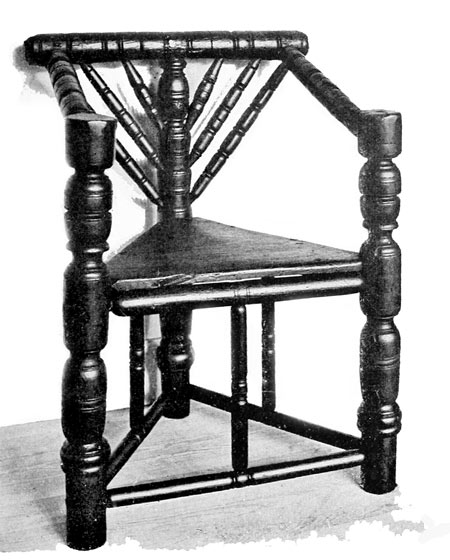
ELIZABETHAN CHAIR
This is of Scandinavian origin, and was known in England before the Roman Conquest, being shown in mediæval MSS. Such designs survived the Gothic styles.
(By the courtesy of Messrs. Phillips, Hitchin.)]
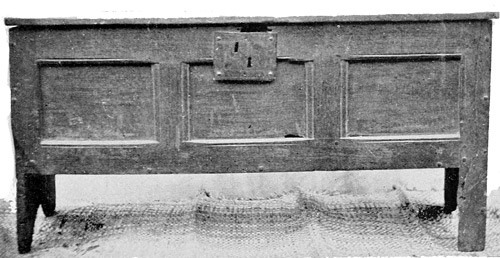
CHEST. SEVENTEENTH CENTURY.
Panels with early scratched mouldings (i.e., not mitred). Mitreing came into general use about 1600.
37 That the chest remained in somewhat primitive form is shown by the illustration of a seventeenth-century specimen (p. 35). It will be observed that the panels have early scratched mouldings, that is to say they are not mitred. The fashion of mitreing in cabinet-work came into general use about the year 1600, but minor examples of country furniture often possess scratched moulding at a much later date.
On the same page is an Elizabethan chair. This type is of exceptional interest. It has a long and proud history. They are, according to Mr. Percy Macquoid, "of Byzantine origin; their pattern was introduced by the Varangian Guard into Scandinavia, and from there doubtless brought to England by the Normans. They continued to be made until the end of the sixteenth century." These turned chairs are interesting as having spindles, which came into use at a much later period in the spindle-back chair.
With the growth of prosperity and the increased use of domestic comforts, cottage furniture becomes a wider subject. Carved oak bedsteads, simple four-posters, bacon-cupboards, linen-chests became more common. In eighteenth-century days there was quite an outburst of enthusiasm, and the small cabinet-maker gained knowledge of his craft and became ambitious. On the promulgation of Chippendale's designs he made copies in elm and oak and beech for village patrons and essayed to follow Hepplewhite and even Sheraton.
But this wave of success was followed by the competitive inroad made by factory-made cabinet-work, and during these last days the local cabinet-maker 38 adhered closer than ever to the early oak examples of his forefathers. The village craft practically came to an end in the fifties, but it was a glorious end, and it is happy that it did not survive to produce bad work of atrocious design.
The passing of cottage and farmhouse furniture may be said to be like the disappearance of dialect. The modern spirit has entered into village life, the town newspaper has permeated the country-side and disturbed the old-world repose. The lover of English folk-ways and the simplicity of rural life may echo the line of Wordsworth, "The things that I have seen I now can see no more."
In the illustrations of two interiors shown on p. 39 it will be seen how happily placed the furniture becomes when in its old home. The atmosphere of these rural homesteads is at once soothing and restful, and the pieces of furniture had an added dignity. It seems almost sacrilege to tear such relics of bygone days from their ancient resting-place. But the collector is abroad, and few sanctuaries have escaped his assiduous attention. The lower illustration shows the interior of a cottage with its original panelled walls. This cottage actually has Tudor frescoes.
The study of old farmhouse and cottage furniture has not been pursued in this country in so scientific a manner as in Sweden and in Denmark. The conservation of national heirlooms is a matter which must be speedily dealt with before they become scattered. It is a point which cannot be repeated too often. At Skansen, Stockholm, old buildings have, 41 under State supervision, been re-erected, and with their furniture they afford a practical illustration of the particular type of life of the district of their origin. At Lyngby, near Copenhagen, a series of farmhouses similarly illustrate old types of homesteads from various localities in Denmark, and from Iceland and the Faroe Islands.
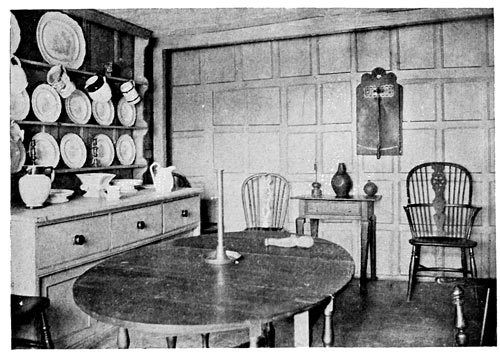
INTERIOR OF FARMHOUSE PARLOUR.
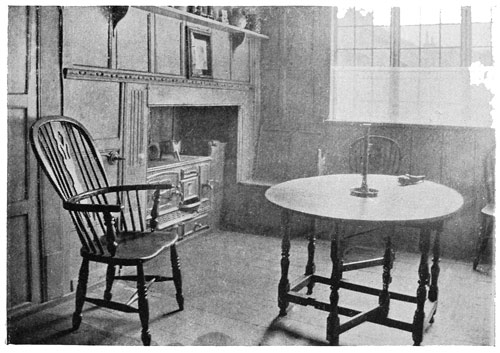
INTERIOR OF COTTAGE.
With original panelled walls. This cottage has Tudor frescoes.
By such a systematic and permanent record of farm and cottage life and the everyday art of the people it is possible to impart vitality to the study of the subject.
The English method of museum arrangement in dry-as-dust manner, with rows of furniture and cases of china, is a valley of dry bones compared with such a fresh and vigorous handling and method of exposition as is followed in Scandinavia.
If old English furniture is worth the preservation for the benefit of students of craftsmanship or as a relic of bygone customs, there is undoubted room for due consideration of the best means of exhibiting it. A series of representative farmhouses could be re-erected at some convenient spot. There are many parks around London and other great cities which would be benefited by such picturesque buildings.
Before it is too late, and many of these beautiful structures have been destroyed to make room for modern improvements, and village life has become absorbed by the growing towns, it should be possible to step in and preserve some of the most typical examples for the enjoyment of the nation. The real interest shown by the public in out-of-door object-lessons of this nature is indicated by the great 42 crowds at Exhibitions at Earl's Court and the like, which flocked to Tudor houses replete with old furniture, and villages transplanted in lath and plaster to simulate the real thing, which seemingly has been neglected from an educational point of view.
The mountain farms and the homesteads of the men of the dales, fen farms, and stone cottages from the Cotswolds, half-timbered farms from Surrey, from Cheshire, and from Hampshire, dating back to early Stuart days—are not these worthy of preservation? In the Welsh hills, and nestling in the dips of the Grampians and the Cheviots, from Wessex to Northumbria, from the Border country to the extremity of Cornwall, from East Anglia to the Lakes, are treasures upon which the ruthless hand of destruction must shortly fall. Or far afield in Harris and in Skye, or remote Connemara, there are types which should find a permanent abiding place as national records of the homes of the men of the island kingdom.
This should not be an impossible nor unthinkable problem to solve before such are allowed to pass away. The intense value of such a faithful record is worthy of careful consideration by the authorities, either as a national undertaking or under the auspices of one of the learned societies, such as the Society of Antiquaries, or the Society for the Protection of Ancient Buildings and Monuments, interested in the safeguarding of the national heritage bequeathed us by our forefathers.
JAMES I. (1603-25)
1606 Second colonisation of Virginia begun; Raleigh's first colony in Virginia was founded in 1585.
1611 The colonisation of Ulster begun.
Publication of the Authorised version of the Bible.
1620 The sailing of the Mayflower and the foundation of New England by the Puritans.
CHARLES I. (1625-49)
1630 John Winthrop and a number of Puritans settle in Massachusetts.
1633 Reclamation of forest lands.
1634 Wentworth introduces flax cultivation into Ireland.
1635 Taxes for Ship Money levied on inland counties.
1637 John Hampden, a country gentleman, refuses to pay Ship Money.
CIVIL WAR (1642-49)
1642 Battle of Edgehill. Formation of Eastern Association. Norfolk, Suffolk, Essex, Cambridge, and Hertford unite for purpose of defence against the Royalists.
1643 Battles of Reading, Grantham, Stratton, Chalgrove Field, Adwalton Moor (near Bradford), Lansdown, Roundway Down, Bristol, Gloucester, Newbury, Winceby, Hull.
1644 Battles of Nantwich, Copredy Bridge, Marston Moor, Tippermuir, Lostwithiel, Newbury.
1645 Battles of Inverlochy, Naseby, Langport, Kilsyth, Bristol, Philiphaugh, Rowton Heath.
1648 Battles of Maidstone, Pembroke, Preston, Colchester.
THE COMMONWEALTH (1642-58)
1649 Battle of Rathmines. Storming of Drogheda and Wexford by Cromwell.
1650 Montrose defeated at Corbiesdale and executed. Battle of Dunbar.
1651 Battle of Worcester.
1652 War with Holland.
1656 War with Spain.
1657 Destruction of Spanish fleet by Blake.
1658 Battle of the Dunes. Victory of English and French fleet over Spain.
INTERREGNUM (1658-60)
1659 Rising in Cheshire for Charles.
CHARLES II. (1660-85)
1672 The stop of the Exchequer. Charles refuses to repay the principal of the sums he had borrowed and reduces interest from 12 per cent. to 6 per cent. This resulted in great distress, felt in various parts of the country.
JAMES II. (1685-88)
1685 Insurrection of Argyll in Scotland.
Monmouth rising in West of England.
Revocation of Edict of Nantes. The expulsion
of a large
number of French Protestant
artisans. Settlement of skilled silk-weavers
and others in England.
WILLIAM III. AND MARY (1689-94)
WILLIAM III. (1689-1702)
1689 Siege of Londonderry.
1690 Battle of the Boyne. William defeats James, who flees to France.
48 1691 Capitulation of Limerick; 10,000 Irish soldiers and officers joined the service of the French King.
1692 Battle of La Hogue, French fleet destroyed.
CHAPTER II
SEVENTEENTH-CENTURY STYLES
Typical Jacobean furniture—Solidity of English joiners' work—Oak general in its use—The oak forests of England—Sturdy independence of country furniture—Chests of drawers—The slow assimilation of foreign styles—The changing habits of the people.
To the lover of old oak, varied in character and essentially English in its practical realisation of the exact needs of its users, the seventeenth century provides an exceptionally fine field. The chairs, the tables, the dower-chests and the four-post bedsteads of the farmhouse were sturdy reflections of sumptuous furniture made for the nobility and gentry in Jacobean and Elizabethan times. The designs may have been suggested by finer and early models, but the balance, the sense of proportion, and the carving, were the result of the village carpenter's own individual ideas as to the requirements of the furniture for use in the farmhouse. Obviously strength and stability were important factors, and ornament, as such, took a subsidiary place in his scheme. But, although coarse and possessing a 50 leaning towards the unwieldy, and often massive without the accompanying grandeur of the highly-trained craftsman's work, there is a breadth of treatment in such pieces which is at once recognisable. They were made for use and no little thought was bestowed on their lines, and, rightly appreciated, they possess a considerable beauty. There is nothing finicking about this seventeenth-century farmhouse furniture. There is no meaningless ornament. Produced in conditions suitable for quiet and restrained craftsmanship, contemplative cabinet-makers began to evolve styles that are far removed from the average design of furniture made to-day under more pretentious surroundings.
The gate table, with its long history and its amplification of structure and ornament, to which a separate chapter is devoted (Chapter III), is a case in point. It was extensively used in inns and in farmhouses and found itself in set definite types spread over a wide area from one end of the country to the other. Its practicability caught the taste of lovers of utility. Its added gracefulness of form, in combination with its adaptability to modern needs, has recaptured the fancy of housewives to-day. It is the happy survival of a beautiful and useful piece of ingenious cabinet-work.
To-day one finds unexpectedly a London fashion lingering in the provinces years afterwards. A stray air from a light opera or some catch-phrase of town slang is gaily bandied about as current coin in bucolic jest long after its circulation in the metropolis has ceased. The fashions in provincial furniture 51 moved as slowly. Half a century after certain styles were the vogue they crept imperceptibly into country use. In speech and song the transplantation is more rapid, but in craftsmanship, the studied work of men's hands, the use of novelty is against the grain of the conservative mind of the country cabinet-maker. Therefore throughout the entire field of this minor furniture it must be borne in mind that it is quite usual to find examples of one century reflecting the glories of the period long since gone.
Solidity of English Joiners' Work.—The love of old country furniture of the seventeenth century is hardly an acquired taste. Old oak is at once a jarring note in a Sheraton drawing-room with delicate colour scheme of dainty wallpaper and satin coverings. But as a general rule, when it is first seen in its proper environment, in an old-world farmhouse with panelled walls, and mullioned windows, set squarely on an oak floor and beneath blackened oak beams ripe with age, it wins immediate recognition as representative of a fine period of furniture. It is admitted by experts, and it is the proud boast of possessors of old oak, that the joiner's work of this style—the seventeenth century at its best—stands unequalled for its solidity and sound practical adhesion to fixed principles governing sturdy furniture fashioned for hard and continued usage. Of course, there were no screws used in those days, and little glue. The joints dovetailed into each other with great exactness and were fastened by the wooden pins so often visible in old 52 examples. The modern copyist has a fine regard for these wooden pegs. He knows that his clients set store by them, and he accordingly sees to it that they are well in evidence in his replicas. But there is yet a distinction which may be noticed between his pegs and the originals. His are accurately round, turned by machinery to fit an equally circular machine-turned hole. They tell their own story instantly to a trained eye, to say nothing of the piece of furniture as a whole, which always has little conflicting touches to denote its modernity.
As an instance of the form of the sixteenth century continuing in use until mid-seventeenth-century days the illustration of an oak table (p. 63) brings out this point. The heavy baluster-like legs, only just removed from the earlier bulbous types, and the massive treatment belong to the days of James I., and yet such pieces really were made in Cromwellian days.
The rude simplicity of much of the farmhouse furniture is indicated by the Monk's Bench illustrated (p. 53). The back is convertible into a table top. The early plainness of style for so late a piece as 1650 is particularly noteworthy. This specimen is interesting by reason of its exceptionally large back.
On the same page is illustrated a chest with two drawers underneath. This form is termed a "Mule Chest," and is the earliest form of the chest of drawers. These Cromwellian chests with drawers continued to be made in the country for a hundred years, but in more fashionable circles they soon developed into the well-known Jacobean chest of 55 drawers, the prototype of the form in use to-day. As an instance of this lingering of fashion the chest illustrated is dated 1701, quite fifty years after its first appearance as a new style.
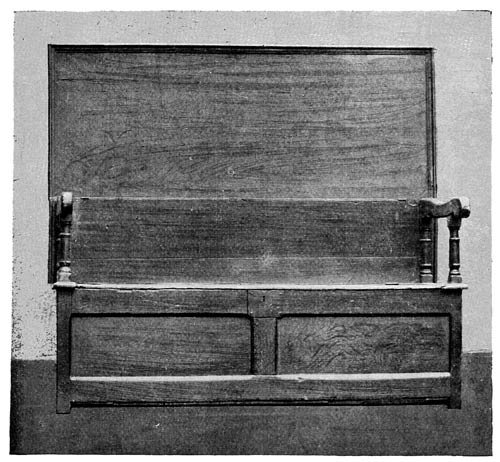
MONK'S BENCH. C. 1650.
With back convertible into table top. Exceptionally large back.
(Note early plainness of style.)
(By courtesy of Messrs. A. B. Daniell & Sons.)
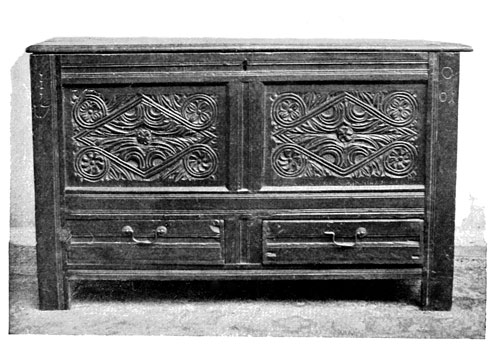
OAK CHEST WITH DRAWERS UNDERNEATH.
Termed a "Mule Chest." The earliest form of chest of drawers. This piece in style is Middle Seventeenth Century, but is dated 1701.
Oak General in its Use.—The oak as a wood was in general use both in the furniture of the richer classes and in the farmhouse furniture of seventeenth-century days and earlier. Inlaid work is unknown in furniture of this type. It was sparingly used in pieces of more important origin. The room shown at the Victoria and Albert Museum from Sizergh Castle has inlays of holly and bog oak. And the suite of furniture at Hardwicke Hall made for Bess of Hardwicke was made by English workmen who had been in Italy, the same persons who produced similar work at Longleat. Small panels with rough inlaid work are not uncommon in the seventeenth century in chests, bedsteads, and drawers. But the prevailing types of oak without the added inlays of other woods were rigidly adhered to in cabinet-makers' work for the farmhouse.
The great oak forests, such as Sherwood, furnished an abundance of timber for all domestic purposes, and up to the seventeenth century little other wood was used for any structural or artistic purpose. Practically oak may be considered as the national wood. From the Harry Grâce à Dieu of Henry VIII. and the Golden Hind of Drake to the Victory of Nelson, the great ships were of English oak. The magnificent hammer-beam roof of Westminster Hall is of the same wonderful wood. All over the country are scattered buildings timbered with oak beams, 56 from cathedrals and ancient churches to farmhouses and mills. The oak piles of old London Bridge were taken up after six centuries and a half and found to be still sound at the heart. The mass of furniture of nearly three centuries ago has survived owing to the durability of its wood. To this day English oak commands great esteem, although foreign oak has taken its place in the general timber trade, yet there is none which possesses such strong and lasting qualities. It will stand a strain of 1,900 lbs. per square inch transversely to its fibres.
Sturdy Independence of Country Furniture.—The hardness of the oak as a wood is one of the factors which determined the styles of decoration of the furniture into which it was fashioned. It was not easily capable of intricate carved work, even in the hands of accomplished craftsmen. The fantastic flower and fruit pieces of Grinling Gibbons and other carvers were in lime or chestnut, and the age of walnut, a more pliant and softer wood to work in than oak, was yet to come. The country maker, little versed in the subtleties of cabinet-work, contented himself with a narrow range of types, which lasted over a considerable period. This is especially noticeable in his chairs, and specimens are found of the same form as the middle seventeenth century belonging to the last decade of the eighteenth century.
The typical sideboard of the seventeenth century only varies slightly in form according to the part of the country from which it comes. The general design is always permanent. A large cupboard 59 below, two smaller ones above, set somewhat back from the front of the lower one, the sides of the upper ones sometimes canted off, leaving two triangular spaces of flat top at the ends of the bottom one. The whole is surmounted by a top shelf, supported by the upper cupboards and two boldly turned pillars. This is usually the design. The decoration is of the simplest, and presents nothing beyond the powers of the village carpenter. The mouldings are simple; there is slight conventional carving, frequently consisting of hollow flutings, and the pillars, boldly turned, are very rarely enriched by any ornament. A careful examination of such pieces is always interesting from a technical point of view. The framing of the panels is seen to be worked out by the plane, but the panels themselves more often than not have been reduced to approximate flatness with an adze. If viewed in a side light the surface is thus slightly varied, showing the differences in the planes of the various facets produced by the adze and giving an effect entirely different from the mechanical smoothing of a surface by the use of a plane.
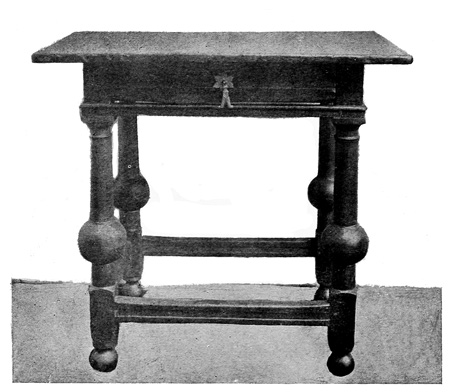
EARLY OAK TABLE. C. 1640.
Retaining Elizabethan bulbous form of leg and having Cromwellian style feet. Brass handles added later.
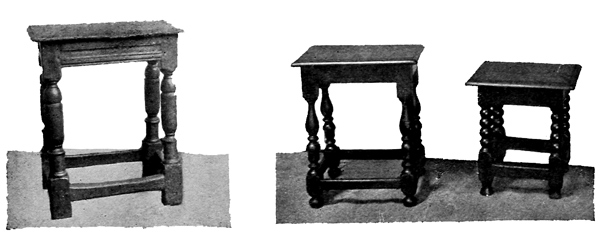
JOINT STOOLS.
Height, 1 ft. 10-1/2 ins.
(About 1640.)
Height, 1 ft. 8-1/2 ins.
Height, 1 ft. 5 ins.
(About 1660.)
The framing of the front and ends of these sideboards is in detail exactly like the ordinary Jacobean wall panelling or wainscot. The mouldings are all worked on the rails or styles, not mitred and glued on, no mitred mouldings being used except occasionally in the centre panel between the doors. The framing is mortised together and pinned with oak pins. The doors are usually hung on iron strap hinges, and the handles of the doors are of wrought iron. Frequently the doors of the upper cupboards 60 are hung on pivots, not hinges. Such a sideboard belongs to the middle period of the seventeenth century, and is representative of a wide class used in farmhouses.
It is easier to follow the various movements in the design of the seventeenth-century table than a century later, when more complex circumstances governed its use. The illustrations on p. 57 give early forms, with some suggestion as to the progression in design.
The early oak Table is a curious compound of design. It has retained the Elizabethan bulbous form of leg and has the Cromwellian foot. In date the piece is about 1640. The brass handle has been added later.
The Joint Stools on the lower half of the page afford a picture of slowly advancing invention in turned work. The one on the left of the group is the earliest, and is about 1640 in date. Its legs are seen to be of coarser work, roughly turned, but typically early Jacobean in breadth of treatment. The two on the right are about 1660 in date. The left-hand one shows the urn-shaped leg of the strong, broad treatment (as in the Table illustrated p. 63), brought into subjection and exhibiting a gracefulness of form and balance that make furniture of this type so lovable. The smaller stool shows the ball-carving associated with the Restoration period, and found in gate tables. A combination of these styles of turning is shown in the graceful oak Table illustrated p. 65, in date about 1680.
Chests of Drawers.—The conservative spirit of the minor craftsmen is especially noticeable in the articles 61 of everyday use. The merchant's account ledger with its green back and cross-stitched pattern in vellum strips, still in use, is to be found in the same style in Holbein pictures of the days of the Hanseatic League. Brass and copper candlesticks have a long lineage, and their form is only a slight variant from very early examples. The evolution of ornament is especially interesting; the old stoneware Bellarmine form still remains in the bearded mask at the lip of china jugs at the beginning of the nineteenth century. The two buttons at the back of the coattails continue long after their primary use to loop up the sword-belt has vanished.
In America the early carved chests of the Puritan colonists were followed by similar designs contemporary with our own Jacobean style for a period well towards the end of the seventeenth century. The panels on chairs and chests have the same arcaded designs as found in Elizabethan bedsteads and fireplaces. These become gradually crystallised in conventional form, and Lockwood, the American writer on old colonial furniture, has reduced the types coincident with our own Jacobean styles into ten distinct patterns, until the advent of the well-known chests of drawers with geometric raised ornament laid on, which pieces of furniture in Restoration days were set upon a stand.
We have shown in the illustration (p. 53) the earliest form of the chest with drawers underneath. The stage transitional between this and the multifarious designs with bevelled panels in geometric design is exemplified by the chest, in date about 62 1660, illustrated (p. 63), having two drawers and a centre bevelled panel, and with two arcaded panels on each side of this and also arcaded panels at the ends of the chest. This form was rapidly succeeded by the well-known chests of drawers on ball feet or on stand so much appreciated by collectors.
We illustrate a sufficient number of pieces to cover the usual styles and to assist the beginner to identify examples coming under his observation. Although it should be noted that as these chests of drawers are so much sought after they are manufactured nowadays by the hundred and out of old wood, so that great care should be exercised in paying big prices for them unless under expert guidance.
The specimen appearing on p. 65 is a fine example, in date 1660, and when the ball feet are original, as in this example, the genuineness of the chest of drawers is undoubted. Too often stands or feet are added, and it is exceedingly rare to find that the brass handles are original. Quite an industry is carried on in reproducing old brass escutcheons and handles from rare designs and carefully imparting to them signs of age, so that they may be used in made-up chests of drawers and tables.
Of types of stands, the two chests of drawers illustrated p. 69 are fair examples. The upper chest is a curious Jacobean type with sunk panels and having an unusually high stand. There is a suggestion that this has been added later, as the foot is eighteenth-century in character.
The lower chest is of the Charles II. type with 67 sunk panels and having the arcaded foot of that period. It will be observed that in addition to the four drawers it has a drawer at the bottom.
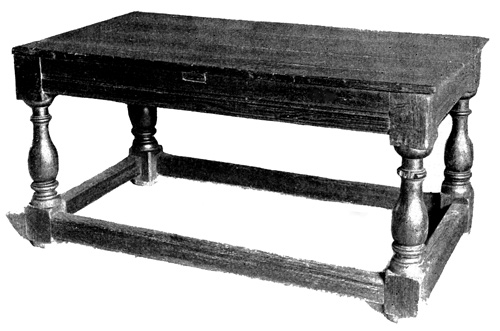
OAK TABLE. C. 1650.
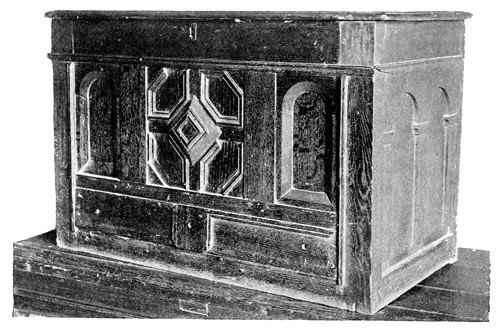
CHEST. ABOUT 1660.
With bevelled panels and drawers and arcaded panels and ends.
(By the courtesy of Messrs. Phillips, Hitchin.)
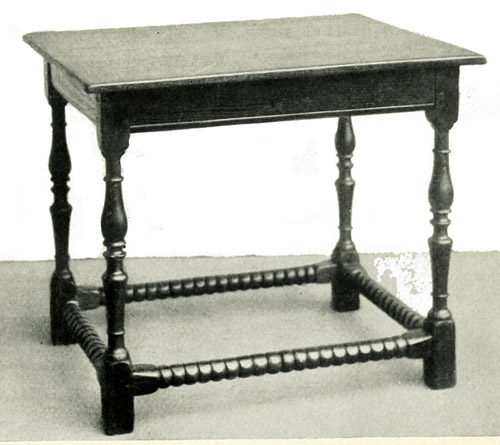
SMALL OAK TABLE. C. 1680.
Showing two forms of mouldings in legs and stretcher.
(By the courtesy of Messrs. Phillips, Hitchin.)
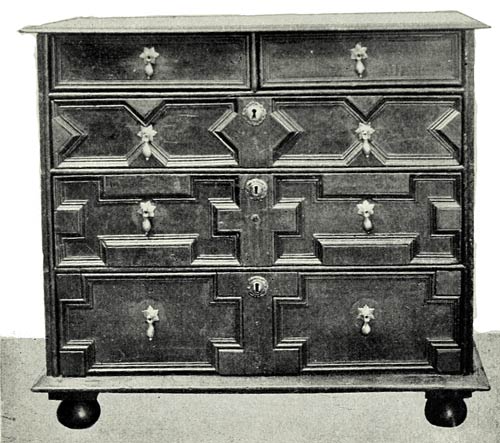
JACOBEAN CHEST OF DRAWERS. C. 1660.
Height, 2 ft. 11-3/4 ins.; depth, 1 ft. 11 ins.; width, 3 ft. 3-1/2 ins. The ball foot, not always present, indicates genuine example.
The treatment of the stand or legs of these chests exercised the ingenuity of various generations of cabinet-makers. In the specimen illustrated p. 69, the eighteenth century is reached. The transition from passing Jacobean styles into those of Queen Anne is clearly seen. The bevelled panels still remain, with added geometric intricacies of design, and a new feature appears in the fluted sides. But the most interesting feature is the cabriole leg, so definitely indicative of the eighteenth century.
The Slow Assimilation of Foreign Styles in Furniture.—Farmhouse furniture almost eschewed fashion. In seventeenth-century days it pursued the even tenor of its way untrammelled by town influences. England in those days was not traversed by roads that lent themselves to neighbourly communication. A hundred years later Wedgwood found the wretched roads in Staffordshire, where waggons sunk axle-deep in ruts and pits, a hindrance to his business, and William Cobbett in his Rural Rides leaves a record of Surrey woefully primitive at Hindhead, with dangerous hills and bogs, where the "horses took the lead and crept down, partly upon their feet and partly upon their hocks."
From the days of James I. to those of James II., from the first Stuart Sovereign to the last of that ill-starred house, the country passed through rapid stages of volcanic history. The opening years of the century saw the colonisation of Ulster by the Scots 68 and the English settlers, and the sailing of the Mayflower and the foundation of New England by the Puritans, nine years after the publication of the Authorised version of the Bible. Under Charles I. came the struggle between the despotic power of the Crown and the newly awakened will of the people. Parliamentary right came into conflict with royal prerogative. The smouldering fire burst into flame when John Hampden, a country gentleman, refused to pay Ship Money, which was levied on the inland counties in 1637, and the arrest of five members of Parliament in 1642—Hampden, Pym, Holles, Haselrig, and Strode—precipitated the country into civil war.
For seven years a continual series of battles were waged by the contending forces. The Eastern Counties formed themselves into a martial association, and the King set up his standard at Nottingham. From Bristol to Hull and from Nantwich to Newbury fierce engagements tore the country asunder. An Irish army was raised for the King, and the Scots under Leslie crossed the border in the Parliamentarian cause. With the execution of Charles I. came other dangers; the sword was not sheathed, nor had revolution left a contented country-side. Cromwell divided the kingdom into eleven military districts, and under his rule England took her place at the head of the Protestant States in Europe.
With the death of the Protector and the restoration of the Stuarts, when Charles II. returned home, came an influx of foreign customs and foreign arts learned by expelled royalists in their enforced sojourn on the Continent. London and the Court 71 instantly became the centre of voluptuous fashion. The pages of Pepys's Diary afford instructive pictures of the last quarter of the century at Whitehall with the Merry Monarch exhibited in vivid colours, and more intimate still are the word-portraits cleverly etched by the Count de Grammont in his Memoirs of the gay circle at Court. And after Charles came his brother James, nor were civil strife and Court intrigue memories of the past. Restlessness still characterises the closing years of the century. The insurrection of Monmouth in the West of England was followed by the Bloody Assize of Judge Jeffreys. The air is filled with trouble, and blundering statecraft brings fresh disaster, culminating in the ignominious flight of the King. Nor does this complete the changing scenes of the seventeenth century. A new era under William the Dutchman brought new and permanent influences, and religious toleration and constitutional government became firmly rooted as the heritage of the people of this country.
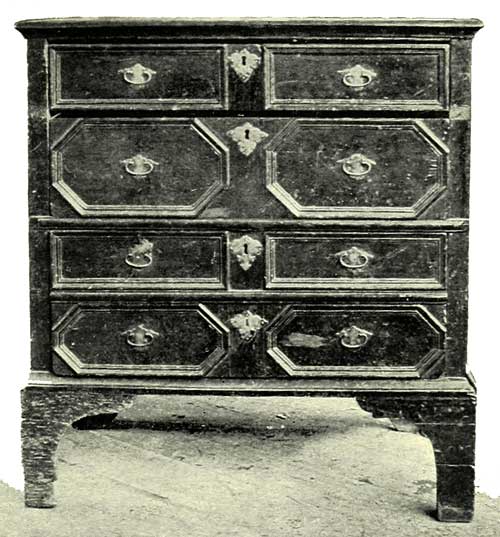
OAK CHEST OF DRAWERS.
Curious Jacobean type, with sunk panels and unusually high stand. This stand is the well-known eighteenth-century foot.
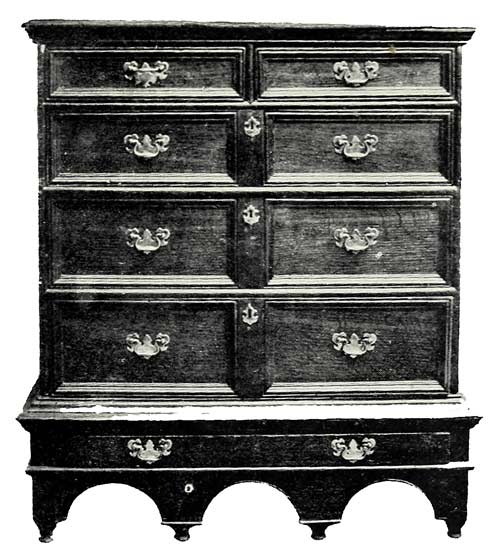
OAK CHEST OF DRAWERS.
Charles II. type, with sunk panels and arcaded stand and feet typical of the period.
It is essential that a rough idea of the period be gained in order to appreciate the kaleidoscopic character of the events that rapidly succeeded each other. The paralysis of the arts during the civil war had not a little influence on the furniture of the period belonging to the class of which we treat in this volume. The wealth of noble and patrician families had been scattered, estates had been confiscated, and sumptuous furniture and appointments pillaged and destroyed, especially when it offended the narrow tastes of the Puritan soldiery. Some of the minor pieces no doubt found their way into 72 humbler homes and served as models for simpler folk. With a dearth of aristocratic patrons there were no new art impulses to stir craftsmen to their highest moods, but in spite of war and disturbances affecting all classes, furniture for common use had to be made, and the ready-found types exercised a continued influence on all the earlier work.
In regard to farmhouse furniture the following types represent in the main the seventeenth-century styles: the bedstead, the sideboard or dresser, the table and the chair in its various forms, the Bible-box and the cradle. The Jacobean chest of drawers, a development of the dower-chest, came in mid-seventeenth-century days, and prior to the William and Mary styles. The sideboard, a development of the bacon-cupboard, came into fashion in the middle of the century. It was a reflex of the grander furniture of the manor house and the nobleman's mansion. It is difficult to fix exact dates to Jacobean furniture of this character. As a general rule it is safer to place it at a later date than is the usual custom.
The Changing Habits of the People.—The shifting phases of the restless seventeenth century make it exceedingly difficult, in spite of experts, to decide definitely as to the exact date of furniture. The country being in such an unsettled state obviously influenced the manufacture of domestic furniture. Its natural evolution was broken and the restraint of the Jacobean forms was in the main due to the conditions prevailing in regard to their manufacture. The long list of battles given in the chronological 75 table at the commencement of this chapter is advisedly recorded to show the intense upheaval which was caused by the civil wars which raged from north to south, from east to west, and convulsed any artistic impulses which may have been in process of materialisation.
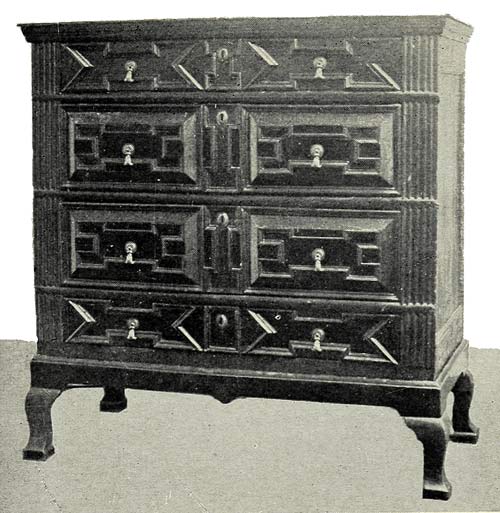
OAK CHEST OF DRAWERS.
Showing transition to Queen Anne type. Cabriole feet, bevelled panels, and fluted sides.
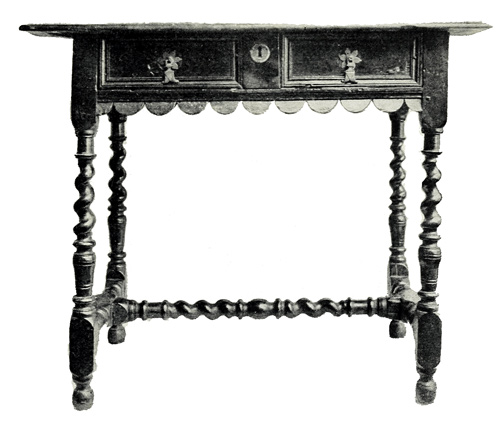
WILLIAM AND MARY TABLE. C. 1670.
With finely turned legs and stretcher and scalloped underwork.
(By the courtesy of Messrs. Phillips, Hitchin.)
It is obvious the class of Table of the William and Mary period, in date about 1670, illustrated (p. 73), with finely turned legs and stretcher and scalloped underwork, belongs to a period far more advanced in comfort than the days when such a table as that illustrated p. 63 was the ordinary type.
By the end of the century the growth of sea power and the astonishing development of trade brought corresponding domestic luxuries. The two children's stools illustrated (p. 77) must have come from a country squire's or wealthy provincial merchant's house. Their upholstered seats emulate the grandeur of finer types. The rare form of oak bedstead illustrated on the same page is a survival of the early type. In date this is about 1700; not too often are such examples found, for enterprising restorers and makers have seized these old Jacobean bedsteads and converted them into so-called Jacobean "sideboards," wherein nothing is old except the wood.
It requires some little imagination to conjure up what the daily meals were in the days of the early Stuarts. There was the leather jack, the horn mug, and the long table in the hall where the farmer and his servants ate together. An old black-letter song, entitled "When this old cap was new," in date 1666, 76 in the Roxburgh "Songs and Ballads," has two verses which paint a lively picture:—
The "mechanical man" is a delightful touch of the old song-writer. We fear he would have been shocked at the degeneracy of a later day, when in place of the mug that was handed round came the effeminate teacups. The change from ale, at breakfast and dinner and supper, to tea the beverage of the poor, would be a sad awakening from the ideals set up by the rollicking song-writer of Restoration days. But such innovations must needs be closely regarded by the student of furniture.
We wish sometimes that historians had spared a few pages from military evolutions and Court intrigues to let us know what the parlours and bedrooms of our ancestors looked like. A rough résumé from Macaulay's "State of England in 1685," 79 wherein he quotes authority by authority, holds a mirror to seventeenth-century life.
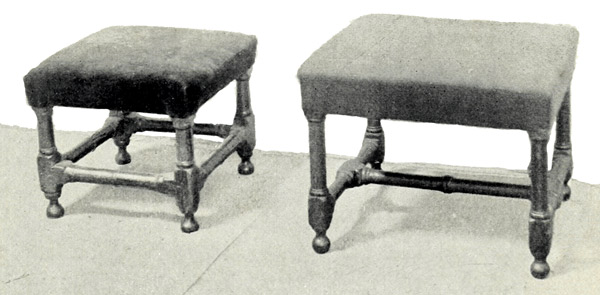
CHILDREN'S STOOLS, C. 1690.
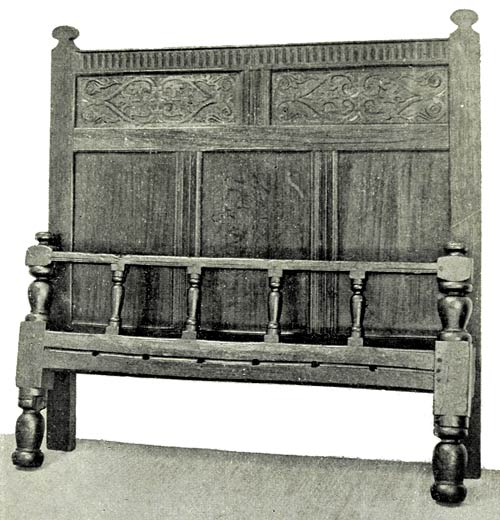
RARE BEDSTEAD. C. 1700.
Survival of early type.
At Enfield, hardly out of sight of the smoke of the capital, was a region of five-and-twenty miles in circumference, which contained only three houses and scarcely any enclosed fields, where deer wandered free in thousands. Red deer were as common in Gloucestershire and Hampshire as they are now in the Grampians. Queen Anne, travelling to Portsmouth, on one occasion, saw a herd of no less than five hundred.
Agriculture was not a greatly known science. The rotation of crops was imperfectly understood. The turnip had just been introduced to this country, but it was not the practice to feed sheep and oxen with this in the winter. They were killed and salted at the beginning of the cold weather, and during several months even the gentry tasted little fresh animal food except game and river fish. In the days of Charles II. it was at the beginning of November that families laid in their stock of salt provisions, then called Martinmas beef.
The state of the roads in those days was somewhat barbarous. Ruts were deep, descents precipitous, and the way often difficult to distinguish in the dusk from the unenclosed fen and heath on each side. Pepys and his wife, travelling in their own coach, lost their way between Newbury and Reading.[2] In some parts of Kent and Sussex none but the strongest horses could, in winter, get through the bog in which they sank deep at every step. The 80 coaches were often pulled by oxen.[3] When Prince George of Denmark visited the mansion of Petworth he was six hours travelling nine miles. Throughout the country north of York and west of Exeter goods were carried by long trains of packhorses.
The capital was a place far removed from the country. It was seldom that the country squire paid a visit thither. "Towards London and Londoners he felt an aversion that more than once produced important political effects" (Macaulay). Apart from the country gentlemen were the petty proprietors who cultivated their own fields with their own hands and enjoyed a modest competence without affecting to have scutcheons and crests. This great class of yeomanry formed a much more important part of the nation than now. According to the most reliable statistics of the seventeenth century, there were no less than a hundred and sixty thousand proprietors, who with their families made a seventh of the population of those days, and these derived their livelihood from small freehold estates.
Such, then, were the chief differences dividing the life of the country from the life of the town. The London merchants had town mansions hardly less inferior to the nobility. Chelsea was a quiet village with a thousand inhabitants, and sportsmen with dog and gun wandered over Marylebone. General Oglethorpe, who died in 1785, used to boast that he had shot a woodcock in what is now Regent Street, in Queen Anne's reign.
The days of the Stuarts were not so rosy as writers 81 of romance have chosen to have us believe. At Norwich, the centre of the cloth industry, children of the tender age of six were engaged in labour. At Bristol a labyrinth of narrow lanes, too narrow for cart traffic, was built over vaults. Goods were conveyed across the city in trucks drawn by dogs. Meat was so dear that King, in his "Natural and Political Conclusions," estimates that half the population of the country only ate animal food twice a week, and the other half only once a week or not at all. "Bread such as is now given to the inmates of a workhouse was then seldom seen even on the trencher of a yeoman or a shopkeeper. The majority of the nation lived almost entirely on rye, barley, and oats."
The change from these conditions to those we associate with the eighteenth century was not a sudden but a slow one. With the increase of average prosperity came the additional requirements in household furniture. It is impossible now to state accurately what the exact furniture was of the various classes of the community. Many of the seventeenth-century pieces now remaining have been treasured in great houses and belong to a variety which in those days was regarded as sumptuous. Now and again we catch glimpses of the former life of the men and women of those days. Little pieces of conclusive evidence are brought to light which enable safe conclusions to be drawn. But the everyday normal character has too often gone unrecorded. We are left with Court memoirs, diaries of the great, literary proofs of the more scholarly, but the simple annals of the poor are, in the main, unrecorded.
82 In view of this series of queer and remarkable facts strung together to afford the reader a rough and ready picture of those dim days, one comes to believe that much of the ordinary seventeenth-century furniture must be regarded as having belonged to the great yeoman class of the community. With this belief the collector very rightly regards it of sterling worth, as reminiscent of the men from whose sturdy stock has sprung a great race.
CHAPTER III
THE GATE-LEG TABLE
Its early form—Transitional and experimental stages—Its establishment as a permanent popular type—The gate-leg table in the Jacobean period—Walnut and mahogany varieties—Its utility and beauty contribute to its long survival—Its adoption in modern days.
The gate-leg table is always regarded with veneration by collectors. It has a charm of style and beauty of construction which afford never-ending delight to possessors of old examples. It is an inspired piece of cabinet-work which belongs to the middle of the seventeenth century, and exhibits the supreme effort of the early Jacobean craftsmen to break away from the square massive tables, the lineal descendants of the great bulbous-legged table of the Elizabethan hall. Dining-tables with the device of slides to draw out when occasion required, even in early days became a necessity. It is a note indicating the changing habits of the people. A table was no longer used for one purpose. The large table required a permanent place in a large room. But smaller 86 houses fitted with minor furniture had their limitations of space, and so the ingenuity of a table that would close together and stand against a wall, or could be used as a round table for dining, was a welcome innovation.
Its Early Form.—The series of illustrations in this chapter afford a fairly comprehensive survey of the progress and differing character of the gate-leg table during the hundred years that it held a place in domestic furniture. It is difficult to say with exactitude which are the earliest forms, or whether the round table without the moving gates was a sort of transitional form prior to the use of the movable legs. It is quite possible that in his attempt to invent something more convenient than the heavy square dining-table the progressive cabinet-maker of the middle seventeenth century did strike the half-way form. But on the other hand it must be admitted that there is the possibility that the gate-leg table came first, and that the types with three legs and half circular tops stand by themselves as later types. On the whole, one is inclined to the belief, especially as it prettily illustrates forms of natural evolution, that the three-legged table with fixed legs and half round top came first.
The two tables illustrated on p. 87 belong to this three-legged type. The upper one is half circular at the top and the three legs are stationary. This particular table is in date about 1660, and although in this instance it is obviously later than other forms we illustrate having gate-legs, yet by the theory we have advanced above, it belongs to a type prior to the 89 use of a gate. The lower one is a fine example, in date about 1640, of a triangular gate-leg table. The top is round, and the illustration shows the gate open at right angles to the stretcher. The arcaded spandrils are an interesting and rare feature.
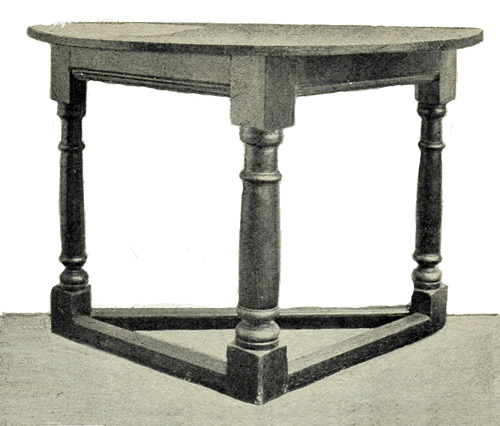
OAK SIDE TABLE. C. 1660.
Plain style. The precursor of the gate-leg table.
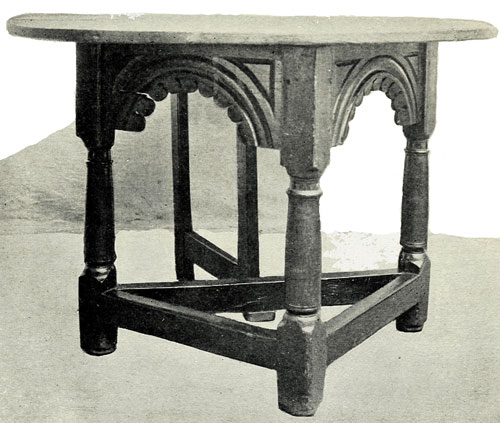
TRIANGULAR GATE-LEG TABLE. C. 1640.
Fine example. With arcaded spandrils and gate. This is the next stage of development to above table.
(By the courtesy of Messrs. Phillips, Hitchin.)
Transitional Types.—Not only is the feeling towards the gradual establishment of this new form of table shown in its construction, first with four legs until it developed into a table with twelve legs and double gates, but the styles of ornament used in the turning differ greatly in character. The leg is capable of wide and differing treatment. There is the urn leg, a rare and early type, the ball turned leg, egg-and-reel turned leg, and the straight leg. In regard to the stretcher similar varieties occur. Sometimes it is entirely plain, and when it is decoratively turned it varies from the early survival of the Gothic trestle to the rare cross stretcher of the late collapsible table. In some types of Yorkshire tables the stretchers are splat-form, like a ladder-back chair. The feet differ in no less degree from the usual Jacobean type to the scroll or Spanish foot at a later date. In the early eighteenth century there is the interesting series of Queen Anne flap tables which have gate-legs. Some have the bottom stretcher to the gate-leg. These belong to the walnut period, when a greater vivacity became noticeable in English cabinet work.
It is this picturesque and endless stream of designs which appeals to the collector. It is quite worthy of study to follow the difference in the cabinet-work of these gate tables. The long line of craftsmen who fashioned them added here and there not only 90 touches of ornament that were personal, but invented details of construction as improvements to existing forms.
A very early type with urn legs and having plain gates is that illustrated p. 91. It is small in size and belongs to the first half of the seventeenth century. The survival of the Gothic trestle feet of an earlier type is noteworthy. The table on the same page has the trestle ends still retained. There is still the single leg at each end, as in the example above. The gates are square and plain and the legs are ball turned, a combination representing an early type. The size of this piece is small and its date is about 1650 or somewhat later.
Its Establishment as a Popular Type.—The varied improvements and the slightly differing characteristics make it perfectly clear, when examined in detail, that the gate table in various parts of the country had firmly established itself and had won popular approval as a permanent type. In the search for tables of this form, however wide the net is spread by those indefatigable seekers in out-of-the-way places, and by the small army of trade collectors who scour the country for the purpose of unearthing something rare and unique, the story is always the same. In the most remote districts such tables are still found: the growth of the use of this gate-leg form permeated every part of the country. It was copied and recopied, native touches were added, and the old leading lines followed by generation after generation of craftsmen. It had as great a vogue during the long period of its history as the styles of Chippendale 95 chairs had at a later date, when every country cabinet-maker was seized with the desire to produce minor Chippendale in oak or beech or elm.
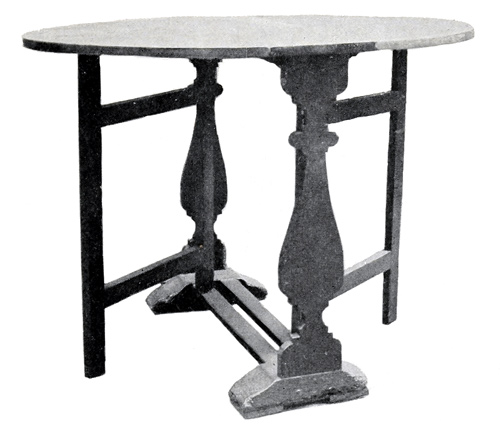
SMALL GATE TABLE. VERY EARLY TYPE.
Length, 3 ft.; breadth, 2 ft. 4 ins.; height, 2 ft. 3 ins. Urn legs with plain gates with survival of Gothic trestle feet.
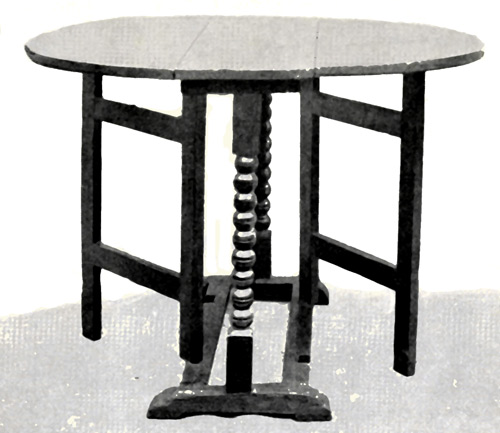
GATE TABLE. MIDDLE SEVENTEENTH CENTURY.
Early example. Height, 2 ft.; top, 2 ft. 9 ins. × 2 ft. 3 ins. Square gates and turned leg indicate early type. Trestle ends still retained.
(By the courtesy of Messrs. Phillips, Hitchin.)
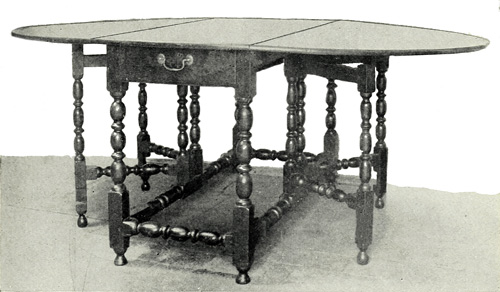
RARE TABLE.
With double gates. Egg and reel turning. Turned stretchers.
(Examples such as this are worth £18 to £35 owing to rare form.)
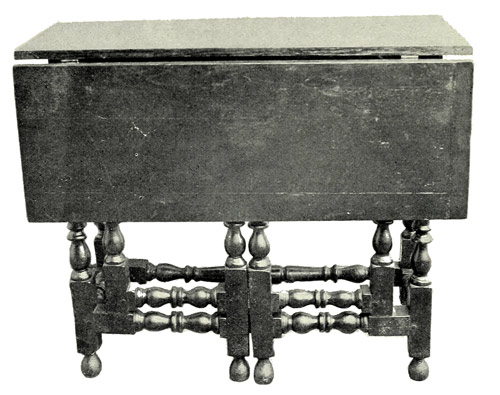
RARE GATE TABLE.
With double gates with only one flap and having turned stretchers. Tables with one flap are rare and usually have two gates.
{By the courtesy of Messrs. Phillips, Hitchin.)]
The Jacobean Period.—Essentially the flower of the popular creations of the Jacobean furniture-designer, the gate table must always stand as reminiscent of the days of Charles I. and Charles II. No picture of this period is considered artistically complete unless there be a gate-leg table with its picturesque lines adding a technical touch of correctness to interiors. The portrait of Herrick, the parson-poet of Devon, imaginative though it be, whenever it appears on canvas or illustrating his lyrics, shows the poet beside a fine gate-leg table. Stage tradition is equally sure on the same point. A company of swaggering cavaliers at an inn is not complete without a group arranged at one of these tables quaffing wine from flagons.
Without doubt the finest examples are to be found from the year 1660 to the end of the reign of Charles II. A new impetus had been given to furniture-making in Restoration days. The country had settled down in tranquillity and the domestic arts began again to thrive in natural manner following the earlier motives of the days of Charles I. The recent civil wars had arrested their development, and now they burst forth again with renewed youth.
Ripe examples of the best period may be assigned to the last three or four decades of the seventeenth century. These, it should be explained, are in oak. We illustrate (p. 93) a particularly pleasing specimen with double gates which belongs to this 96 finest period. There are, it will be observed, twelve legs, and the stretchers are finely turned with what is known as the egg-and-reel pattern. As a matter of fact pieces such as this, on account of the rare form, bring from £15 to £35, and they are rapidly being gathered into the folds of collectors.
Another rare form is shown on the same page. This, too, has double gates, and the stretchers are similarly turned. There is only one flap to this table, and it will be observed that it makes another variation from accepted styles in having a rectangular instead of a circular top. Tables with one flap are always rare, and when found they usually have two gates.
It will be seen that there are pleasant surprises in following changing forms all through the period. On p. 97 a table is illustrated with two gates on one stretcher. This in date is about 1660.
The table below, on the same page, exhibits florid turning in the legs. The stretchers across the two legs are half way up and are the Yorkshire form of splat stretcher. This type is found as early as 1660 and as late as 1750.
The difference in structure is noticeable in two tables shown on p. 99. The one has six legs and the other eight legs. The first has finely turned legs and stretchers in what is familiarly known as the "barley-sugar" pattern. Among its exceptional features are the legs being only six in number, the gates being hinged to stretcher, two legs thus being dispensed with, and the additional bar across the two central stretchers. This is a rare piece and in date is 103 about 1670. The Gate Table on the same page with eight legs is a good example of ball turning. This is a type which survived well into the eighteenth century.
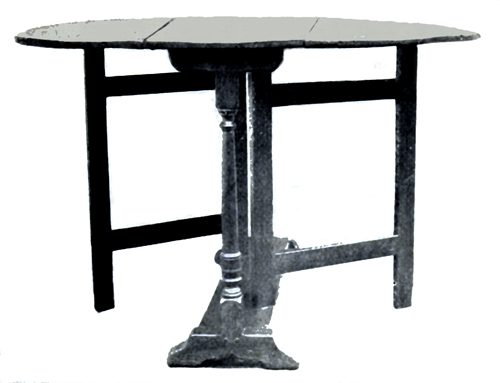
GATE TABLE. C. 1660.
Rare form. Two gates on one stretcher. Length, 3 ft. 10 ins.; width, 3 ft.
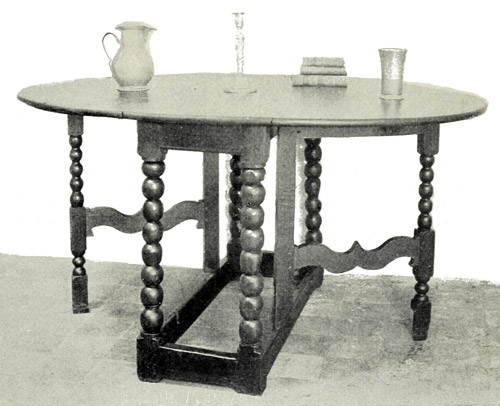
GATE TABLE.
Exhibiting florid turning and Yorkshire type of splat stretchers. Examples are found as early as 1660 and as late as 1750. Length, 4 ft. 7-1/2 ins.; width, 3 ft. 3-1/2 ins.
(By the courtesy of Messrs. Phillips, Hitchin.)
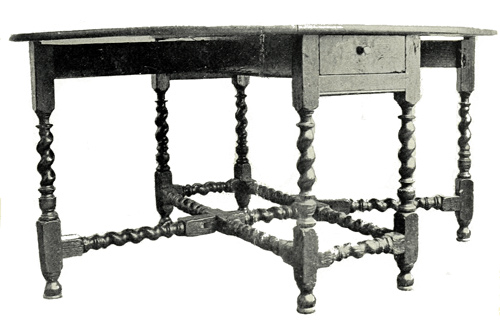
GATE TABLE.
Fine "barley sugar" turned legs and stretchers.
Exceptional features: Only six legs (gates hinged to stretcher, two legs thus dispensed with). Additional bar across two central stretchers.
Rare example. Date 1670.

GATE TABLE.
Good example of ball turning. A type which survived well into the eighteenth century.
(By the courtesy of Messrs. Phillips, Hitchin.)
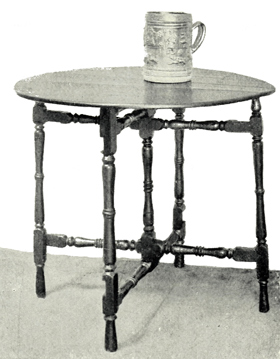
COLLAPSIBLE TABLE WITH RARE X STRETCHER. C. 1660.
The top folds over. Fine example.
(In the collection of Lady Mary Holland.)
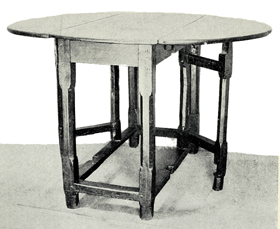
PRIMITIVE GATE-LEG TABLE. SEVENTEENTH OR EARLY EIGHTEENTH CENTURY.
Gates at one end. Made by a local carpenter or wheelwright not conversant with turning.
As exhibiting two types as wide asunder as the poles, and yet not far removed in point of time, the two tables illustrated, p. 101, make a curious contrast. The upper one, in date about 1660, is a slender, graceful example, with the unusual X-shaped stretcher. It will be seen from the illustration that the two stretchers when closed fit flat with the legs and the top flaps over, thus making the table practically collapsible.
The lower Table, of late seventeenth or early eighteenth century, is a somewhat primitive form, with the gates at one end. This has obviously been made by a local carpenter or wheelwright not conversant with turning, as the shaping of the legs is strongly suggestive of the rude fashioning of the shafts of a farm wagon.
Walnut and Mahogany Varieties.—As the mid-Jacobean period is left behind, and walnut is the chief wood used in ornamental turned work, so the character of the gate table begins to incline towards the technique more suitable to walnut than to oak. The turning, more easily done in the former wood, becomes more intricate. Hence some examples appear which are practically types of the walnut age. But, in general, the old gate-leg table is a survival throughout the William and Mary and Queen Anne periods, wherein country makers clung to the oak form and employed oak still in its manufacture.
104 The William and Mary Gate Table illustrated (p. 105) is constructed with one gate. It is small in size, practically being an ornamental or occasional table. It has a fine character, and the "barley sugar" pattern is deeply turned. Side by side with this is a small square-topped Gate Table with the pillar-leg, denoting a reversion to early type. The stretcher is of the old trestle form. Both these pieces, on account of their small size and well-balanced construction, show that considerable attention was being paid to symmetry. Such specimens can readily be transplanted to more modern surroundings, and yet in some subtle manner harmonise with later furniture.
They share this peculiarity with objects of Oriental art of the highest type. Old blue Nankin and old lac cabinets, although anachronisms amid furniture of a later date, possess the property of being in sympathy with their new environment, much in the same manner as an old Persian rug becomes a restful acquisition in a luxurious Western home.
Some of the forms are so rare as to be almost unique. It is seldom that so interesting a piece is found as the Table illustrated (p. 105) with the scroll feet in Spanish style. It has only one gate, and the top of the table lifts up, forming a box. The lock is shown at the front in the photograph. The adjacent table has a corrupted form of the Spanish foot, doubled under in cramped fashion like the flapper of a seal. This also has one gate; in date this piece is about 1680.
The days of mahogany, with Chippendale in his prime and Hepplewhite, Ince and Mayhew, Robert 107 Manwaring, Matthias Lock, William Shearer, and a crowd of others, brought intricate carving in mahogany into intense prominence. This was the golden age of furniture design. An outburst of enthusiasm, following the architectural triumphs of the Brothers Adam, wherein they raised interior decoration to a level as high as that in France, had swept over the country. In spite of the rich profusion of new design being poured out in illustrated volumes and in executed furniture, the old gate-leg table still survived. In form it was the same, but the richness of the new wood was too enticing for the cabinet-maker not to employ. Accordingly we find examples in mahogany.
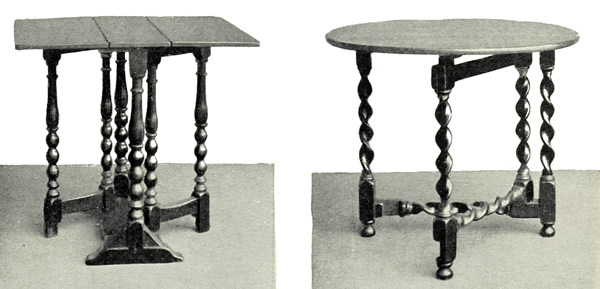
EARLY GATE TABLE.
With square top and pillar leg.
Stretcher: Old trestle form.
Top, 2 ft. 4 ins. × 1 ft. 10 ins.
WILLIAM AND MARY GATE TABLE.
Fine character deep-turning "barley sugar"
pattern with only one gate.
Top, 2 ft. 6 ins. × 2 ft.
(By the courtesy of Messrs. A. B. Daniell & Sons.)
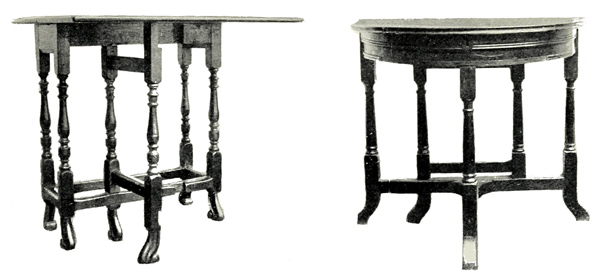
GATE TABLE WITH
SQUARE TOP. C. 1680
Having one gate and corrupted form
of carved Spanish foot.
GATE-LEG TABLE. C. 1660.
With one gate. Top lifts up to form box.
The feet are in Spanish style.
In the Chippendale period X-shaped, cluster-leg, gate tables are found, and turning was used in this cluster-leg form. The ripe inventiveness of such a design as the gate-leg table was too evident to escape the adoption by famous makers. When ingenuity of construction was at its zenith the gate-leg was not likely to be discarded in fashionable furniture.
On p. 109 two specimens of this period are shown. The upper one is of somewhat unusual type, having a Cupid's bow underframing. It is seen that the Spanish foot has still survived into the eighteenth century. The lower table is again a rare form. It is probably early in date for mahogany, being about 1740. The Spanish foot is employed, but in a coarsened form, unusually inelegant, and suggestive of a golf club.
Its Utility and Beauty.—It is a natural question that one may ask as to the reason that the gate table had 108 such a prolonged life. It passed through several strong periods of fashionable styles that were overthrown in turn by newer designs. The reason is not far to seek. It survived because the public could not do without it. There must have been a continuous demand, unchecked by the excitements of contemporary substitutes. But apparently there was nothing to take its place, or which could permanently supplant it. Its utility is undoubtedly one of its most marked features. This alone affected its stability as a possession with which the farmer's wife and the cottager would not part. Customs long established in the country were not easily discontinued. Mother, daughter, and granddaughter clung to the old and practical form of table. Nowadays there are families in the shires whom nothing would induce to sell their old gate tables. Partly this is for love of the old home, but mainly is it the common-sense attitude which rebels against the sale of any piece of furniture which is in constant use. Many objects long gone into disuse, but really valuable from an artistic point of view, are readily dispensed with. The cottager imagines that if he disposes of a mere ornament for a sum of money with which he can buy something useful he has effected a good "deal."
So much for its utility. Its beauty is a quality which has appealed to persons of higher artistic instincts. It is not the quaintness, because there are scores of other objects equally quaint, nor is it altogether the antiquity, though, of course, nowadays that is a determining factor, but it is the actual symmetry of form and ingenious form of construction, enhanced 111 by the wide range of decorative treatment, which irresistibly appeal to the lover of the beautiful. These manifold reasons, therefore, endowed the gate-leg table with great vitality. Its hold of the people was not relaxed till the age of the factory-made furniture. The banalities of the early-Victorian period, which destroyed taste in persons of finer susceptibilities than the common folk, supplanted the old historic form, and it was made no more.
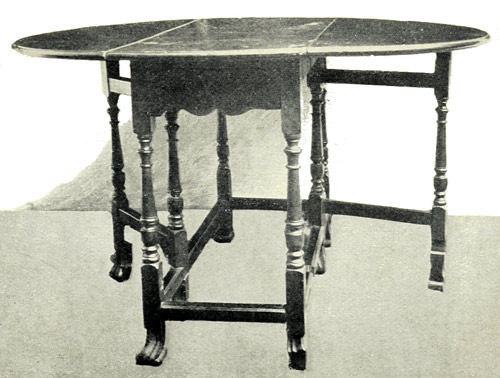
MAHOGANY GATE TABLE.
Unusual type. With "Cupid's bow" underframing. Spanish foot surviving into eighteenth century. Height, 2 ft. 5 ins.: diameter of top, 3 ft. 6 ins.; width, 4 ft.
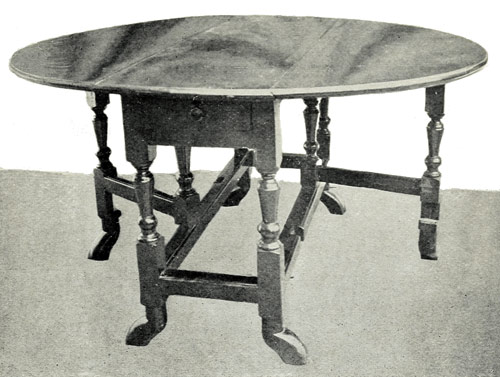
MAHOGANY GATE TABLE.
Rare form. Probably made of the new fashionable wood about 1740. Use of Spanish foot dying out. Diameter of top, 4 ft. 5-1/2 ins. × 4 ft. 4 ins.
(By the courtesy of Messrs. Phillips, Hitchin.)]
Its Adoption in Modern Days.—After William Morris and his school had preached the revival of taste and the return to the simple and the beautiful, and Ruskin with flowing rhetoric had instilled a love for homespun into men's minds, there came newer ideals which, with gradual dissemination, have grown into a great modern movement which has become so overwhelmingly popular that the pendulum has almost swung the other way. It has now become almost a truism that the person of taste to-day sees nothing good in anything that is not old. With this in view, artists and persons of advanced notions, if they could not procure the old, had copies made for them of some of the most beautiful styles suitable for modern requirements. In this there was always the great Morrisian principle in view that the highest art must show a full utilitarian purpose; so it came about that the gate table was revived and came gloriously into its own again. To-day, as in the seventeenth century, there is no more popular form of table, and the modern cabinet-maker is manufacturing hundreds of these tables.
The life-history of the gate-leg table is, therefore, 112 shown to be an interesting one. It is one of our oldest forms, and its construction nowadays, save that it is now produced in a factory, is singularly similar to that in the days when Oliver Cromwell was establishing our power as a voice in Europe, when James II. had an eye towards the supremacy of our navy, and when later our troops fought in Flanders.
CHAPTER IV
THE FARMHOUSE DRESSER
The days of the late Stuarts—Its early table form with drawers—The decorated type with shelves—William and Mary style with double cupboards—The Queen Anne cabriole leg—Mid-eighteenth-century types.
The various types of dresser associated with farmhouse use are interesting as being apart from the sideboard, a later fashion belonging to furniture of a higher type. It was not until the late days of Chippendale, and after, that the Side Table began to be designated a Sideboard, which later became a receptacle for wine, with a cellaret, and had a drawer for table-linen.
The sideboard is not a modern term, for the word is found in Dryden and in Milton. In the late eighteenth-century days the sideboard had a brass rail at the back, and was ornamented by two mahogany urns of massive proportions. Usually these were used for iced water and for hot water, the latter for washing the knives and forks.
The Adam sideboard with its severe classical lines, and Sheraton's elegant bow fronts and satinwood 116 panels decorated with painting, belong to the later developments of the sideboard as now known.
The dresser is something more homely. It is indissolubly connected with homeliness and with the farmhouse and the country-side. In its various forms it has appealed to lovers of simple furniture, and farmhouse examples have found their way into surroundings more or less incongruous. The dresser in its more primitive form requires the necessary environment. It loses its charm when placed in proximity to pieces of more pretentious character. The cupboard dresser, or the type with open shelves, is less decorative than some of the forms without the back. That is to say, it requires the exactly suitable accompaniment to prevent its simple lines from being eclipsed by furniture of a higher grade. The dresser is, therefore, especially desirable to the collector furnishing a country cottage in harmonious character; but its inclusion in the modern drawing-room is an incongruity and its presence in the dining-room is more often than not an unwarrantable intrusion.
The Days of the Late Stuarts.—It will be seen that the early types have fronts finely decorated with geometric designs panelled in the same fashion as the Jacobean chests of drawers, such as that illustrated p. 69. The split baluster ornament is a noticeable feature in this style, and the fine graceful balance of the panels with the drawers with drop brass handles is an attractive feature beloved by connoisseurs of the late Stuart period. The decoration in the fronts of these early dressers is as diverse 121 in character as the fronts of the contemporary chests of drawers. This variety is indicative of the personal character imparted to the work of the old designers. It is rare to find two examples exactly alike. They differ in details, much in the same manner as the brass candlesticks of the same period, which possess the same charm of individuality.
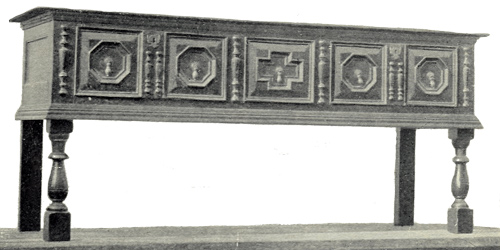
OAK DRESSER. ABOUT 1680.
With finely decorated front.
(By the courtesy of Messrs. A. B. Daniell & Sons.)
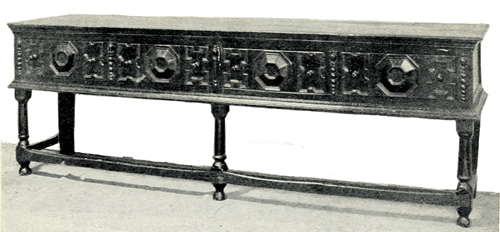
OAK DRESSER.
Fine example of the period of James II.
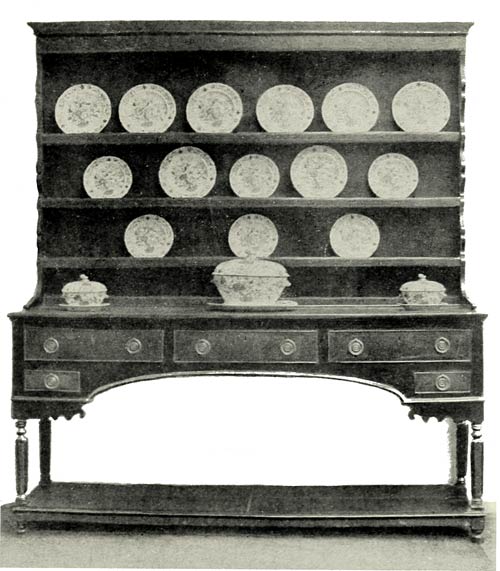
OAK DRESSER OF UNUSUAL TYPE. EARLY EIGHTEENTH CENTURY.
With arched formation below and serpentine outline at sides. Height, 6 ft. 8-1/2 ins.; depth, 1 ft. 6 ins.; width, 6 ft. 2 ins.
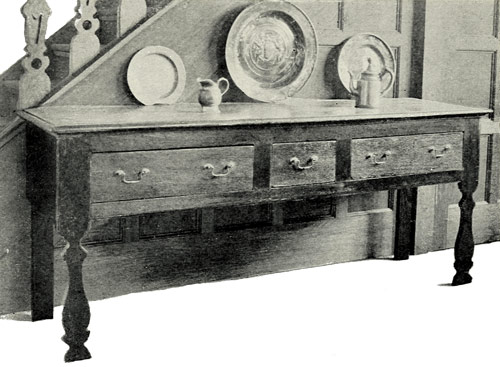
EARLY OAK DRESSER. ABOUT 1660.
With urn-shaped legs.
(By the courtesy of Messrs. Phillips, Hitchin.)]
Of this particular type of oak Dresser the two examples illustrated (p. 117) have characteristics which are common to the class. The geometric front panels, the laid-on moulding, and the Jacobean leg—in most cases the back legs of these side dressers are square—should be intently noticed. In regard to the number of the legs, this is governed by the length of the dresser. In the lower example it will be seen that there are six legs and that the stretcher is continued round three sides. In this example the legs begin to show indications of the late-Jacobean style of more delicate turning. In the upper example the legs are bolder.
These are oak specimens; the walnut varieties of similar design offer more sumptuous decoration and belong to furniture more suitable for the manor house than for the farm or cottage.
An earlier type, in date about 1660, illustrated p. 119, exhibits a less ornate appearance and has the split urn-shaped legs in front and flat legs at the back. The split legs are found sometimes in gate tables, but when such is the case it may safely be conjectured that these tables are not of English origin, as the split leg did not find great favour with the English cabinet-makers.
122 Before passing to later examples it should be observed that this particular form of dresser is most frequently found without a top with shelves. Examples there are which, as we shall show, have the original top, but as a rule it is advisable to note this feature in examining these Jacobean dressers, for there are a great number in the market to which later tops have been added, as suitable to more modern requirements, or as likely to prove more attractive to those collectors not familiar with the dresser in its earlier form. Originally in early dressers with shelves there is no back, that is to say, the shelves showed the wall behind them. This deficiency has been obligingly supplied by later hands.
The dresser, as it found itself after certain transitional stages had been passed through, is shown in the early eighteenth-century piece illustrated (p. 119). This is of the early days of the eighteenth century, that is to say, in the reign of Queen Anne. It is here seen that the dresser is a set piece of furniture possessing attributes instantly marking it as having been carefully designed with a due observance as to the purpose to which it was to be put. The shelf at the bottom was evidently intended for use; the arched formation below the drawers has been planned in that manner to admit of utensils placed there being taken out and replaced with ease. One can only conjecture what may have stood there, maybe a barrel of cider, or perhaps only a breadpan.
The Decorated Type with Shelves.—The back with shelves was a useful addition, which, as will be seen 125 in the earlier examples leading up to this later development, had borne several experiments in the way of cupboards. In this particular specimen the broken or serpentine outline at sides of shelves is a noticeable feature, and always adds a grace and charm to the dresser when employed by the cabinet-maker. Another example in which this is effectively used is illustrated on p. 123.
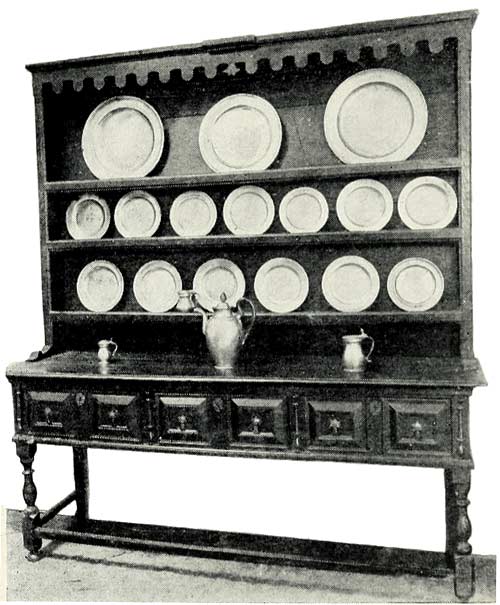
DRESSER. EARLY JACOBEAN.
Length, 6 ft. 5 ins.; height, 7 ft. 3 ins.; depth, 1 ft. 8-1/2 ins.
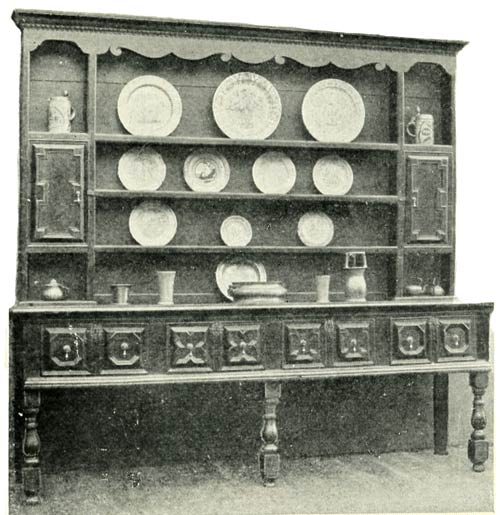
DRESSER. EARLIEST DECORATED TYPE.
Date about 1670.
(By the courtesy of Messrs. Phillips, Hitchin.)
To return to the early-Jacobean types: two interesting pieces are illustrated together (p. 123). That on the left, with four legs and stretcher, has three drawers, and the upper portion or back is ornamented by a primitive scalloped design suggestive of the country hand. The other, on the right, has six legs and four drawers, and the upper portion is beginning to receive detailed treatment in regard to spacing of the shelves, and a small cupboard on each side fills the growing need of cupboards and drawers, a rapidly growing taste in English furniture for domestic use as the home-life began to be more complex. About this time nests of boxes and drawers in lac work from the East began to be imported into this country in the better houses, first as articles of great luxury and beauty, on account of their colour and fine gold work, and later as being something new and essentially utilitarian in regard to the accommodation they afforded for the treasures the housewife wished to put away from the prying eyes of her curious neighbours. As time went on, the art of the cabinet-maker became more intricate. It is not the place here to enter into the minutiæ of the development of drawers and bureaus and cabinets, but the 126 late eighteenth century brought such furniture, apart from points in relation to beauty of design, to great constructive skill. The age was one of hidden contrivances and intricately cunning mechanism concealing secret drawers or receptacles. Such pieces were never made for farmhouse use; but the germ of the idea is ever present in all furniture with indications of locked drawers and cupboards. This is the note of intense civilisation as against the simpler modes of primitive folk who have no bolt to their door and no lock to guard their possessions.
William and Mary Style with Double Cupboards.—The variety with double cupboards are interesting as giving a date to the dressers in which they are found. It is usually accurate to place such pieces in the William and Mary period, that is to say from the year 1689 to the end of the seventeenth century. The tendency in this class of furniture is to cling tenaciously to older forms, especially in certain portions of the cabinet-work which presented difficulties to the local cabinet-maker. The legs retained their early-Jacobean character even when associated with much later styles. This is noticeable in the William and Mary example illustrated (p. 127). The arcaded doors are inlaid, the canopy is decorated, the underwork beneath the drawers belongs essentially to the "Orange" period of design in its feeling.
That the dresser could be made an ornamental piece of furniture and found its place as an important possession in the farmhouse, bright with an array of china, or pewter, or even silver, is amply shown by the two examples illustrated together of which the 129 foregoing is one. The other oak dresser has at the top, where the mugs are hanging, the original mug-hooks. It is of the square-leg type and the arcaded work below the drawers gives distinction to its lines; it possesses also the broken or serpentine ends to the shelves. These curves and simple touches of ornament all contribute to make such dressers pleasing in character and representative of native work attempting with strong endeavour to produce artistic results suitable to their environment.
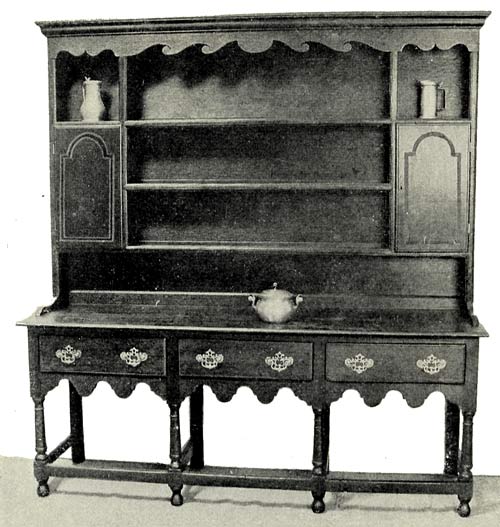
WILLIAM AND MARY OAK DRESSER. DATE C. 1689.
Decorated canopy, arcaded doors, inlaid and turned legs.
Height, 6 ft. 8-1/2 ins.; length, 6 ft. 4 ins.; depth, 1 ft. 8 ins.

OAK DRESSER.
Square leg type; with original mug hooks.
Height, 6 ft.; length, 4 ft. 3 ins.; depth, 1 ft. 5 ins.
The Queen Anne Cabriole Leg.—It is not to be expected that the long-continued triumph of the cabriole leg of the eighteenth century would leave the dresser without making its mark thereon. The exact curve of the cabriole leg is dangerous in the hands of a novice, who rarely if ever gets the correct balance in conjunction with the rest of the construction. Accordingly, in farmhouse pieces this tells its own story. It is as though the cabriole leg were a sudden afterthought. This touch of representative want of repose is shown in the specimen illustrated (p. 135). In date this is about 1740, and is a somewhat rare form, having double cupboards.
A unique Dresser and Clock combined is illustrated (p. 131). The form of the dresser, it will be seen, is quite different from other specimens. The back is only sufficiently high to carry a row of small drawers. The legs are circular and tapered, terminating in circular feet. In the centre of the dresser is a clock of the familiar grandfather form in miniature. This clock is not an addition to the dresser, but is a portion of the dresser and was made 130 with it. The illustration shows the size of the door of the clock-case, with its hinges not cut down or in any way interfered with, and the lock on the other side is in the centre of the panel. It is obvious that no later hand has tampered with this fine example, and it stands as a remarkable dresser and unique in form in its construction with this clock.
Mid-eighteenth-century Types.—In the Lancashire Dresser illustrated (p. 135) the top is reminiscent of early types. The cupboard has removed its position to the middle, a departure from all earlier forms. This is a very characteristic example, and the ample drawer accommodation shows the speedy transition from the old form of dresser through its varied stages to the later modern variety of the kitchen dresser, devoid of poetry and lacking interest to the collector, and yet to the student having traces of its ancient lineage.
The eighteenth-century farmhouse varieties offer no great departure. They aim at being capacious and massive. They make no pretensions to approach the niceties of the sideboard in use in the better houses. They supply an undoubted want in the farmhouse for storage. There were cordials and home-made wines and much prized linen and a bright array of silver and Sheffield plate and pewter, and no doubt tea services or porcelain from the new English factories of Worcester, Derby, Bow, or maybe Plymouth or Bristol, to be shielded from breakage. The farmer's wife and the farmer's daughters were less than human if they did not follow the new fashions in some degree, more or 133 less, in tea-drinking and in becoming the proud possessors of tea services and dinner services somewhat more delicate than the old delft and coarse Staffordshire ware. The cupboards had ample accommodation for these more valuable accessories of the farmhouse parlour. The cabinet-maker therefore developed on lines exactly suitable for the country clients whom he served.
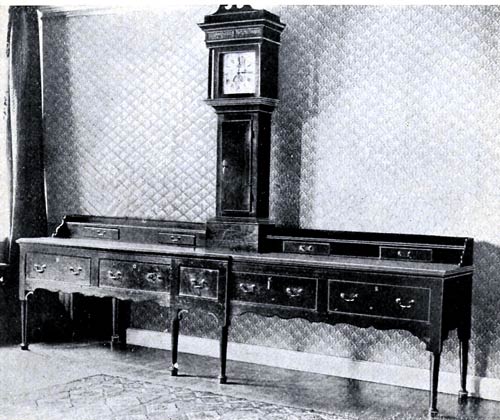
UNIQUE DRESSER AND CLOCK COMBINED.
The clock is not an addition, but is a portion of the dresser, and was made for it.
(In the collection of D. A. Bevan, Esq.)
The late forms show this marked tendency to provide innumerable drawers and cupboards, in the farmhouse dressers contemporary with Chippendale. Many examples are found which are practically elongated chests of drawers; the old characteristics of the dresser are absent, the back has disappeared altogether. There is no top with shelves. Eight large drawers and two capacious cupboards give great storage room in a piece often 9 feet in length. There is nothing finicking in this type of furniture. It stands for homely comfort and love of domestic order. We may be sure that the good dame who used this lower piece, with its eight solid drawers with sound locks, was a person of frugal habits and love of the old farmstead. We may safely assume that she had a well-filled stocking hidden away somewhere in this old-fashioned repository, put by for the rainy day.
In conclusion it may be said that a good deal has been talked about Welsh dressers, as though they were a type absolutely apart from any other. The differences are not great, as the carving, in which the Welsh craftsman offers characteristics of his own, is absent in pieces of furniture such as the dresser. Then there is the Normandy dresser, a much-abused 134 term: a considerable number of these, and others, too, from Brittany, have been imported and the terms have become trade descriptions. But in the main the English dresser has passed through the phases we have described, and the outlines herein suggested may be filled in by the painstaking collector. In the chapter dealing with local types there is an illustration of a Lancashire dresser (p. 273) which adds one more example to the gallery of dressers we give as types in this chapter.
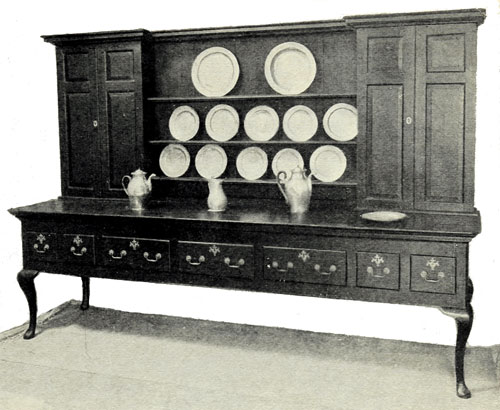
OAK DRESSER. DATE ABOUT 1740.
With early double cupboards. Legs in Queen Anne style. Height, 6 ft. 7 ins.; width, 9 ft. 5-1/2 ins.; depth, 2 ft. 2-1/2 ins.
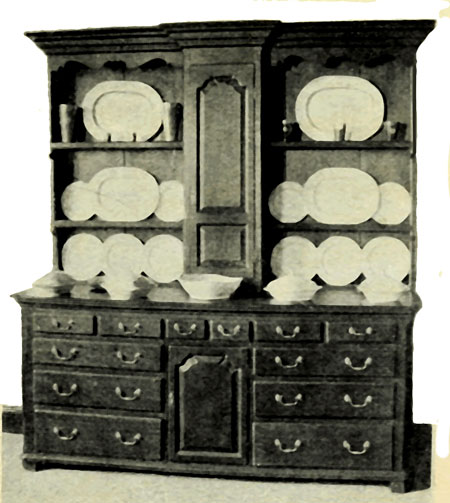
LANCASHIRE DRESSER. MIDDLE EIGHTEENTH CENTURY.
Top reminiscent of early types. Ample drawer accommodation. Transition to modern dresser. Deeply cut panels. Cupboard in middle as distinct from earlier forms at sides. Height, 7 ft. 2 ins.; width, 6 ft. 7 ins.; depth, 2 ft.
CHAPTER V
THE BIBLE-BOX, THE CRADLE, THE SPINNING-WHEEL,
AND THE BACON-CUPBOARD
The Puritan days of the seventeenth century—The Protestant Bible in every home—The variety of carving found in Bible-boxes—The Jacobean cradle and its forms—The spinning-wheel—The bacon-cupboard.
The Authorised version of the Holy Bible, "translated out of the original tongues and with the former translations diligently compared and revised," by His Majesty's command, found a place in every household in Stuart days. The letter of the learned translators "To the most High and Mighty Prince James, by the Grace of God, King of Great Britain, France, and Ireland, Defender of the Faith," &c., retains its place in modern editions. It is an historic document worthy of preservation, and perhaps those who have forgotten its terms may be glad to have their memory refreshed. It is of surpassing moment to all who recognise the Protestant derivation of the Bible as we now know it, and the sectarian feelings which inspired the translators under King James in 140 their fulsome dedication to the Modern Solomon. "Great and manifold were the blessings, most dread Sovereign, which Almighty God the Father of all mercies bestowed upon us the people of England, when first he sent your Majesty's Royal Person to rule and reign over us. For whereas it was the expectation of many, who wished not well unto our Sion, that upon the setting of that bright Occidental Star, Queen Elizabeth, of most happy memory, some thick and palpable clouds of darkness would so have overshadowed this land, that men should have been in doubt which way they were to walk; and that it should hardly be known who was to direct the unsettled State; the appearance of your Majesty, as the Sun in its strength, instantly dispelled those supposed and surmised mists, and gave unto all that were well affected exceeding cause of comfort; especially when we beheld the Government established in Your Highness and your hopeful seed, by an undoubted title, and this also accompanied by peace and tranquillity at home and abroad."
It is, as we affirm, an interesting document as showing the Puritan tendencies at a time when much was in the melting-pot and the first of the Stuarts, with his broad Scots accent and his ungainly ways, came down to St. James's from the North. Compare the above literary dedication to James the First with the word-portrait painted by Green the historian, and one may draw one's own inferences. "His big head, his slobbering tongue, his quilted clothes, his rickety legs, stood out in as grotesque a contrast with all that men recalled of Henry or of Elizabeth as his gabble 141 and rodomontade, his want of personal dignity, his buffoonery, his coarseness of speech, his pedantry, his contemptible cowardice. Under this ridiculous exterior, however, lay a man of much natural ability, a ripe scholar with a considerable fund of shrewdness, of mother-wit, and ready repartee."
The Protestant Bible in every Home.—Himself a theologian, James influenced his contemporaries. "Theology rules there," said Grotius of England only two years after Elizabeth's death. There was an indifference to pure letters and persons were counted fine scholars who were diligent in the study of the Bible. The language of the people became enriched with this study, which extended to all classes. John Bunyan, the son of a tinker at Elstow, learned his intense prose from the Bible. The peasant absorbed the Bible till its words became his own. With the Puritan movement came the production of men of serious type, and with it too came the disappearance of the richer and brighter life and humour of Elizabethan days. It was a literary movement and a religious movement which penetrated to the lower classes and often left the upper classes and gentry unmoved. In dealing with this and its reflex upon the domestic habits of the people, the visible effects in regard to furniture are strikingly evident in the plethora of Bible-boxes belonging to those in this period of Biblical study, to whom Shakespeare and Ben Jonson were unknown and Spenser's Faerie Queene and Milton's Comus were sealed books.
It would almost seem that in many cases the 142 Bible was the only book which was read and treasured. It was incorporated in the home life. It served as a register to record the names and dates of birth and death or marriage of members of the family. Some of these family registers have been most valuable in tracing details in biography where parish registers have failed to supply the necessary information.
The Variety of Carving found in Bible-boxes.—We give a series of illustrations indicating some of the interesting details of carving to be found on such boxes, where, as in work intended for a treasure-chest to preserve a sacred book, considerable zeal has gone to the elaboration of ornament. These seventeenth-century relics of a wave of religious enthusiasm are the crude Puritan likenesses, belonging to a less innately artistic race, of the tabernacles and ivory carved Madonnas and saints of the Italian renaissance. They both, though poles asunder in realisation, represent the instinctive love of man for ornament in connection with his religious emotions. Savage races with another ritual produce religious and ceremonial woodcarving representative of their best. Here, then, is the Puritan craftsmanship, mainly of provincial origin and found scattered over various parts of the country, following motifs executed by the same hands as Jacobean chairs and dressers, but bearing rich touches of ornament, betraying much originality, within the limited scope of Jacobean design.
The carving has nothing of the humour or strong bold relief of the miserere seats of the palmy days of the woodcarver in the fifteenth and early sixteenth 147 century in details that might well have been applied to the Bible-box. The ambition of the Puritan woodcarver never reached figure-work, or he might have represented Biblical scenes if his abhorrence of graven images had not demoralised his fancy. Some of the early boxes have bold carving. We illustrate a fine example (p. 143) of the time of James I., about 1600. The design is floral, which embodies the well-known conventional rose. Illustrated on the same page is another carved box of unusual pattern with floriated design. It was a frequent practice to treat the front of the box as though it were continuous and the pattern leaves off at the ends much in the same manner as modern wallpaper. In the box above it will be seen that the front is panelled and the design is confined to the circumscribed area.
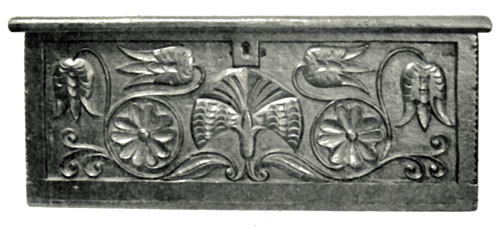
CARVED OAK BIBLE-BOX. FINE EXAMPLE. TIME OF JAMES I. ABOUT 1600.
Length, 2 ft. 4 ins.; width, 1 ft. 4 ins.; height, 11-1/2 ins.
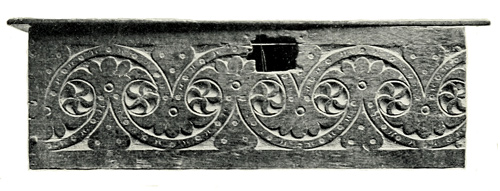
CARVED BIBLE-BOX OF UNUSUAL PATTERN.
(By the courtesy of Messrs. Phillips, Hitchin.)
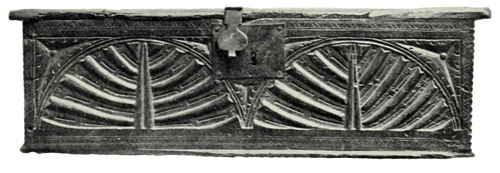
BIBLE-BOX OF VERY RARE PATTERN. ABOUT 1650.
This type always had the same kind of clasp.
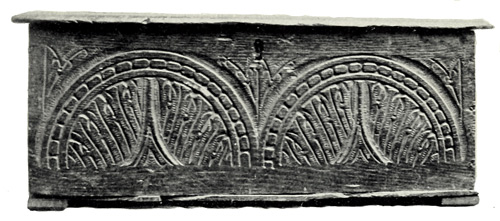
BIBLE-BOX OF USUAL PATTERN COMMONLY FOUND.
Another piece with very rare pattern, in date about 1650, has a bold type of carving in the two semicircles stretched across the front. This use of semicircles occurs in types usually found. The example illustrated (p. 145) has incised carving or "scratch." It will be seen that there is never an attempt at inlay or any of the delicacies of the refined craftsman. Among the various types of "scratch" boxes the use of circles and heart-shaped ornament is constant. The locks found on this type of box are always of the class as shown in the illustration, and the clasp is well known.
In the collection of Bible-boxes the novice must carefully learn the exact limitations of the school of woodworkers in this minor field. The touch of the foreign craftsman should be easily recognisable, with 148 its piquancy and real artistic feeling. These Puritan Bible-boxes have flat lids, and in order to give some touch of romance to them or whet the appetite of the collector they are frequently described as "lace-boxes," though it is very doubtful if such boxes were ever used for storing lace. Sometimes similar boxes with sloping lids were used as early forms of writing-desks.
The Jacobean Cradle.—The specimens of this type of furniture always exhibit, in the oak variety associated with farmhouse use, a plainness as a noticeable factor. They are usually panelled, but the panel has received no carved ornament and is especially simple. Of course they always have rockers. In the examples illustrated the slight variation in these rockers will be observed. Sometimes they are plain and sometimes they have slight ornamental curves. The only other ornament may be found in the turned knobs at the foot and sometimes at the head. Sometimes there are fine knobs on the hood.
The hood is sometimes shaped and exhibits a naïve attempt at symmetrical design. These cradles have long been familiar objects in cottagers' homes, but are now being displaced by modern wicker cradles. The picture A Flood (1870), by Sir John E. Millais, shows one of these cradles floating in a flooded meadow. The baby is crowing with delight, and a black cat sits at the foot of the cradle.
The holes in the example illustrated (p. 149) are intended to receive a cord stretched across the cradle to protect the occupant.
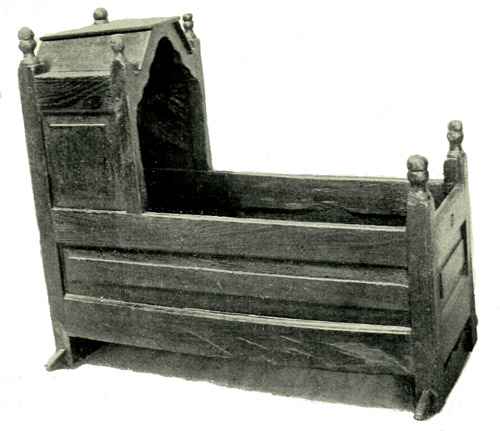
OAK CRADLE.
With shaped hood and turned knobs at head and foot.
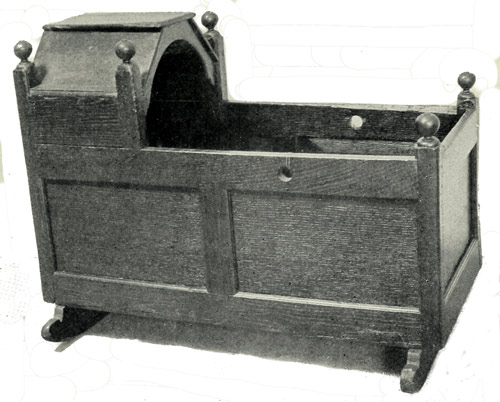
OAK CRADLE.
With shaped hood with turned ball ornaments. Holes on each side to fasten rope to protect occupant.
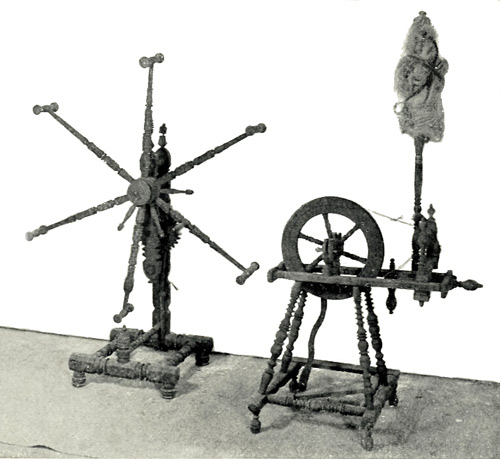
YARN-WINDER AND SPINNING-WHEEL.
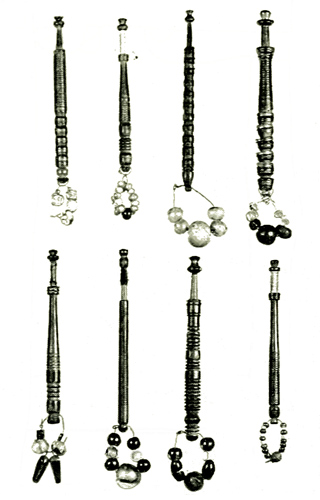
BUCKINGHAMSHIRE BOBBIN'S.
Turned wood bobbins with coloured beads to identify the bobbins from each other.
(In the collection of the author.)
The Spinning-wheel.—To this day the spinning-wheel is used in Scotland, in the Highlands. The wool or yarn winders are usually in windlass form with six spokes. The turning upon these winders and spinning wheels resembles the spindles on the spindle-back chairs. There is in Buckinghamshire bobbins a similar turning, individual in character and exhibiting considerable artistic beauty. In spinning-wheels there is considerable scope for the use of fine touches of ornament, in such practical objects dear to the housewife. Bone sometimes was used in the turned knobs. The making of these spinning-wheels was undertaken by persons desirous of winning the esteem of those who used them. Many of them have come down as heirlooms in families and have not been held as objects of art, to be regarded as curiosities, but as articles of everyday use.
The use of the spinning-wheel was not confined exclusively to the farmer's wife. In early days great ladies were adepts at spinning. By the time of George III. it was employed by the ladies of titled families. Mrs. Delany, when staying with the Duchess of Portland at Bulstrode, writes: "The Queen came about twelve o'clock, and caught me at my spinning-wheel, and made me spin on and give her a lesson afterwards; and I must say she did it tolerably for a queen." This letter, dated 1781, goes to prove two things, that spinning was a real task still undertaken by great ladies, and not a fashionable amusement. Had it been the latter Mrs. Delany would not have used the expression "caught 154 me at my spinning-wheel," wherein she indicates that the occupation was somewhat of a menial one.
In regard to the Buckinghamshire bobbins, sometimes finely carved in bone, those illustrated (p 151.) indicate the character of the cottagers' treasures in the pillow-lace-making districts. The patterns of these bobbins are not repeated. Individual touches are given to these bobbins by the village turners which are not duplicated. In use, the bobbin has to be identified by some mark, and beads of different colours are employed, which are affixed by means of a wire to the bobbin, as is shown in the illustration.
The Bacon-cupboard.—Another class which it is convenient to place among miscellaneous objects is the bacon-cupboard. The illustration (p. 231) shows the type of bacon-cupboard with seat and arms and drawers beneath. The position held by the bacon-cupboard in the farmhouse is shown by the growing dignity in the character of these cupboards. The gradual growth and development are shown in many specimens of the Queen Anne period, frequently of Lancashire origin. Such pieces, with classic pilasters, broken cornice, and bevelled panels and drawers beneath, are typified in wardrobes and dressers belonging to eighteenth-century farmhouse furniture. The development of capacious cupboards for various domestic uses is noticeable in this class of furniture up to early nineteenth-century days.
CHAPTER VI
EIGHTEENTH-CENTURY STYLES
The advent of the cabriole leg—The so-called Queen Anne style—The survival of oak in the provinces—The influence of walnut on cabinet-making—The early-Georgian types—Chippendale and his contemporaries.
The dawn of the eighteenth century practically commenced with the reign of Queen Anne. The times were troublous. As princess, in the days of William the Dutchman and her sister Mary, she was forbidden the Court as John Churchill, then Earl of Marlborough, designed to overthrow William and place Anne on the throne. "Were I and my Lord Marlborough private persons," William exclaimed, "the sword would have to settle between us."
At the death of Mary the Princess Anne, together with the Marlboroughs, was recalled to St. James's. At the death of William, in 1702, Anne came to the throne. Only just in her thirty-seventh year, she was so corpulent and gouty that she could not walk from Westminster Hall to the Abbey, and was carried in an open chair. During the Coronation 158 ceremony she was too infirm to support herself in a standing position without assistance.
The age of Anne is remarkable for its restless intrigues. Court plots were rife when Queen Anne "Mrs. Morley" in her private letters to the Duchess of Marlborough, who was "Mrs. Freeman," finally broke with the overbearing Duchess and made Abigail Hill, one of the Marlborough creatures, her chief confidant. The Protestant Whig party favoured the long war in the Low Countries and in Spain, although conducted by a Tory general, Marlborough, who, by the way, did not take the field in Flanders till he was fifty-two, a remarkable achievement for so great a military career, wherein he never fought a battle in which he was not victorious.
The greatness of Marlborough is indisputable. His fond love for his wife runs like a gold thread through the dark web of his life. His wife had, during a large part of Anne's reign, despotic empire over Anne's feeble mind. "History exhibits to us few spectacles more remarkable," says Lord Macaulay, "than that of a great and wise man who, when he had contrived vast and profound schemes of policy, could carry them into effect only by inducing one foolish woman, who was often unmanageable, to manage another woman who was more foolish still."
To us now, with the secret springs of history laid bare, there is much to marvel at, much to deplore as trivial. In regard to matters of high state and the suppleness of time-servers, memoirs and private journals have exposed many a skeleton carefully hidden from public gaze. But of the life of the 161 people, especially the life in the country districts, the picture is somewhat blurred. Men of letters flocked to the town—the town was London. Provincial life lies behind a curtain. There were Spanish doubloons coming up from Bristol and prize-money from the wars was scattered inland from the ports. Scotland was united to England by the Act of Union. "I desire," said the Queen, "and expect from my subjects of both nations that from henceforth they act with all possible respect and kindness to one another, and so that it may appear to all the world they have hearts disposed to become one people." This wish has been amply fulfilled and the union has become something more than a name. Never have two peoples different in thought, in tradition, and in established law become so completely welded together.
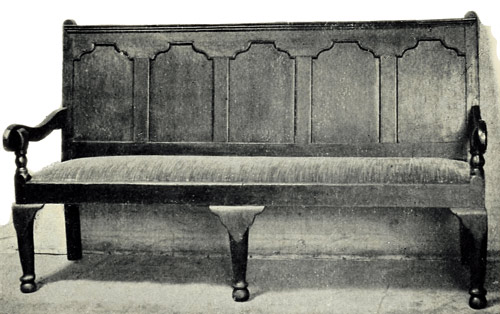
LANCASHIRE OAK SETTLE. C. 1760.
Length, 6 ft.; depth, 2 ft. 1 in.
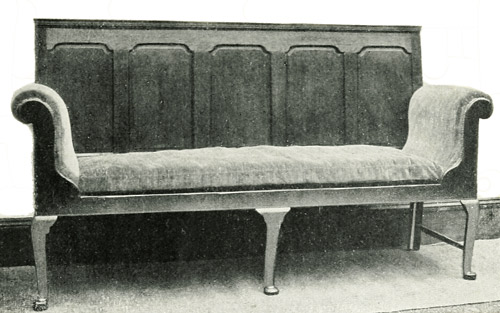
LANCASHIRE QUEEN ANNE SETTLE.
Showing transition into later type of modern settee.
(By the courtesy of Messrs. Phillips, Hitchin.)
But the war of the Spanish Succession must have drained English blood as it taxed English pockets. "Six millions of supplies and almost fifty millions of debt," wrote Swift bitterly. The tide of Marlborough's success was undoubtedly secured by the outpouring of English lives. Stalwart levies of men from the shires went to join the strange medley of the forces of the Allies commanded by Marlborough. Dutchmen, Danes, Hanoverians, Würtembergers, and Austrians jostled shoulders with each other in his troops. He launched them with calm imperturbability against his opponents at Malplaquet, for example, where with a Pyrrhic triumph he lost twenty-four thousand men against half that number of the French behind their entrenchments.
162 It is little wonder that the war was unpopular in the country, where the Spanish Succession and the "balance of power" were only symbols for so much pressure on the needs of the labouring classes. Bonfires might be lit for Blenheim, but many a village mourned those who would never return.
In spite of this intermingling of England with European politics, the general life of the people remained untouched from outside influence in regard to arts and manufacture. Cut off from intercourse with France, the grandeur of the art of Louis Quatorze was as far removed from early eighteenth-century England as though Boulle and Jean Bérain and Lepaute were in another continent and the château of Versailles in the fastnesses of the Urals. It is true that Louis XIV. presented two wonderful cabinets to the Duke of Monmouth, exquisite examples of metal inlay and coloured marquetry, but such pieces were beyond the capabilities of any English craftsman to emulate.
The chief innovations of the early eighteenth century followed the Dutch lines familiarised in the preceding days of William and Mary. Oak remained in farmhouse and country furniture, but in the fashionable world walnut was extensively used, and occasionally mahogany. Corner cupboards were introduced early in the reign of Anne, and hooped chairs, familiar in engravings of Flemish interiors, came into general use. Fiddle-splat chairs were also common in the first half of the eighteenth century. In regard to feet, the ball-and-claw, and club foot were introduced. Caning of chairs went out of 167 fashion till the end of the century. Shell and pendant ornament on knees of chair-legs became marked features, and, above all, the cabriole leg to chairs and tables is associated with the early years of the reign, and the term "Queen Anne" is always applied to such pieces.
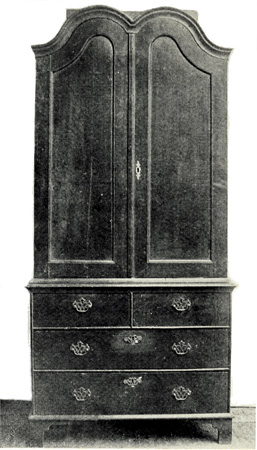
CUPBOARD WITH DRAWERS. C. 1700.
With "swan head" pediment. Pedestal at top for delft or china. Round beadings to drawers.
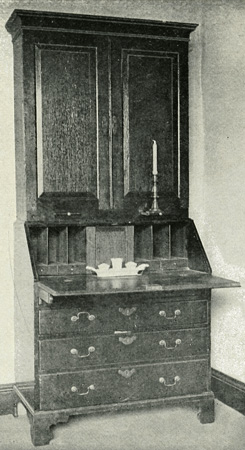
QUEEN ANNE BUREAU BOOKCASE.
Farmhouse oak variety. Emulating a finer walnut or mahogany piece.
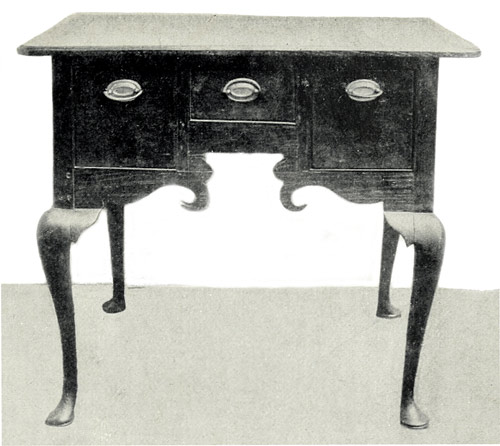
FINE EXAMPLE OAK TABLE. C. 1720.
Well-proportioned legs, club feet, original undercutting. Exemplary of professional country cabinet-maker's highest work.
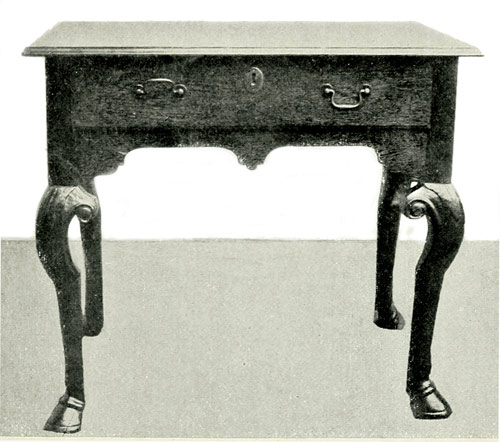
OAK TABLE. C. 1720.
With hoof feet and knee, possibly copied from a fine Queen Anne piece, exemplifying the best work of country cabinet-maker. Height, 2 ft. 7 ins.; top, 1 ft. 7-1/2 ins. × 2 ft. 3 ins.
(By the courtesy of Messrs. Phillips, Hitchin.)
The Cabriole Leg.—This form of leg, swelling into massive proportions where it joins the seat, and curving outwards and tapering to a ball-and-claw foot or a club foot, lasted till end of Chippendale period, roughly, for nearly half a century. It assumed various forms until it was supplanted by the straight leg, and the stretcher, which had disappeared with the use of the cabriole leg, again came into use.
Examples of the cabriole leg appear as illustrations to various types of furniture in this chapter. At first its use did not interfere with the employment of the stretcher, but about 1710 the stretcher disappeared. The Lancashire Queen Anne settle illustrated (p. 159) shows the stretcher joining the front leg to the back. In the settle illustrated above, in date 1760, it will be seen the stretchers have vanished.
The So-called Queen Anne Style.—Fashions slowly adopted in cabinet design do not readily arrange themselves in exact periods coinciding with the reigns of individual sovereigns. But it is convenient to affix a label to certain marked changes and attribute their general use to a particular reign. The innovation of the square panel with broken corners and ornamental curves at top is found in Queen Anne settles. The departure from the square 168 panel and line of the curved and broken top is exhibited in the second Great Seal of Anne, commemorating the Union with Scotland. It is reminiscent of the Dutch influence, and is found in Sussex firebacks of an earlier period. The straight lines of early-Jacobean cabinet-work were rapidly undergoing a change; the square wooden back of the chair was shortly to be replaced by fiddle splats, which in their turn, in late-Georgian days, became pierced and fretted and carved under the genius of Chippendale's hand.
The two settles illustrated (p. 159) show several interesting points. The panels are typical of the love of the curved line, which Hogarth defined as the line of beauty. In the upper one the arms still retain the old Jacobean form in this farmhouse example. The ball foot still clings to the earlier form. The seat is sunk to receive a long cushion. In the adjacent specimen the seat with its cushion and the curved S arms upholstered show the transition into the later type of modern settee.
The curved outline finds similar expression in the hood of grandfather clock-cases and in the shape of metal dials. A cupboard with drawers illustrated (p. 163) has what is known as a "swan head." The panels to the doors have similarly novel features in their structure. It will be observed that there is a square pedestal at the top of this piece, which was intended as a stand for a delft or Chinese jar. The drawers of this cupboard have round beadings.
The typical instance of curved design with not a single straight line, not even the back legs, which 169 are bowed, is the grandfather chair with the high back, upholstered all over. The cabriole legs with ball-and claw-feet, the C-shaped arms, the scroll upholstered wings, and the oval back, depart from the rectilinear; even the underframing of the seat is bow-shaped. Similarly, the walnut arm-chairs of the period from 1690 to 1715 had bold curves. The arms always possessed a curious scroll, the backs had broad splats with curling shoulders, and often a broad bold ribbon pattern making two loops to fill up the top of the hoop at the back, with a carved shell at the point of intersection. Big pieces of furniture, such as bureaus, had the broken arch pediment, and smaller objects, such as mirrors, had the arched or broken top; and when these dressing mirrors had small drawers, these disdained the straight front and became convex.
Under the Dutch influence, in the first period of English veneer work, from about 1675 to 1715, very fine cabinets and bureaus and chests of drawers were made. Walnut was the wood employed, with the panels inlaid with pollard elm, boxwood, ebony, mahogany, sycamore, and other coloured woods. Figured walnut was beloved by the cabinet-maker beginning to feel his way in colour schemes of decoration. Bandings of herring-bone inlay and rounded mouldings to drawers are very characteristic. Bureaus and important pieces had birds and flowers and trees or feather marquetry after fine Dutch models. Picked walnut, especially exhibiting a fine feathered figure, was used as veneer, and with these and other glorious creations of the walnut 170 school of cabinet-workers the age of walnut may be said to have been in full swing.
The Survival of Oak in the Provinces.—The foregoing descriptions apply to fashionable folks' furniture. Such fashions did not come into usage in the farmhouses and in the cottages. Oak was still employed without being displaced by the walnut of the town maker. Oak was in the main more suitable for the particular class of furniture which was likely to receive less delicate care than the writing-cabinets and bureaus and the china-cupboards of more fastidious people. Tea-drinking had become the luxury of the great world of society, and had hardly come into general use in the country till late in the reign of Anne, though by 1690 it had gained considerable favour in London. Coffee was introduced slightly earlier, and many invectives in broadsides and in poetical satires appear in the late seventeenth century against coffee and coffee-houses. In 1674 the "Women's Petition against Coffee" complained that "it made men as unfruitful as the deserts whence that unhappy berry is said to be brought; that the offspring of our mighty ancestors would dwindle into a succession of apes and pigmies, and on a domestic message a husband would stop by the way to drink a couple of cups of coffee." The prejudice against coffee, and especially against coffee-houses, was lasting, and coffee failed to establish itself as a national beverage. The labouring classes declined to be weaned from their ale and other stronger drinks. The Spaniards brought chocolate from Mexico; Roger North, Attorney-General to 175 James II., uttered a violent polemic against chocolate houses, perhaps more on account of the political clubs gathered there than against the beverage itself. "The use of coffee-houses," says he, "seems much improved by a new invention called chocolate-houses, for the benefit of rooks and cullies of quality, where gaming is added to the rest, as if the Devil had erected a new university, and those were the colleges of its professors."
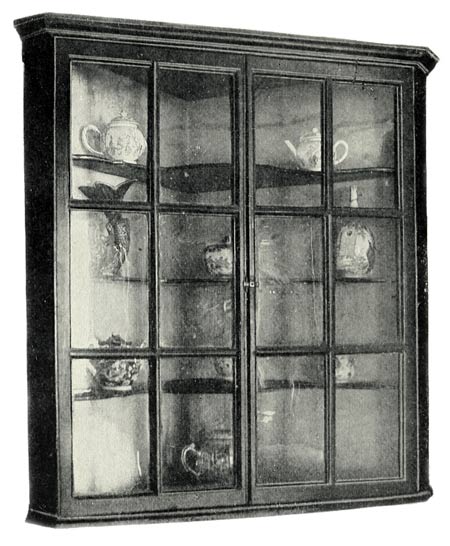
QUEEN ANNE GLASS- OR CHINA-CUPBOARD.
Spun glass doors. Heavy bars mark early type prior to tracery.
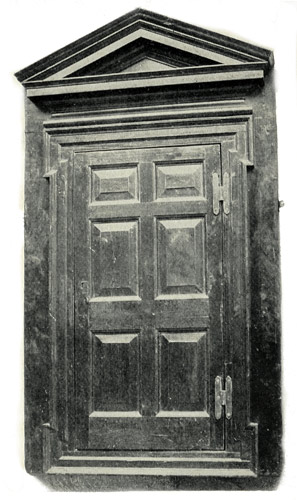
GEORGIAN CORNER CUPBOARD. LATE EIGHTEENTH CENTURY.
Broken architraves and cushion top. Having original hinges.
(By the courtesy of Messrs. Phillips, Hitchin.)
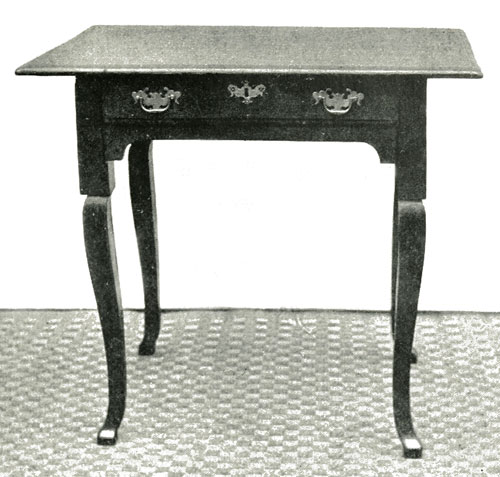
SMALL OAK TABLE. 1700-1720.
Height, 2 ft. 4-3/4 ins.; width, 2 ft. 3 ins.; depth, 1 ft. 9-3/4 ins. Graceful proportion with cabriole leg.
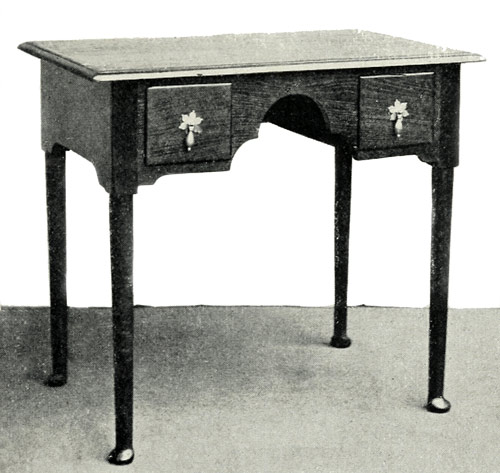
OAK TABLE.
Showing at a later period the last traces of the cabriole leg.
The varying phases of town life, of which the above quotations give a passing glimpse, found little reflex in the sturdy unchanging life of the provinces. Generation after generation, men farmed the same lands and their dependents lived in cottages adjacent; tillers of the ground, herdsmen, toilers in the fields, living by the sweat of their brow. They were content with simpler pleasures, which centred round the alehouse and the village green, or maybe the village church, if the hunting rector and the studious vicar were not too heedless of the fate of their flock. But other influences were soon to be at work to break the lethargy of those of the clergy who slumbered. Wesley founded the Methodist movement. Whitefield began his sermons in the fields and looked down from a green slope on several thousand colliers grimy from the coalpits near Bristol to see, as he preached, tears "making white channels down their blackened cheeks." Later again, Hannah More drew sympathy to the poverty and crime of the agricultural classes.
The Influence of Walnut on Cabinet-making.—If oak was the wood which the country joiner loved best, he was not without some sympathetic leaning towards 176 the effects which could be produced in the softer walnut. Such styles accordingly began slowly to have a marked influence upon the farmhouse furniture in early-Georgian days. It was not easy to produce curved lines in the refractory oak, tough and brittle, but the village craftsman essayed his best to please his patrons whose taste had been caught by the newer fashions observed in the squire's parlour when paying rare visits.
In the two examples illustrated of farmhouse cupboard and bureau bookcase (p. 163) it will be seen that here is the country maker definitely trying his skill in his native wood to emulate the finer walnut examples of town cabinet-makers. This is even more noticeable in regard to some of the tables actually found in farmhouses belonging to as early as the first quarter of the eighteenth century. The two specimens illustrated (p. 165) exemplify this tendency to imitate the designs of trained workers. The country touch always betrays itself in the cabriole leg, whether in chair or in table. The upper table has less naïveté than most examples found. There is a balance in its construction rarely found in provincial work. The legs, always the stumbling-block to the less experienced artificer, are here of exceptionally fine proportions, terminating in club feet. The lower table shows a less capable treatment of the cabriole leg. The hoof foot and the carved knee have obviously been copied from a fine Queen Anne model. In the underframing of both tables there is an experiment in ornament and form rarely attempted except in the highest flights of the country 179 maker, and as such these two fine examples must be regarded.
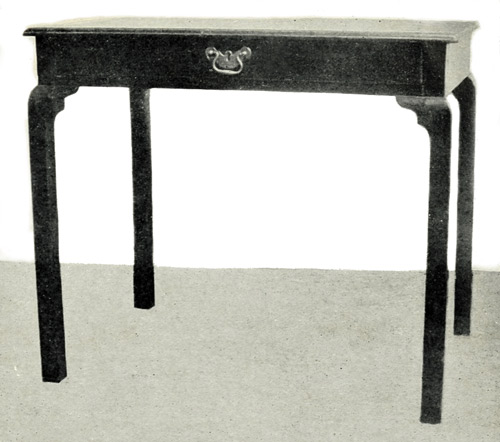
OAK TABLE.
Showing clumsy corners and indicating the naïveté of the country cabinet-maker.
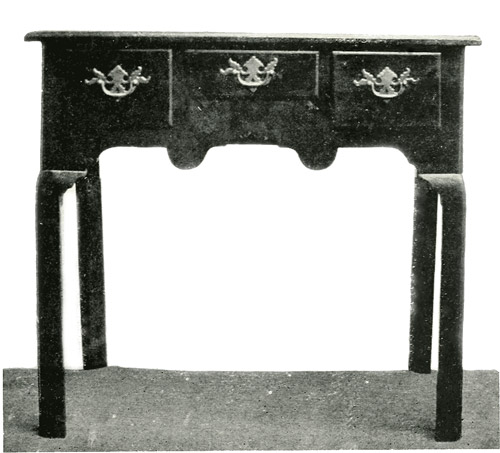
OAK TABLE.
Showing transition from cabriole leg to straight leg of 1760.
The Early Georgian Types.—Treating of the early-Hanoverian period from the death of Queen Anne in 1714, and including the reigns of George I. from 1714 to 1727 and George II. from 1727 to 1760, furniture of all types begins to assume a complexity of construction. At the final outburst the fine masterpieces of creation of the great schools of design during the last half of the eighteenth century, embodied the life-work of Chippendale, the brothers Adam, Hepplewhite, Sheraton, and many others. This period from 1750 to 1800 was the golden age of design in England. It has had a far-reaching effect, and still casts its glory upon the present-day schools of designers, whose adaptations and lines of progress are based upon the finest flower of the eighteenth-century styles.
The massive walnut chairs with deep underframing and broad hoop backs departed from the solid splats of the Anne style and endeavoured to become less squat by the employment of banded ribbon-work, coarse, heavy, and ponderous in style. Settees, arm-chairs and single chairs in this style came as the final efforts of the walnut school. The graceful ribbon designs interlacing each other in knots, and the flowing carving in mahogany of Chippendale, put a period to all dullness and heavy design. With the new style and the new wood a splendid field was opened to cabinet-makers, and the quick appreciation of these opportunities signalised their work as of permanent artistic value.
180 Among more important pieces, though still falling under the category of farmhouse styles, may be mentioned the Queen Anne glass or china cupboard, and the Georgian corner cupboard, illustrated p. 171.
The former has heavy bars, which mark the early type prior to tracery, and it has spun-glass doors. Porcelain factories at Bow, Worcester, and Derby brought such cupboards into more general use after the middle of the century. Staffordshire earthenware tea and coffee services were found in great numbers in farmhouses and cottages. After the days of delft and stoneware came the prized china services of the housewife. Pewter was largely used, but the number of ale-jugs of Toby form, or cider-mugs with rural subjects to suit the tastes of the users, indicate that more modern ideas and taste, once exclusive to the world of fashion, had penetrated the country districts.
The Georgian corner cupboard shows the broken architraves and cushion top. The hinges should be noticed as being original.
Chippendale and his Contemporaries.—At first using the cabriole leg with ball-and-claw foot, not quite as he found it, but reduced to slightly more slender proportions to be in symmetry with his less massive backs to chairs, Chippendale came to the straight line. He employed it in the legs of tables and in the seats of chairs, in the bracket supports, and in the top rail of his chairs. Chippendale in his day, made the first straight top rail to the chair. It is interesting to note the phases of changing design in country-made furniture prior to his time, and the sudden 185 mastery of form which became the common inheritance of all after his and other contemporary design-books were promulgated broadcast.
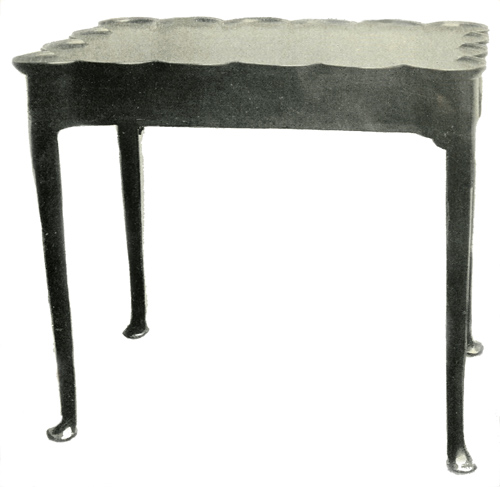
QUEEN ANNE TEA TABLE. C. 1710.
With scalloped edge for cups. Height, 2 ft. 4 ins.; depth, 1 ft. 9 ins.; length, 2 ft. 8 ins.
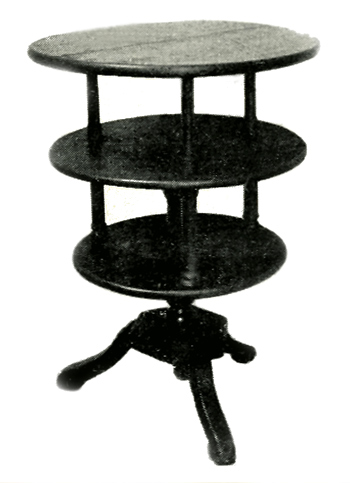
OAK REVOLVING BOOK-STAND. C. 1720.
Rare form. Diameter of top, 2 ft.; height, 2 ft. 8 ins.
(In the collection of Miss Holland.)
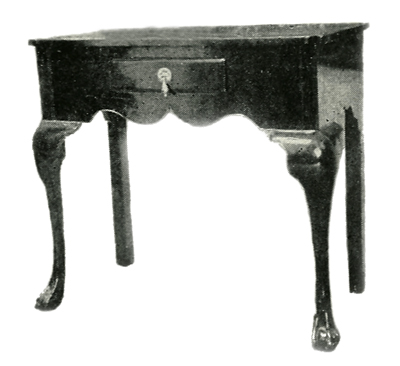
COUNTRY CHIPPENDALE TABLE.
Leg with exaggerated knee, claw, and ball foot. Accuracy in straight joinery. Failure in curved work.
Top, 2 ft. 7 ins. × 1 ft. 3 ins.; height, 2 ft. 4 ins.
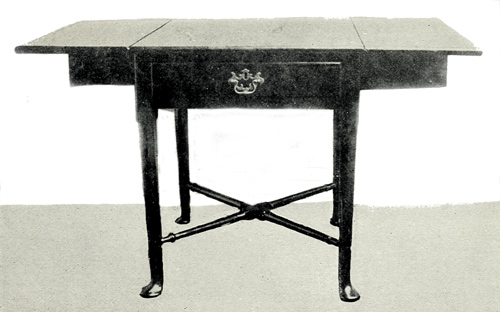
SQUARE MAHOGANY FLAP TABLE. C. 1730.
Height, 2 ft. 4 ins.; length, 3 ft. 10-1/2 ins.; width, 2 ft. 1 in. Round cross stretcher. Rare form.
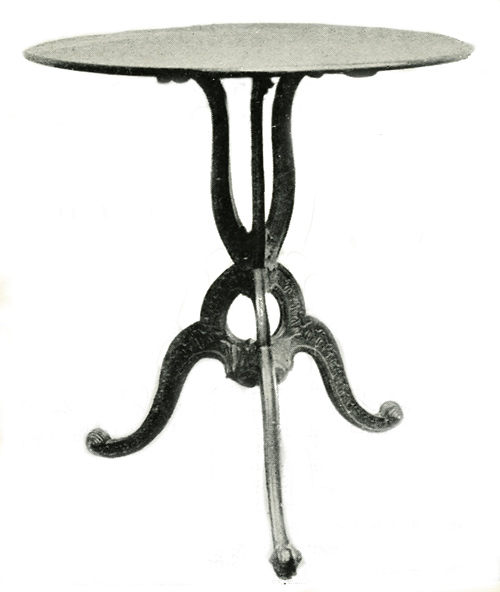
TRIPOD TABLE. C. 1760.
Chippendale style, probably unique. Elaborate rococo work.
(In the collection of Harold Bendixon, Esq.)
In the table the cabriole leg showed early signs of passing away. The two examples illustrated (p. 173) clearly indicate this. The upper one, of the time of Queen Anne, shows the cabriole leg in fine proportion under due subjection, and is a delicate example of fine cabinet-work. The lower one sees the leg losing its cabriole curve, but still rounded and still possessing the club foot.
Even more interesting are the two tables illustrated (p. 177). The country maker was slow to adopt the cabriole leg when it was fashionable, but when it became unfashionable he was equally loth to depart from his accustomed style. These clearly point to the transition between the cabriole leg and the straight leg of Chippendale, and are about 1760 in date.
The forms of design of tables of eighteenth-century date are extremely varied in character, denoting the rapidly changing habits of the people. The Queen Anne tea-table, with scalloped edges for cups, marks the note of preciosity creeping into country life. A revolving bookstand in table form, of about 1720 in date, is another rare piece. The adjacent table (p. 181) is country Chippendale. The exaggerated knee and the feeble ball-and-claw foot mark the failure of the provincial hand at curved work, accurate though he might be in straight joinery. The "Cupid's bow" underframing is interesting in combination with the rest of the design.
The tripod table offered difficulties of construction and is not often found. The example illustrated is 186 probably unique in form. In date it is about 1760, and is remarkable for the attempt at elaborate rococo work. Sometimes, though not often, mahogany was used in farmhouse examples. The table illustrated (p. 183) is an instance of the use of this wood instead of oak. It is about 1730 in date, and exhibits an unusual form in the round cross stretcher, a touch of originality by the maker. It is, as will be seen, a square-topped table with flaps.
Elaboration of a high order was happily not often attempted by the country workman, or the results with his limited experience would have been disastrous. Instead of a fine series of really good, solid, and well-constructed furniture made for practical use we should have had a wilderness of failures at attempting the impossible. A copy of a fine Chippendale side-table illustrated (p. 187) is a case in point. There is the usual want of balance in the poise of the leg, but the carving is of exceptional character. The table beneath, with its long and tapering legs, has all the characteristics of the Adam style. The beaded decoration on the legs, the classic fluting and the carved rosette claim distant relationship with the classic inventions of Robert Adam. The wood is pinewood, and as an example it is of singular interest.
The rapid survey of eighteenth-century influences bearing on the class of furniture of which this volume treats will perhaps induce the collector to scrutinise more carefully all pieces coming under his notice, with a view to arriving at their salient features in connection with the native design of more or less untutored craftsmen.
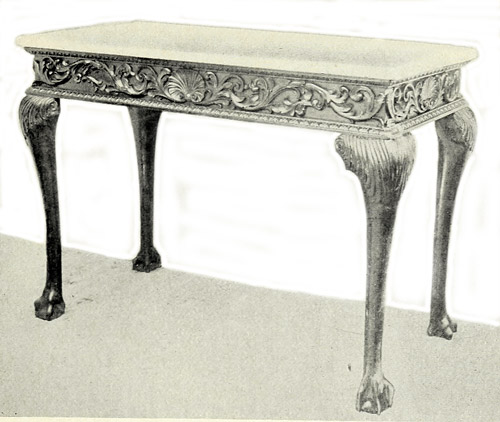
ELABORATE TABLE.
Country attempt to imitate fine Chippendale side table. Note the want of balance in leg.
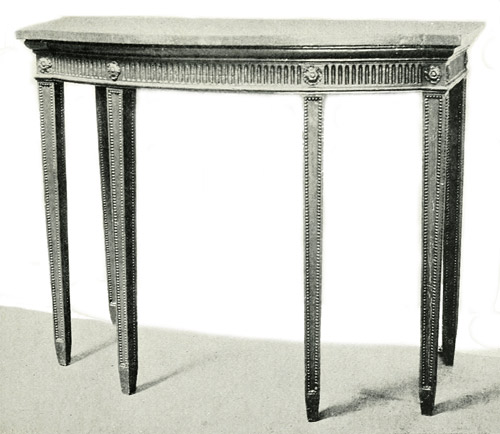
PINEWOOD COUNTRY-MADE ADAM TABLE.
Note the unusually long leg.
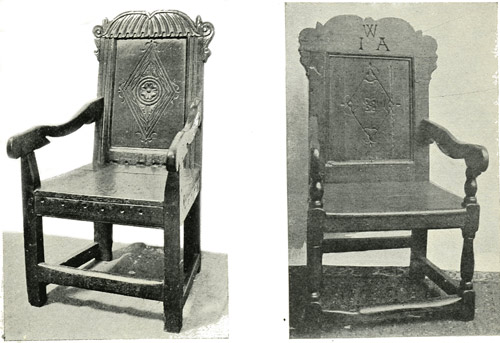
OAK ARM-CHAIR. DATE C. 1675.
With elaborate scroll back.
OAK ARM-CHAIR. DATE 1650.
With scratched lozenge.
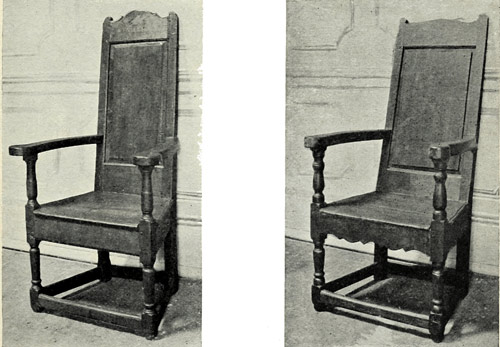
CHESTNUT ARM-CHAIR. DATE 1690.
OAK ARM-CHAIR. DATE 1690.
(By the courtesy of Messrs. Phillips, Hitchin.)
CHAPTER VII
THE EVOLUTION OF THE CHAIR
Early days—The typical Jacobean oak chair—The evolution of the stretcher—The chair-back and its development—Transition between Jacobean and William and Mary forms—Farmhouse styles contemporary with the cane-back chair—The Queen Anne splat—Country Chippendale, Hepplewhite, and Sheraton—The grandfather chair—Ladder-back types—The spindle-back chair—Corner chairs.
In order to deal exhaustively with the evolution of the chair from its earliest forms to the latest developments in sumptuous upholstery, it would be necessary to make an extended survey of furniture, dating back to early classic days. To enumerate the manifold varieties belonging to various countries and to trace the gradual progress in form, which kept pace with the advance in civilisation, would be of sufficient interest to occupy a whole volume. Man, as a sitting or lounging animal, has grown to require more elaborate forms of chair, or settee, or sofa, and the modern tendency has been towards comfort and luxury.
194 In regard to English furniture the intense contrast between the days of Elizabeth and those of Victoria is at once noticeable. According to Lord Macaulay in his comparison between the manners of his day and those of the past, the furniture of a middle-class dwelling-house of the nineteenth century was equal to that of a rich merchant in the time of Elizabeth. In general this may be true, though not as regards the spacious structure and the massive grandeur of the Tudor house. In many details the differences are most noteworthy. The wide gulf dividing the modern world from the days of the Armada may be realised by reflecting on such an astounding fact that Queen Elizabeth possessed at one time the only pair of silk stockings in her realm, which were presented to her by Mistress Montague, "which pleased her so well that she would never wear any cloth hose afterwards."
The sturdy character of the yeomen of the days of the Tudors is exhibited in their furniture. The illustrations of this chapter in regard to the chair and its structural development indicate the slowly acquired tastes, running some decades behind the fashionable furniture, strong with foreign influences, which had come into more or less general use. "England no longer sent her fleeces to be woven in Flanders and to be dyed in Florence. The spinning of yarn, the weaving, fulling, and dyeing of cloth, was spreading rapidly from the towns to the country-side. The worsted trade, of which Norwich was the centre, extended over the whole of the Eastern Counties. Farmers' wives everywhere began to spin their wool 195 from their own sheep's backs into a coarse homespun."
The rough and wattled farmhouses were being replaced by dwellings of brick and stone. The disuse of salt fish and the greater consumption of meat marked the improvement which was taking place among the countryfolk. The wooden trenchers in the farmhouses were supplanted by pewter, and there were yeomen who could boast of their silver. Carpets in richer dwelling-houses superseded the wretched flooring of rushes. Even pillows, now in common usage, were articles of luxury in the sixteenth century. The farmer and the trader deemed them as only fit "for women in child-bed." The chimney-corner came into usage in Elizabethan days with the general use of chimneys. The mediæval fortress had given place to the grandeur of the Elizabethan hall in the houses of the wealthy merchants. The rise of the middle classes brought with it in its wake the corresponding advance of the yeomen and their dependents. Visions of the New World "threw a haze of prodigality and profusion over the imagination of the meanest seaman."
Early Days.—Of farmhouse types that can authoritatively be attributed to Tudor days there are few, but the succeeding age of the Stuarts is rich with examples of undoubted authenticity. Many of them are dated, and they all bear a strong family resemblance to each other, owing to the narrow range of motifs in the carved panels. There is a fixed insularity in these early examples, and the same traditional patterns in scrollwork or in conventional 196 lozenge design retained their hold for many generations. The oak arm-chair of a farmhouse kitchen made in the days of Charles I. was still followed in close detail in the days of George III., as dated examples testify, and it would puzzle an expert, without the date to guide him, to say whether the piece was eighteenth or seventeenth century work. It may be added that as a general rule there is a marked leaning towards generosity in imparting age to old furniture. It is now very generally recognised that, like wine, it gains prestige with length of years. It therefore grows in antiquity according to the fancy of the owner or the imagination of the collector.
Among the early forms of chairs falling under the category of farmhouse furniture may be noticed examples of rough and massive build, eminently fit to serve the purpose for which they were designed. Ornament is reduced to a minimum, and they stand as rude monuments to the cabinet-maker's craft in fashioning them and following tradition to suit his client's tastes.
In regard to the sixteenth century there cannot be said to be any type falling under the heading of cottage or farmhouse chairs. We have already illustrated (p. 35) an early form of Elizabethan days, but such examples are rare. Practically cottagers had only stools in common use. It was not until about 1650 that a simplified form of the well-known variety of the chairs of the Jacobean oak period came into general use.
The Typical Jacobean Oak Chair.—The seventeenth century offers a wide field of selection, and many 199 examples exist which undoubtedly were in use in farmhouses at that period. The arm-chair illustrated p. 191, with the initials "W.I A.", is evidently made for the farmhouse. It is noticeable for its complete absence of ornamental carving except a thinly scratched lozenge. In date this is from 1650 to 1700, and if made for a wealthier person at that date it would be richly carved. The adjacent chair shows the next advance in type. It is a superior farmhouse chair of the period. It has a carved top with scroll cresting. The holes in the seat, it should be observed, originally held ropes, upon which a cushion was supported. The wooden seat is an addition made in the eighteenth century.
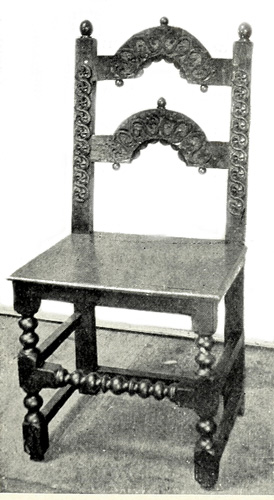
YORKSHIRE CHAIR. DATE 1660.
Late example, with ball turning in stretcher.
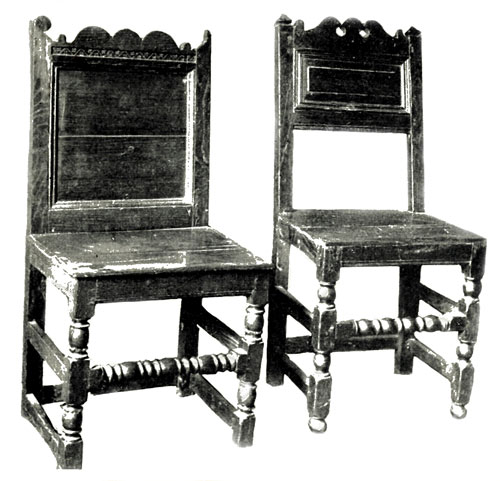
CROMWELLIAN CHAIRS. DATE 1660.
With indication of transition to Charles II. period.
(By the courtesy of Messrs. Phillips, Hitchin.)
The two other chairs illustrated on the same page are later examples, in date about 1690. One of these is fashioned of chestnut. The form of these backs is related to the contemporary high-back cane chairs of the time of Charles II. and James II. But these fashions influenced the proportions only of farmhouse chairs. In arriving at the date of such specimens as these the bevelled panel is an important factor in determining the late period.
Cushions had no place in the effects of the farmhouse in early days, although ropes were sometimes used to support cushions, as we have shown. But as a general rule the wooden seats show tangible signs of rough usage of centuries, and the stretcher has its worn surface marked by generations of owners who found it protective against the cold flagged or rush-strewn floor and the draughts in days prior to carpets and rugs.
200 The Evolution of the Stretcher.—In making a study of the evolution of the chair the stretcher is an important factor. For obvious reasons, as explained above, no early chairs were made without the stretcher across the front, a good sound serviceable piece of British oak to stand rough wear and tear. Gradually, keeping time with the march of comfort, the front stretcher begins to leave its old position near the floor, and in later examples it is half-way up the front legs. It still had a use, and a very important one: it added considerable strength and solidity to the chair, and is nearly always found in chairs intended for use. In the series illustrated herein there are only few examples without the front stretcher. Later it took another form, as the illustrated specimens in this chapter show: it united the two side stretchers, and crossed the chair underneath in the centre at right angles to the side stretchers. Its purpose in adding stability to this class of furniture was evidently never lost sight of.
At first strictly utilitarian, the stretcher was a solid foot-rest; later, when partly utilitarian in adding to the strength, it became suitable for ornamentation, Although in the class of furniture here under review such ornament never took an elaborate form, there are examples slightly differing in character from chairs intended for the use of the wealthier classes, and these are evidently a local effort to keep in touch with prevailing taste.
Finely turned stretchers, such as are found in gate tables, are a feature of a certain class of local chairs, such as those illustrated on p. 197. This kind of 203 chair without arms is rather more decorated and conforms more to the styles of furniture made for higher spheres than the farmhouse. The upper chair with its light open back and ornate decoration is a Yorkshire type, and the ball turning in the stretcher shows the transition period to Charles II. The other two are Cromwellian chairs, but showing indications of the next period. In date they are all three about 1660.
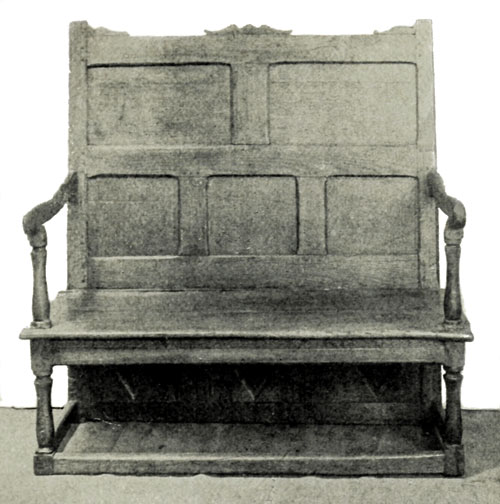
OAK SETTLE.
With back panel under seat made from older Oak Chest. Date 1675.
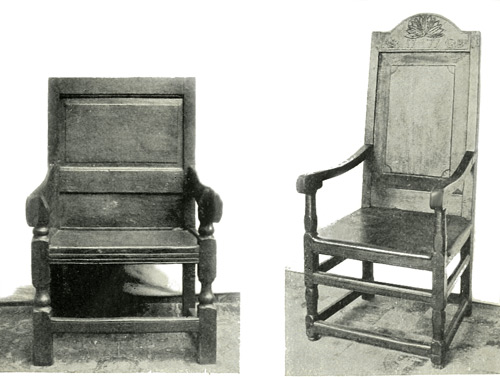
OAK ARM CHAIR. DATE 1675.
With Bevelled Panels.
OAK ARM CHAIR. DATE 1777.
With initials A.S. C.B.
The Chair-back and its Development.—Another point in connection with the ordered progress of the chair-maker is the gradual development of the back of the chair. At first it was straight upright, and no attempt was made to impart an angle to rest the back of the sitter. Types such as the arm-chair with square panel (p. 191) and the upright settle with the five panels illustrated on p. 201 indicate this feature of discomfort. The next stage is a slight inclination in the back, still possessing a flat panel. This angle, while not conforming to modern notions of ease, was an attempt to offer greater comfort than before. This style, in a hundred forms, with the minimum of inclination in the back, continued for a very considerable period. It is found in the nearly straight-backed chairs of Derbyshire and Yorkshire origin, with the turned stretchers, and it actually in later days became almost upright in the series of chairs following the later Stuart types with cane back and cane seat, noticeable for their tall narrow backs with a resemblance to the prie-dieu chair of continental usage.
The settle illustrated is a plainer variety of the settle made for use by fashionable folk with delicately 204 panelled back. Very often, in cottage furniture, chests and other pieces are broken up to make into smaller furniture or to be incorporated into furniture of a later design. Often it is found that the underframing of an old gate table made in the seventeenth or eighteenth century is from an earlier chest. In the present instance it will be seen that the back panels of the settle have been made from an older chest, which bears the inscribed initials, still visible, "I.E." In date this settle is about 1675, and is contemporary with the square-backed chair illustrated on the same page. Here the panel in back projects, that is, it is slightly bevelled forward. The bevelling of the panel is always a sign that a chair is later in date than the year 1670.
Illustrated on the same page is a remarkable chair having the initials "A.S.C.B." and the date 1777 carved on it. It is a striking instance of the adherence to old time-honoured form by the local cabinet-maker, with touches that, even although the date were not present, would tell their own story. This dull wood proclaims a message in accents no less sure than the sturdy yeoman's to Lady Clara Vere de Vere, and as a chair in date anno Domini 1777 may afford to "smile at the claims of long descent" of more pretentious and fashionable furniture. It is like a rich vein of dialect running in some old country song ripe with phrase of Saxon days. It seems incredible that this survival of early-Jacobean days should have been put together by a village craftsman true to convention and exact in seat and arms and stretcher. But it was not done unthinkingly. Here is a chair, astounding to note, made 207 when Sheraton was creating his new styles to supplant Chippendale, and when Hepplewhite stood between the two masters as a via media. And the back of this village chair has two distinct features translated from Hepplewhite's school—the wheatear crest and the panel with its broken corner!
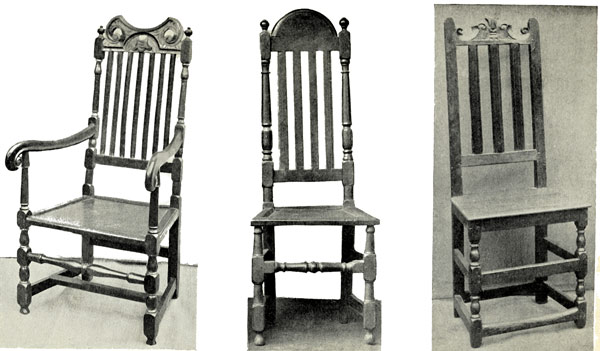
OAK CHAIRS. DATE ABOUT 1680.
Showing the inclination of the craftsmen to assimilate designs then being fashioned in walnut.
(By the courtesy of Messrs. Phillips, Hitchin.)
Transition between Jacobean and William and Mary Forms.—The rapid growth of the finer specimens of furniture made in walnut brought a new note into the farmhouse variety. The elegance and grace of the newer styles were at once evident. In the same manner as the grandiose splendour of Elizabethan woodcarving was succeeded by a less massive style in oak, degenerating into a rude simplicity in farmhouse examples, so in turn Jacobean lost favour. Walnut lent itself to more intricate turning, and lightness and greater delicacy claimed the popular favour of fashionable folk. The cane seat and the cane back at once indicate this new taste. The use of cushions became general and the sunk seat for the squab cushion is a feature in the later years of the seventeenth century.
Oak still remained the favourite wood of the country craftsman, in spite of its more refractory qualities. But when the walnut styles became so firmly established that clients demanded furniture in this fashion, elm and beech and yew were found pliable enough to conform to the more slender touches and the finer turning considered desirable.
Walnut was in its turn supplanted by mahogany, and it will be shown later how farmhouse furniture followed the dictates of fashion in days when the outburst of splendid design by Chippendale, Hepplewhite, 208 and Sheraton, together with a crowd of lesser known men, spread far and wide new principles in the art of furniture-making and brought country furniture another stage in its evolution.
Farmhouse furniture slowly assimilated the technique and design of the walnut age. The love for the native oak was so pronounced that country makers did not desert this wood and essayed to produce effects by its employment that were exceedingly difficult and oftentimes unsuccessful. The three chairs illustrated p. 205 show this transition style, about the year 1680, struggling with technical difficulties and affording a fine series of points in the evolution of design.
Farmhouse Styles contemporary with the Cane-back Chair.—Farmhouse furniture rarely, if ever, had cane-work in the back or in the seat. But the craftsman, while appreciating the delicacy of the cane back in adding lightness to the chair, circumvented his inability to work in cane by substituting thin vertical splats to give the necessary effect of transparency. The three chairs illustrated show each in varying degree the quaint compromise made between the technique of oak and the technique of walnut, and the attempt to reproduce the walnut designs.
The arm-chair exhibits strong relationship with the older Jacobean chair in its turned legs and uprights, but these have assumed a more slender proportion. The front stretcher is in the newer manner. The sunk seat is intended to receive a cushion. There should be no difficulty for the amateur correctly to assign a date to such a piece. The process of 211 reasoning would be somewhat as follows:—The lower half of the chair is Jacobean, but the front stretcher suggests the Charles II. period, borne out by the open back, which removes it from the Cromwellian period, and the details of the top rail with its curved top indicate that the country maker had seen the tall straight-back chairs of the William and Mary period with the cane-work panel.
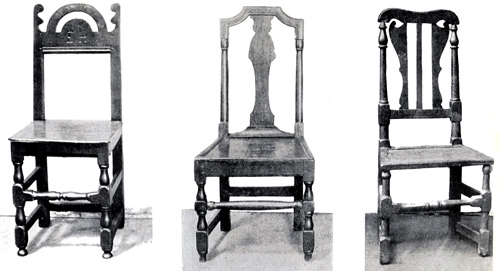
OAK CHAIRS.
With cresting rail, of Charles II. period, retained and perforated arch centre peculiar to walnut designs.
With elaboration in turned legs, and uprights, of William and Mary period retained, and having Queen Anne splat of 1710.
With sunk seat for squab cushion, turned uprights and legs and curious back, showing transition from lath back to splat back.
The middle chair more closely approaches the upright chair of the Charles II. period. There is a straight top-rail, supplemented by a lunette, giving the top a character of its own. This specimen is exceptionally interesting. The right-hand chair in its seat and legs is pronouncedly Jacobean. But the back with the three splats and the coarsely carved top-rail betray the hand of the country craftsman following in oak the more graceful curves of the worker in walnut of the days of Charles II.
It will be seen that these three chairs, each in varying manner, evade the difficulties of the light cane-back by the substitution of thin rails, and, as will be seen from the illustration of three other chairs (p. 209), the next stage of walnut design with fiddle-shaped splat offered equal problems to the makers of cottage furniture. Sometimes they eliminated the splat altogether, while adopting other points of design found in chairs with the Queen Anne splat of 1710. In every case the fondness for old established styles is exhibited in the fact that the country cabinet-maker clings doggedly to these and appears too conservative or too timid to break wholly away from tradition. In consequence, his work, with 212 patches of newer design welded on to the old, is quaintly incongruous. There is thus an absence of "thinking out" the design as a whole. The minor maker thought out the parts as he went along. Some of his results are extraordinary in their characteristics: they resemble that freak of fashion termed "harlequin" tea services, where the cups are of one pattern and the saucers of another. Bearing in mind these unfailing proclivities of the maker of cottage and farmhouse furniture, the collector should not find it difficult to recognise the country hand at once. Now and again one is struck with the extraordinary ingenuity of some of the work, or one is charmed with the faithfulness with which designs have been translated from the golden bowl to the silver, or, to be literal, from walnut and mahogany to oak and elm and beech. But one is never amazed at the delicacy of proportion, the balanced symmetry, or the fertility of invention—these attributes belong to cabinet-makers on a higher plane.
Of three chairs illustrated on p. 209, that on the left in the legs and seat shows the moribund Jacobean style. The stretcher indicates the oncoming of the newer styles, and the back with its cresting rail is of the Charles II. period. Its retention is curious, and the perforated arched centre is peculiar to designs found in walnut; its use in oak by the maker of this chair was a blunder, as oak is too hard a wood to employ for such a design.
The middle chair shows an equal admixture of styles. The elaboration in the turned legs and uprights belongs to the William and Mary period 217 and the splat is the Queen Anne fiddle pattern of 1710. The seat begins to show another form in having the middle sunk for the use of a squab cushion.
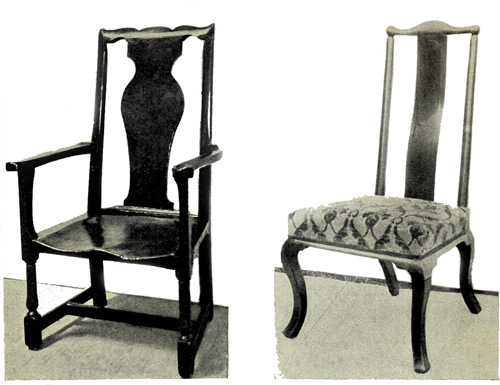
QUEEN ANNE CHAIR.
Entirely oak form except back and splat.
QUEEN ANNE CHAIR.
In oak, with strong inclinations towards walnut styles.
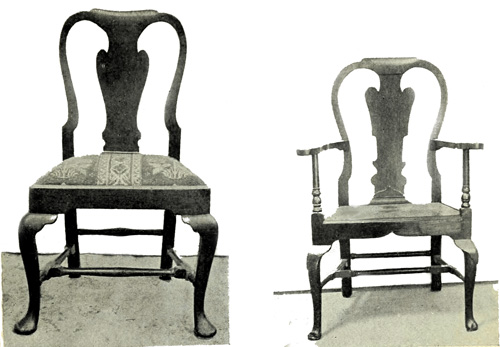
QUEEN ANNE CHAIR.
Walnut design made in oak for farmhouse use.
QUEEN ANE ARM-CHAIR.
With shaped front, walnut design executed in oak.
(By the courtesy of Messrs. Phillips, Hitchin.)
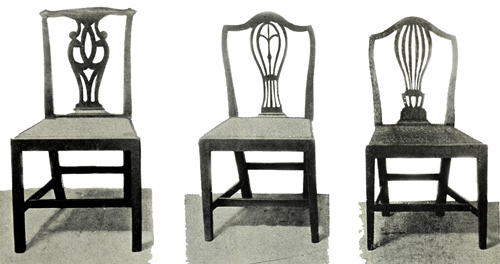
COUNTRY CHIPPENDALE CHAIR, STYLE MERGING INTO HEPPLEWHITE.
Less pronounced Cupid's bow top.
TWO CHAIRS COUNTRY HEPPLEWHITE STYLE MADE ENTIRELY IN OAK.
Left-hand chair with Prince of Wales's feathers.
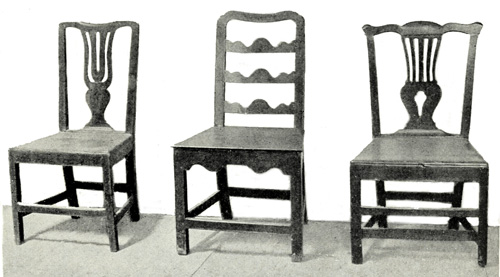
TYPES OF COTTAGE CHAIRS IN OAK.
Having features of the three styles—Queen Anne, Chippendale, and Sheraton.
Two chairs Queen Anne style.
Chair Country Chippendale style.
The right-hand chair parts with the underframing below the seat, which gives a touch of lightness to the construction. The turned legs and uprights have departed from the coarse early-Jacobean style and perceptibly depend on walnut prototypes for their character. The back shows the transition from the lath back (such as in the chairs simulating the cane-work) to the splat back. It is an interesting and rare example, marking the slow assimilation of new forms by isolated makers. This specimen came from Ireland and evidently possesses native touches of originality which defy the connoisseur to determine its exact date.
The Queen Anne Splat.—The fiddle-shaped splat of 1710 marks a turning-point in the construction of the chair.
The walnut chairs with caned backs of the time of James II. and the early days of William III. were carved richly, and sometimes there was a splat dividing the caning at the back, which later, also in caned-back examples, is curved and plain. The general tendency in the reigns of William and Mary, especially towards the close of the period, was one of economy, and elaborate carving began to disappear.
The Queen Anne smooth splat of fiddle form rapidly became popular. This Anglo-Dutch style became acclimatised here, and is characteristic of the homely examples of the Queen Anne period. In 218 walnut it was comparatively easy to carry out carving. In oak such elaboration was well-nigh impossible. It was therefore natural that in the farmhouse examples the plain Dutch splat would readily find favour as more easily executed. By the time that the fiddle splat had become popular the stretcher joining the cabriole legs commenced to disappear.
The splat plays an important part as indicating sharp variations in design—walnut with open carving, intricate and floriated; walnut with the plain fiddle splat, with its corresponding minor form in oak; mahogany, with the advent of Chippendale, with the splat again open, carved with graceful ribbon-work.
The arm-chair illustrated p. 213 is a remarkable instance of intermingling of styles. The front legs are in Jacobean style, and are continued in the same manner as the usual type of oak chair as supports for the arms, but an original touch and naïve departure is in the curve given to this upright from the seat upwards. The seat is shaped like that of the Windsor chair. The arms are somewhat stiff for the back with its Cupid's-bow design, which has a sprightliness and grace making it a thing apart. The whole is not unpleasing. It is a remarkable instance of the attempted assimilation of several diverse styles by an undeveloped cabinet-maker with strong ideas of his own. The oak form is rigidly retained in all except the back and splat of Queen Anne days.
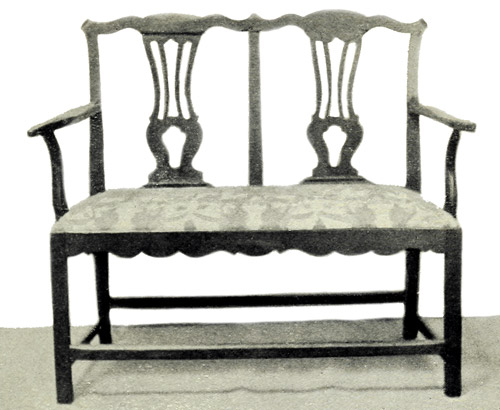
COUNTRY-MADE OAK SETTEE WITH DOUBLE BACK IN CHIPPENDALE STYLE.
The shaped underframing is a feature only found in farmhouse varieties.
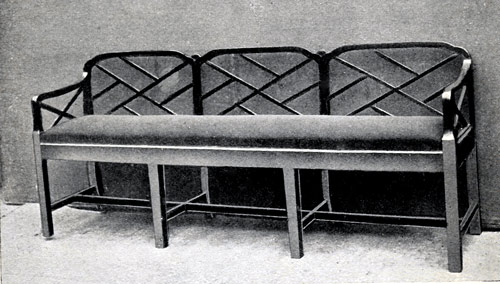
COUNTRY-MADE OAK SETTEE IN CHINESE CHIPPENDALE STYLE.
(By the courtesy of Messrs. Phillips, Hitchin.)
The adjacent chair, with its tall back with curved splat and its cabriole legs, marks the transition 221 between William and Mary and Queen Anne. The top rail indicates by its clumsy joinery the touch of the immature country cabinet-maker. It is an attempt to approach a fine model with insufficiency of skill by the maker. The use of the cabriole leg either in chairs or in dressers in homely furniture has always proved a stumbling-block to the minor craftsman. The delicacy of balance required in order to preserve the harmony of the whole has proved too subtle a problem for him to handle, and to the practised eye these farmhouse pieces at once proclaim their origin.
The broad splat and the straight square front and the bold cabriole leg of the Queen Anne type in walnut were often copied in oak. The example of the chair with the later tapestry covering, illustrated p. 213, is a case where the local cabinet-maker has faithfully copied detail for detail from some fine original in walnut. His is in oak for more strenuous usage. The adjacent arm-chair is of the Queen Anne style, with a shaped front that is very rarely found in such pieces. The maker here has not been so successful in catching the bold lines of his original. There is a sense of something lacking in the curves of the back. The touches of his own that he has added in the arms, reverting to an earlier Jacobean type, reveal the unpractised hand.
Country Chippendale, Hepplewhite, and Sheraton.—A word in passing may be said in regard to the unique character of furniture of these types. It is obvious that factory-made furniture turned out by the hundred pieces can offer nothing personal, whatever its merits 222 or demerits of design or workmanship. It is this personal note, the love of a craftsman in his creation, that appeals to the collector, whether it be of Persian rugs or of old brass candlesticks. It is absent in art produced in a wholesale manner. Blunderingly as the village craftsmen went to work, they often stumbled into great things, and they always produced original results.
Prior to the publication of the design-books of the great eighteenth-century masters of cabinet-making, the furniture of certain localities began to assume a character of its own, the result of long tradition, and designs such as the dragon found in Welsh carving became established. The term "unique" is peculiarly appropriate to furniture of this calibre, for rarely are two pieces found to be exactly alike. Not only did different makers add novel features, but the same craftsman apparently did not repeat himself.
The permutations of form governing furniture are illimitable, associated as they are with so many details of construction. To take the chair—the leg, its shape, and the design of its turning; the style and character of the work on the stretcher; the form of the seat; the decoration and formation of the front; the back, its length, and the variety of splats and panels; and the top rail with its variations—these are only the salient features in which differences appear. Such modifications of design and piquant touches of personal character appeal to the collector, who loves the foibles and fanciful moods of the native craftsman, be he ever so humble.
223 Chippendale published his "Director" in 1754, and it became a working guide to all ambitious craftsmen. Ince and Mayhew, cabinet-makers of Broad Street, Golden Square, had issued "Household Furniture" in 1748, and Hepplewhite & Co. followed later with the "Cabinet Maker and Upholsterer's Guide" in 1788, where the delicacies of ornament were related to the chaster classic models, and in 1794 came Sheraton with his "Drawing Book," rich with subtle suggestiveness. A rough generalisation shows the Chippendale school holding sway from 1730 to 1780, the Hepplewhite school from 1775 to 1795, and the Sheraton school from 1790 to 1805: and behind all, the strong influence of the Brothers Adam in their classic revival. What had previously been tradition came very speedily into line with current modes. Fashion, as we have shown, had a slow and impermanent effect upon village ideals. But the output of these great illustrated volumes, with working drawings, undoubtedly had a wide-reaching influence. The last quarter of the eighteenth century saw an intense outburst of interest in the arts of interior decoration. A great amount of finely designed and beautifully executed furniture belongs to those days, and the echo of the splendid achievements in mahogany and in satinwood is seen in the farmhouse and cottage furniture, which came singularly close upon the heels of fashion.
Chippendale furniture in oak, elm, or beech is being largely collected. We illustrate a sufficient number of types to show that this class of design 224 known as "Cottage Chippendale," has peculiar charms of its own. The arm-chair illustrated p. 225 is in elm, and is in the style Chippendale employed in his rich mahogany creations in 1760. The fine interlaced carving of the back is graceful and well proportioned. The adjacent chair, in elm, still follows the Chippendale style. The seat is rush, and the maker has confined himself to his own limitations and avoided in the splat the too intricate work of more sumptuous models. He has arrived at a very finely balanced result. The heart cut out of the splat is frequently found in cottage examples, suggesting that some of the more ornate examples may have been made as wedding presents for young couples just setting up housekeeping, or possibly the village cabinet-maker himself had thoughts in that direction, and such work was destined to equip his own home.
The illustration of a chair, in beech, with a plain wooden seat, has a somewhat intricate ribbon-like pattern terminating in the Prince of Wales's feathers. The heart is present in the design at the base of the splat, cut out in fretwork. The arm-chair on the right, with its dipped seat, is in oak, and is an instance representing the adaptations of Sheraton styles in the provinces.
Another page of chairs in oak (p. 215) shows the influences at work in moulding the character of the styles of the late eighteenth and early nineteenth century farmhouse furniture. Of the three chairs at top of p. 215, the left-hand one is in Chippendale style merging into Hepplewhite. The Cupid's bow 227 at the top rail has become less pronounced. The other two chairs on right are typically Hepplewhite in character. The Prince of Wales's feathers, so often associated with Hepplewhite's own work, are embodied in the splat of one.
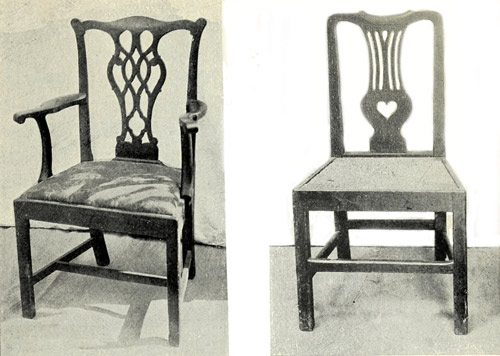
ELM CHAIR, COUNTRY CHIPPENDALE STYLE. 1760.
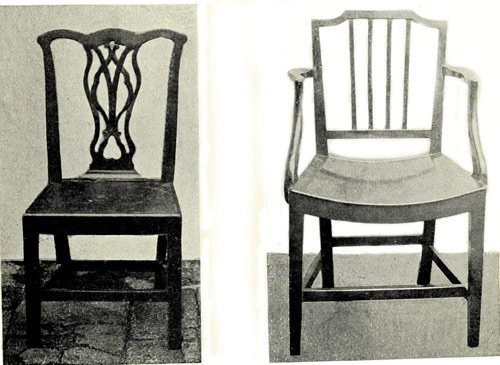
BEECH CHAIR. COUNTRY CHIPPENDALE STYLE.
OAK CHAIR, COUNTRY CHIPPENDALE STYLE. WITH DROPPED SEAT.
In the lower group, the right-hand chair is of the Chippendale type. The other two chairs have features of three styles—the Queen Anne, the Chippendale, and the Sheraton. It is this piquancy and incongruous combination of styles adjacent to each other in point of time, but having little other relationship, which make the provincialisms of the cabinet-maker of exceptional interest.
At times more ambitious attempts were made in oak, following the lines of the Chippendale style in mahogany. These have pronounced features always recognisable as belonging to the farmhouse variety of furniture. Two examples are illustrated, p. 219. The upper example of country-made oak settee, with double back, at once indicates that it is provincial by the shaped underframing, which is never found in other classes of furniture. The lower example of farmhouse oak settee is clearly in Chippendale's Chinese style. A reference to the "Gentleman and Cabinet Maker's Directory," published by Thomas Chippendale in 1754, shows that this Chinese style adopted by the local maker is very far removed from the series of delicate fretwork designs illustrated by Chippendale in his volume. It is true that the old designer of St. Martin's Lane sent forth his work with the sub-title stating that it was "calculated to improve and refine the present 228 Taste, and suited to the Fancy and Circumstances of Persons in all Degrees of Life." The great master cabinet-maker, in scattering his designs far and wide, evidently had in mind the formation of a new style. He builded better than he knew. The importance of his book of designs cannot be overrated. It was subscribed for in Yorkshire, in Devon, in Westmorland, and in Ireland, and straightway minor men looked upon these delightful inventions and began to follow to the best of their ability the ideals set forth by Chippendale the dreamer.
That he was an idealist in this book of designs is naïvely explained in his Preface: "I frankly confess that in the executing many of the drawings my pencil has but faintly copied out those images that my fancy suggested, and had they not been published till I could have pronounced them perfect, perhaps they had never seen the light." But Chippendale was also a practical cabinet-maker as well as a designer. He has a lingering doubt that after all, perhaps, the country cabinet-maker and those who bought the book for use might not be able to carry out his designs. Evidently this had struck others too. Perhaps he was accused of fobbing-off in a design-book mere fanciful work that was too far above the plane of ordinary cabinet-work. He meets this objection with a declaration, so to speak, upon honour, with which he winds up his Preface, which is a pretty piece of eighteenth-century advertising:—
"Upon the whole, I have given no design but what may be executed with advantage by the hands of a skilful workman, though some of the profession have 229 been diligent enough to represent them (especially those after the Gothic and Chinese manner) as so many specious drawings, impossible to be worked off by any mechanic whatsoever. I will not scruple to attribute this to malice, ignorance, and inability, and I am confident I can convince all noblemen, gentlemen, or others, who will honour me with their commands, that every design in the book can be improved, both as to beauty and enrichment, in the execution of it, by—Their Most Obedient Servant, Thomas Chippendale."
Enough has been said to prove that "country Chippendale" is not a misnomer. It is equally true that the Hepplewhite style was disseminated in like fashion in the provinces. It must be remembered that these trade catalogues, as they really were, brought out somewhat in rivalry with each other by the great London designers and cabinet-makers, were the only literature the country makers had to indicate town fashions. These volumes therefore served a double purpose in procuring clients for the firm and in stimulating the art of the country designer. That they were in part intended to be educational is shown by the Preface to the "Cabinet Maker and Upholsterer's Guide," published by A. Hepplewhite & Co., Cabinet-makers. We quote from the Preface of the third edition, "improved," 1794.
The Preface opens with a lament that owing to "the mutability of all things, but more especially of fashions," foreigners who seek a knowledge of English taste and workmanship may be misled by the "labours of our predecessors in this line of little use."
230 "The same reason in favour of this work will apply also to many of our own countrymen and artisans, whose distance from the metropolis makes even an imperfect knowledge of its improvements acquired with much trouble and expense."
"In this instance we hope for reward; and though we lay no claim to extraordinary merit in our designs, we flatter ourselves they will be found serviceable to young workmen in general, and occasionally to more experienced ones."
In view, therefore, of the books of design we have enumerated, it is obvious that the country designer had a new field open to him, and now and again he made ample use of his opportunities. During the last quarter of the eighteenth century there was quite an outburst of literature on furniture, much of it forgotten and much of it waiting to be disinterred by patient research; and with the dissemination of these fine designs some of the most perfect examples of country-made furniture began to exhibit touches of skill of the practised hand.
The Grandfather Chair.—From the illustration given on p. 231 it will be seen that the type known as the "grandfather" has a humble lineage. It will be found with the same wings and curved arms and plain wooden seat in the alehouse or in the ingle nook of the farmhouse. The specimen we illustrate does duty as a bacon-cupboard as well as a chair. Usually such pieces have the cupboard opening at the back, but in this instance the cupboard opens in front.
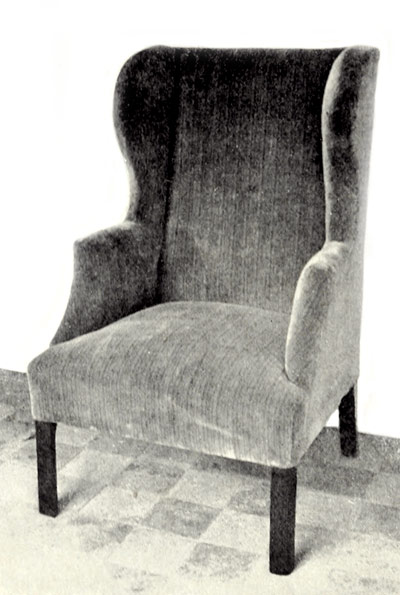
COUNTRY GRANDFATHER CHAIR.
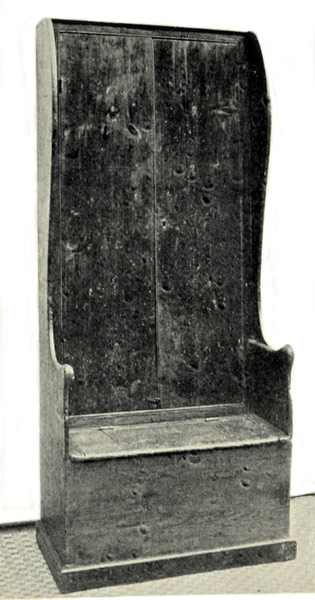
ARM-CHAIR AND BACON-CUPBOARD.
Opens at foot. This type usually opens at back.
As early as the opening years of the eighteenth century there were upholstered chairs of a somewhat 233 similar type to the so-called "grandfather" with scrolled arms or wings. The example we illustrate is representative of those which may be met with in the country farmhouse.
Ladder-back Types.—The ladder-back chair belongs to the northern half of England, and similarly the spindle-back chair is found in the same locality. The Windsor chair, on the other hand, is mainly confined to the southern half of the country. These are points which become noticeable after years of systematised research, and although nowadays these three varieties of chair may still be found, somewhat scattered, their real home and place of origin is as indicated. Another feature of interest is that both ladder-back and spindle-back varieties, with but slight differences, are found on the Continent.
It will be observed that this class of chair has a rush seat. This feature it has in common with the spindle-back chair.
The rush-bottom chair covers a wide area. It comes with an air of naïveté and rustic simplicity. One recalls the long lines of green rushes by the river-bank and the rush-gatherers in idyllic placidity slowly trimming the banks, disturbing coot and moorhen with their punt, and adding another human touch to the lonely angler. They are pursuing a calling as old as the river itself, and the use of rush for floor, for lighting, or for seating furniture, found occupation for generations of men plying curious trades, of which the plaiting of osiers into baskets and the thatching of cottage roofs may be numbered among the decaying industries. Indeed, this 234 latter art and the making of birch and heath brooms may be almost said to be extinct. A good artisan who can thatch in the old artistic style is much sought after. Of course ricks have still to be thatched, but the picturesque skill of masters of this old-world craft is absent, and corrugated iron sheets have found favour in lieu of the old style.
The ladder-back chair is, as its name denotes, decorated with horizontal supports, ladder fashion. These are capable of the most pleasing variation. The perfection of form of this type is seen in the arm-chair illustrated p. 237. The well-balanced proportion of the ladder rails is a test as to the excellence of the design. They are not meaningless ornaments put in place, unthinkingly, to create a new style. The two examples illustrated on page 235 show other types of the ladder-back chair. The left-hand one shows the later stages in the development of the design, and its top rail is of the Sheraton period. The right-hand one, with arms, is composite in its character, and is in date about 1820, and exhibits a touch of the Sheraton slenderness of style in the splats and the round turning of arms. Both examples show the quaint survival of the Queen Anne foot. The ladder-back form survived the eighteenth century and lasted down to within fifty years ago, when it became merged into that of the Windsor chair.
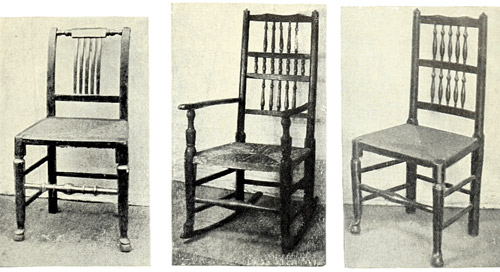
LADDER-BACK TYPE OF CHAIR.
Showing Empire influence in curved back.
Dated 1820-1830.
SPINDLE-BACK NURSING CHAIR WITH ROCKER.
Three rows of spindles.
SPINDLE-BACK CHAIR.
Two rows of spindles.
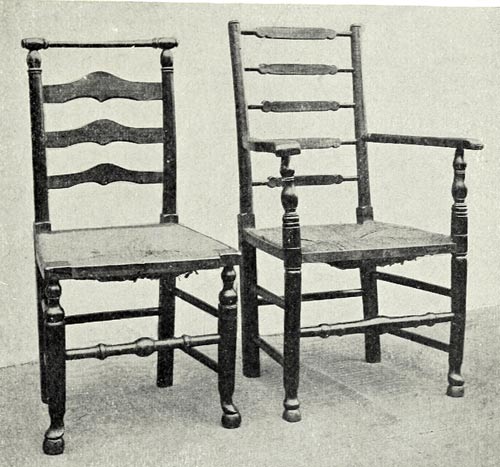
LADDER-BACK CHAIRS WITH RUSH SEAT.
Both chairs showing quaint survival of the Queen Anne feet.
Late Eighteenth Century, with top rail in Sheraton style.
Later form of splat with turned ends. Dated 1820.
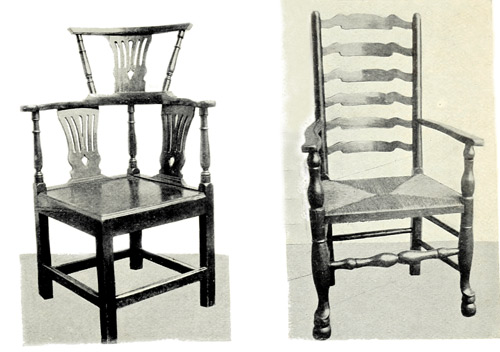
COUNTRY BARBER'S CHAIR.
LADDER-BACK CHAIR.
Perfect specimen in regard to style.
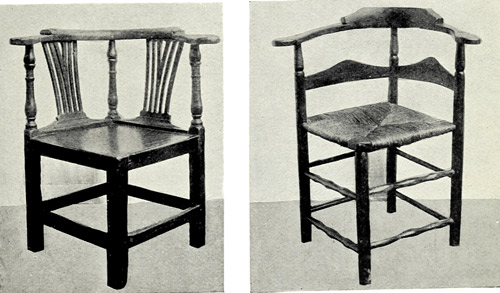
OAK CORNER CHAIR.
LADDER-BACK FORM OF CORNER CHAIR WITH RUSH SEAT.
Probably Lancashire.
(By the courtesy of Messrs. Phillips, Hitchin.)
The Spindle-back Chair.—The spindle-back chair is of long lineage. As early as the reign of Charles I. this type was known. There is still treasured in America the chair of Governor Carver, with simple 239 turning in legs and back, which practically consisted of upright posts rounded and having slight ornament. The back was set with "spindles." The older types of these chairs had thick upright posts, the back and back legs being two posts and the front legs, continued upward beyond the seat, forming supports for the arms. These posts are often six or seven inches in circumference, and belong to early-Jacobean days. The type found its way to America in Puritan days and has continued to be a favourite. Hickory wood was used for American specimens, and considerable attention has been paid to this form of chair and its varieties, the differing heights of the posts and the number of the spindles and their character, by American collectors. In England examples are not easily found of early date. The examples illustrated (p. 235), a Nursing Chair on rockers and an ordinary Spindle-Back Chair, are of eighteenth-century days, and are sufficient to indicate the type of chair, but these two represent the style when it had become of more general use. Practically it was not until the eighteenth century that such types were commonly used in cottages and farmhouses.
These turned chairs, turned in every portion but the rush seat, lend themselves to the above-mentioned two styles of treatment. Their upright posts forming the open back can be treated with vertical splats divided by horizontal divisions, or they can, as in the ladder form, receive horizontal splats. The complete simplicity of this attitude towards the back absolved the homely cabinet-maker from dangerous experiments. Avoiding curved backs, he had not to face 240 the intricacies of the nicety of balance in the splat. Altogether it was a very satisfactory solution, and in practice resulted in the production of a wide range of chairs, differing in slight details but well within the range of the local workman's art.
The unassuming simplicity of this class of chair made its appeal to Madox-Brown, who held that simplicity and utility were the two desiderata, united with soundness of construction, for domestic furniture. Veneer was as abhorrent to him as to all genuine lovers of the artistic. "Let us be honest, let us be genuine in furniture as in aught else," were his words. "If we must needs make our chairs and tables of cheap wood, do not let them masquerade as mahogany or rosewood; let the thing appear that which it is; it will not lack dignity if it be good of its kind and well made." Accordingly he put his theories into practice and designed some furniture. In a chair in the possession of Mr. Harold Rathbone he has employed the rush seat and used spindles to decorate the back, and in another chair in the same collection he has adhered to the horizontal ladder-back style, coupled with the rush seat, with pleasing effect.
Corner Chairs.—Among interesting types of chairs often with lingering traces of the Jacobean style and additional features of splats that may be regarded as standing on the threshold of the Chippendale period, corner chairs stand in a class alone. The illustrations on p. 237 show some typical examples. The chair with the double tier is the oak adaptation of Chippendale with the retention of the old Jacobean form of support for the arm. These 241 chairs with this added tier are often used as country barber's chairs. The rush-seated corner chair on the same page, probably made in Lancashire, is suggestive of the ladder-back form, and there are indications in its construction that it is subsequent to the Hepplewhite period.
With these notes relative to the evolution of the chair, and with carefully selected illustrations of types likely to be of use to the collector, enough has been said to whet the curiosity of the reader to study the matter for himself. It requires keen and discriminating judgment to allocate specimens with passing exactitude as to time and place. The taste for the subject must be natural and not acquired. Training alone will give the eye the readiness to detect false touches and modern additions. The search for bargains goes on apace, and those who enjoy stalking their quarry in out-of-the-way places have an exciting quest nowadays for fine pieces. To those with endless patience, forbearing under disappointment, and having plenty of leisure, the search will offer abundant delight, if, to quote Mrs. Battle, they enjoy "the rigour of the game."
CHAPTER VIII
THE WINDSOR CHAIR
Early types—The stick legs without stretcher—The tavern chair—Eighteenth-century pleasure gardens—The rail-back variety—Chippendale style Windsor chairs—The survival of the Windsor chair.
The Windsor chair in its early form is coincident with the early years of the eighteenth century. Its history and development therefore exhibit traces of the various styles in furniture which ran their courses throughout the century. It is essentially a chair which belongs to minor furniture, and in its use it is bound up with the country farmhouse, the country inn, or in the metropolis with the chocolate-houses and taverns, and later with the innumerable pleasure gardens which sprang up around the metropolis in the eighteenth century.
There is more than a strong suggestion that the type originated in the country. The first forms have a similarity to the easily made three-legged stools. The seat is one piece of wood into which holes are 246 bored to admit the legs. The origin of the term "Windsor chair," according to a story largely current in America, is that George III., the Farmer King, saw a chair of this design in a humble cottage near Windsor, and was so enamoured of it that he ordered some to be made for the royal use. The chair had a singular vogue in America, and it is stated that George Washington had a row of Windsor chairs at his house at Mount Vernon, and Jefferson sat in a Windsor chair when he signed the Declaration of Independence in 1776.
The Stick Legs without Stretcher.—Obviously this is the earliest type, and the illustrations of these primitive forms (p. 247) show the simplicity of the joinery. The chair on the left with its almost straight top rail suggests a probable date. It was not till 1768 that Chippendale made the first straight top rail in English furniture. The seat is of the saddle-form. The spindles at the back in the lower row taper at each end. It will be observed in all the types we illustrate in this chapter that the arms extend in one piece around the chair. Nor has every example the saddle seat. On the same page is illustrated one with a plain seat, but still having the stick legs set at an angle towards the centre of the chair.
Whatever interest attaches to this early type, from a collecting point of view, they cannot compare in beauty with the finer varieties of a later period, with cabriole leg and with pierced splat, displaying a pleasing diversity of patterns in pierced work, no two of which are always quite alike.
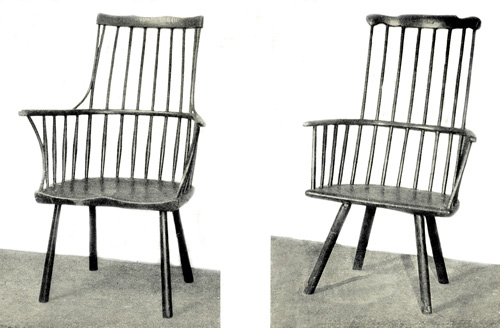
WINDSOR CHAIRS.
Earliest form; stick legs with no stretcher.
(By the courtesy of Messers. Phillips, Hitchin.)
The Tavern Chair.—It was Dr. Johnson who declared that a tavern chair was the throne of human felicity. Undoubtedly the eighteenth century found the need of a comfortable chair for club meetings at taverns and alehouses. The country inn to-day has its Windsor chairs, many of them of great age. Nor were chairs of this type always with arms. There are many plainer chairs without arms and having what is termed "fiddle-string" backs; more often than not across this back there is a rail put transversely to strengthen it. Many of these chairs were made by local carpenters and wheelwrights. They employed any wood that happened to be in their workshop at the time; in consequence the variety of woods in which these chairs are found is great. Sometimes the seat is made from beech or elm and the arms are fashioned from the wood of the pear-tree. The curved horseshoe rails and back are more often than not constructed from the ash.
Eighteenth Century Pleasure Gardens.—There is no doubt that we owe the considerable output of Windsor chairs in the middle of the eighteenth century to the growth of coffee-houses, and especially the numerous tea and pleasure gardens on the outskirts of London and other great towns. These semi-rural resorts began to be in great demand as a recreation for jaded eighteenth-century town-dwellers. The nobility and persons of fashion had Bath and Tunbridge Wells to fly to for country air and open-air recreation. The citizen and mechanic, the society beau, and the politician, crowded to Ranelagh Gardens, to Vauxhall, to Sadler's Wells, 250 and to Hampstead, to enjoy sunny afternoons and summer evenings in the open air, or to spend Sundays. It was the eighteenth-century diversion similar to the nineteenth-century Crystal Palace and the twentieth-century Earl's Court. To quote Mr. Percy Macquoid in his lordly work on English furniture, "So great were the numbers of visitors to these places that attention was called to their increase in one of the contemporary weekly journals, where a calculation was made that on Sundays alone two hundred thousand people visited the tea-gardens situated on the northern side of London; and as half-a-crown per head was probably the least sum expended by them, it can be no exaggeration to state that £20,000 on a fine Sunday was taken at these places of amusement. Many cheap chairs must have been required at such places of entertainment."
Between the year 1760 and the end of the century the Windsor chair was being made for general country use. "The backs and arms of these," continues Mr. Macquoid, "are made of hoops of yew, held together by a number of slender uprights and a perforated splat of the same tough and pliant wood; the seats were generally invariably of elm, as yew cut into a superficies of any size is liable to split; the legs and stretchers were generally of yew."
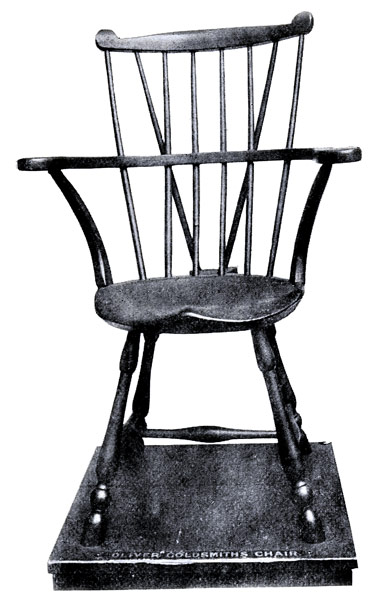
OLIVER GOLDSMITH'S CHAIR.
Wood, painted green, with circular seat, curved arms, and high back. Bequeathed by Oliver Goldsmith in 1774 to his friend, Dr. Hawes.
(Bethnal Green Museum.)
The Rail-back Variety.—We have alluded to the use of the rail placed across the back from the top rail to the seat, crossing the uprights. It is not an elegant device, but it was used as a means of strengthening the back. It seems almost unnecessary, although possibly these chairs received a good deal of rough 253 usage. Later, when the fiddle splat began to be employed, this transverse rail—sometimes there were two used—was discontinued. An historic example of the chair with transverse rails is that which was once in the possession of Oliver Goldsmith. There is no doubt about the authenticity of this, as it was bequeathed by the poet to his medical attendant, Dr. Hawes, who, by the way, was the founder of the Royal Humane Society. Goldsmith told his farmer friends at his cottage at Edgware that he should never in future spend more than two months a year in London, and at the time of his death in 1774 he was negotiating the sale of the lease of his Temple chambers. This chair (illustrated p. 251) has a rather small shaped seat, curved arms, a top rail that is of exceptional interest considering the date, which is, say, from 1770 to 1774, perhaps a little earlier. This was at the commencement of the Hepplewhite period, which lasted till 1790. The year 1768 was, as we have already said, the date at which chairs with straight top rails, designed by Adam and executed by Chippendale, were first made. The turned legs are interesting, showing the hoofed foot, and the turned stretcher retains an earlier form. The chair is of soft wood, probably beech, and is painted green. It is preserved at the Bethnal Green Museum, with the distinctive label on the stand: "Oliver Goldsmith's Chair."
The Splat Back and the Cabriole Leg.—It is here that the Windsor chair assumes a character essentially charming and attracts the admiration of connoisseurs of styles that are peculiarly English. The splat back 254 is a feature only found in English varieties of the Windsor chair. In America a great deal of attention has been paid to old types, and there the pliant hickory wood is used in the making of chairs of this form; but the splat back is never used in America, and when found by collectors there the piece is attributed to English manufacture.
The splat, with its varying forms, denotes the date of the chair. From 1740 to 1770 the form with cabriole legs and with finely ornamented fiddle splat was at its best. We illustrate a sufficient number of specimens to show how graceful and perfectly well balanced these chairs had become. In contemplating pieces remarkable for the highest style, it must be admitted that their artistry and their simple unaffected sense of comfort do make a direct appeal to those who are willing to recognise fine qualities in minor furniture.
The two chairs illustrated (p. 255) differ slightly in details of construction. That on the left has the plain urn splat, a survival of the Queen Anne type. The seat is finely shaped and the legs are cabriole form. The top rail is almost straight, and is ornamented at the two ends with turned discs. The three stretchers are turned, and in the adjacent chair the stretchers are similar, save in a slight variation in the pattern of the turning. But here the splat is perforated with an intricate design suggestive of the lines of Chippendale; the top rail is a departure in form, imparting a distinctiveness which lifts the chair from the ordinary type.
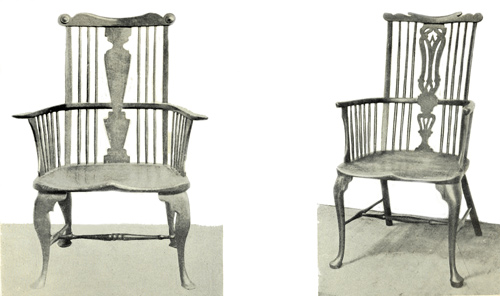
WINDSOR CHAIR.
With plain fiddle splat of Queen Anne type, Chippendale top rail and cabriole legs, and three turned stretchers.
WINDSOR CHAIR.
With pierced fiddle splat, shaped arms, cabriole legs, and three turned stretchers.
(By the courtesy of Messrs. Phillips, Hitchin.)
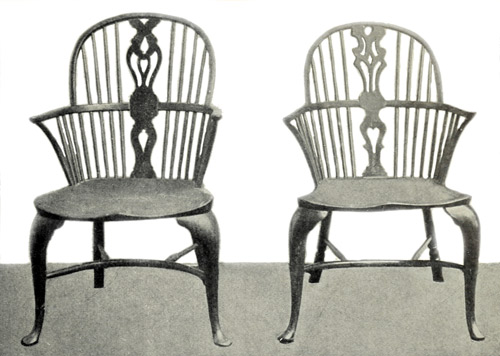
CHIPPENDALE WINDSOR CHAIRS.
Chippendale splats. The type of splat indicates the date of Windsor chairs.
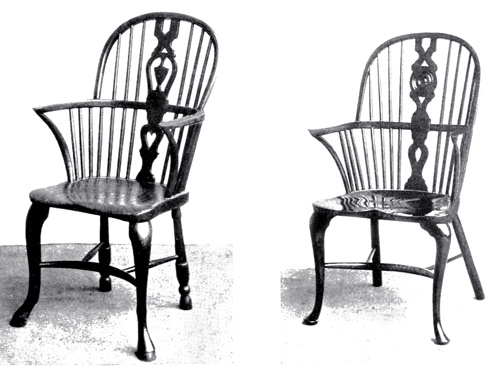
HEPPLEWHITE WINDSOR CHAIR.
Exceptionally fine legs back and front. Urn back. Probably Welsh carving.
HEPPLEWHITE PERIOD WINDSOR CHAIR.
With wheel back, in yew.
(By courtesy of Messrs. A. B. Daniell & Sons.)
Chippendale Style Windsor Chairs.—The page of 259 chairs (p. 257) tells its own story. The beautiful sweep of the curved back is always a sign of the old and true form. Later imitations or replicas seem somehow to lose this effect. It has been suggested that the back of this style was produced by the village wheelwright in horseshoe form, but possibly that is a conjecture which is more fanciful than real. It has also—collectors are often fond of inventing theories to fit little-known facts—been asserted that the wheel-back variety, which is of somewhat more modern growth, is due to the same origin. This wheel is fretted with six triangular openings. One chair on this page has the wheel unperforated. In the examination of the details of the four examples there is nothing of great importance to differentiate them from each other in construction. The two at the top are suggestive of Chippendale in the ornament employed in the splat. The lower two incline more to the slightly later Hepplewhite period. Of these the one on the left has only fourteen upright rails at the lower portion and six in the upper portion of the back, in comparison with sixteen and eight in the other chairs. The legs of this chair are exceptionally fine both back and front. The work in the splat is slightly suggestive of Welsh carving, especially that style associated with Welsh love-spoons.
Following the influence of Chippendale and Hepplewhite came the style of Sheraton, which after 1790 began to affect the character of some forms of minor furniture. That this was a very real factor is often shown most unexpectedly in cottage and farmhouse pieces. The satinwood and the 260 painted panel, and the intricacies and subtleties of his employment of colour, were of course too far removed from the simple cabinet-work of the country maker to have the least effect upon him, even if he ever saw them. But the slenderness and elegance of the Sheraton styles did in a small degree have weight with cabinet-makers as a whole in the provinces. So that it is quite within reasonable surmise to attribute certain forms to the Sheraton school, or rather to the oncoming of the early nineteenth-century mannerisms. On p. 261 two examples are illustrated showing this influence. The one with the horseshoe back is devoid of the splat, which had now disappeared. The turned legs begin to show signs of modernity. The other has the top-rail familiar in later forms of cottage chair. The turned rails for the arms and the type of turning in the legs show signs of decadence. The fine days of the old Windsor chair were coming to an end.
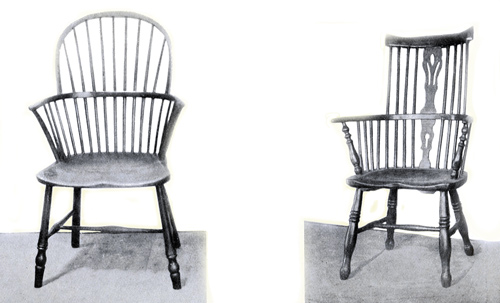
WINDSOR CHAIR.
Horseshoe back, saddle seat, turned legs, with stretcher. Sheraton style.
WINDSOR CHAIR.
Curved top rail, turned arms, legs, and stretcher. Sheraton style, pierced fiddle splat.
The Survival of the Windsor Chair Type.—Apart from the love of the simple form and especially well-conceived design of the Windsor chair, which have made it at once the especial favourite of artists and lovers of simplicity and utility, it has won the practical approval of generations of innkeepers, who to this day store hundreds of chairs for use at village festivals. What we have said in regard to the popularity of the gate-leg table applies in greater degree to the Windsor chair. The industry of turning the legs and rails of this type of chair is still carried on in Buckinghamshire. Until recent years much of this turning was done by hand by villagers in the 263 district surrounding High Wycombe, where the parts are sent to be finished and made up. To this day some of the old chair-makers use the antiquated pole lathe. But the chairs have departed from their old stateliness. It is true that they have survived, almost in spite of themselves. They are not now the objects of beauty they once were. But they have, by reason of modern requirements, found a fresh field of usefulness. Will it be supposed that the modern office chair is in reality a Windsor? An examination will at once show this, even in the latest American types. The saddle-shaped seat is there, the straight turned legs, and the back is the same except that the upper extension has disappeared and the old centre rail has become broader as a properly-formed rest for the tired clerk's back. A perusal of a few catalogues of up-to-date office furniture will establish this. Here, then, is the last stage of the country Windsor chair. The twentieth-century Windsor has come to town and graces the head cashier's private office in a bank or the senior partner's room of a firm of stockbrokers.
CHAPTER IX
LOCAL TYPES
Welsh carving—Scottish types—Lancashire dressers, wardrobes, and chairs—Hertfordshire, Bedfordshire, Cambridge, and Essex tables—Isle of Man tables.
The charm of collecting cottage and farmhouse furniture lies in the wide area over which it is found. Those who have given especial attention to collecting it have learned instinctively to differentiate between the work of various localities. Some well-defined types of cottage furniture are only to be found in certain counties, and nowhere else. Take for example the ladder-back and the spindle chairs. The latter are usually found in the northern half and the former in the southern half of England. It is obvious that craftsmen developing on original lines, or on lines more or less apart from outside influence, must establish designs peculiarly identified with their field of labours.
The sturdy insularity of the British peasant, and his uneasy reception of foreign suggestion, have had a very pronounced influence upon his methods of work. He has the defects of his qualities, the 268 stern, almost uncompromising conservatism in habit of mind and in his daily pursuits. A close study of the thoughts, and as far as is recorded the written ideals, of the rural labouring population exhibit an extraordinary fixity of purpose in clinging tenaciously to old customs. The country songs more often than not express disapproval of innovations and call up the memories of slowly vanishing customs. The farm hands recall wistfully the old style of Shearers' feasts and Harvest homes, when great festivities with song and dance and old country sports enlivened the company. In Yorkshire this was termed the Mel Supper, in Kent the Kern Supper, and in parts of the North of England it was called the Churn Supper. Annual feasts were given to labourers such as the Wayzgoose or Bean feast, which later name remains to this day. The good old days is a refrain not confined to the cottager in his relation with the farmer. The farmer, imbued with the same wistful regard for the vanished past, bewails the May Day tenants' feast of the eighteenth-century English squire.
We get touches of disdain for the oncoming fashion of seclusion which invaded the farmhouse in "A Farmer's Boy," by Robert Bloomfield. He laments that the annual feast of the harvest home had lost its former joviality. This was written in 1798.
"The aspect only with the substance gone." Evidently the mug that passed around was becoming a thing of the past.
271 The picture he draws of the farmer who, in face of prevailing fashion, "yields up the custom that he dearly loves" is pathetic. The long table and dining in common together had seemingly vanished. "The separate table and the costly bowl" touch the rustic poet's pride. He italicises the word "separate."
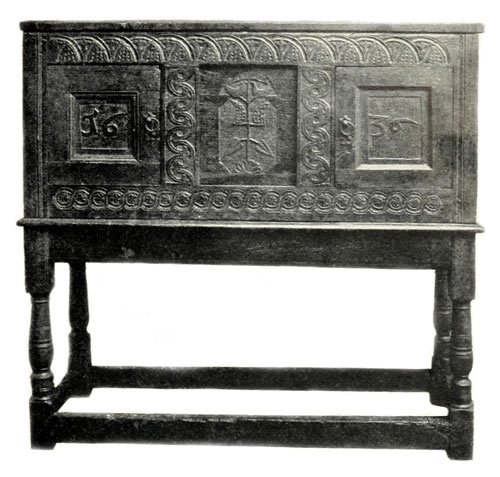
CHEST. DATED 1636.
With Welsh inscription on lid. (Standing on table of later date.)
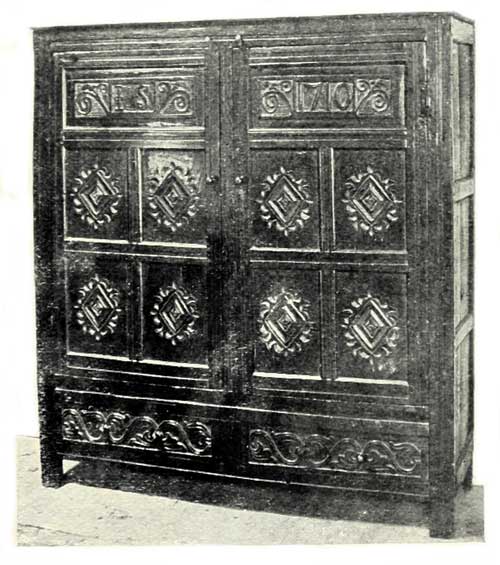
WELSH CUPBOARD.
With typical coarse style of carving. Should be 1650 at latest. Inscribed I.S. 1710.
This loving regard for the past is natural at a time when the rural population jealously feared the oncoming of the age of machinery, which threatened to supersede many of their local industries and finally succeeded in so doing. The obstinate adherence to old forms was possibly part of a nervous fear of the unknown future. The love for existing forms of furniture was therefore part of this apprehensive retention of tradition. Not only was the resistance of town fashions a strong feature, but local prejudices prevailed against the adoption of designs belonging to rival counties. To this day the Staffordshire clothes-horse, carried on pulleys to the ceiling when not in use, differs from the clothes-horse of the cottager in the South with no such mechanical device. In Edinburgh, in the narrow closes, there is a kind of gallows projecting from the windows.
These apparently minor details which find their embodiment in articles of everyday use, fascinate and hold the attention of the acute collector of cottage furniture.
The same local types apply to the art of the potter and are well known to collectors. There are Sussex "tygs" and Nottingham "bears" and Sunderland and Newcastle jugs and mugs. Bristol had its 272 characteristic earthenware, and the Lowestoft china factory was strongly Suffolk in its homely inscriptions with a touch of dialect.
Welsh Carving.—Wales is famous for the abundance of the oak farmhouse furniture proudly kept to this day in families who have held the same homestead sometimes for centuries. One of the most noticeable features is the elaboration of the carving and its native representation, coarsely carved, without foreign influence, of birds and beasts and heraldic monsters which largely figure in the decorative panels of chests, and especially dressers. So popular was oak that it might almost be advanced that there never was any mahogany in Wales. But it is indisputable that the great outburst in carved mahogany chairbacks coincident with the advent of Chippendale and the publication of his Director, never penetrated Wales, although it led to the foundation of a remarkable school of woodcarving on the new lines in Ireland, known as Irish Chippendale, a study of which can be made in Mr. Owen Wheeler's volume on old furniture.
The intense love of the Welsh woodcarver for intricacy is hardly less than that of the sturdy Swiss craftsmen environed by mountains. Perhaps the long winters and the solitary life influence the development of individual character in the applied arts. The Welsh love-spoons of wood, linked together and exhibiting delicate pierced work and minute carving of no mean order, are among other attractive specimens of native art. Ironwork of fine quality is also to be found in Wales.
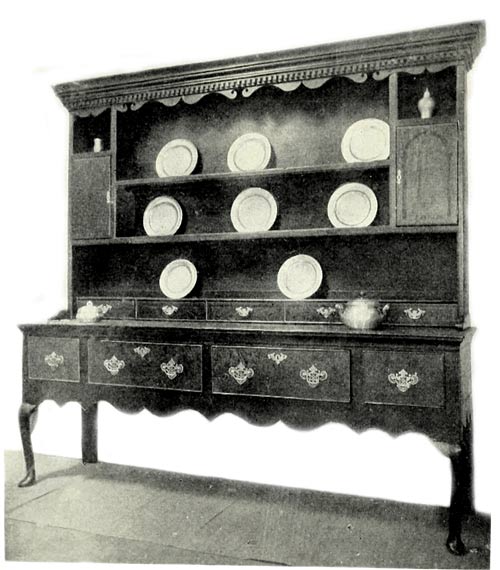
LANCASHIRE DRESSER. ABOUT 1730-1750.
Oak inlaid with mahogany.

ELM WARDROBE (WELSH). ABOUT 1670.
(By the courtesy of Messrs. Phillips, Hitchin.)
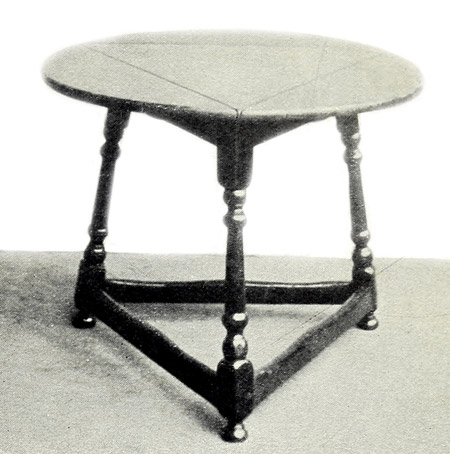
FLAP-TOP TABLE.
Rare Hertfordshire Example. Diameter of top, 2 ft. 6 ins.
(By the courtesy of Messrs. A. B. Daniell & Sons.)
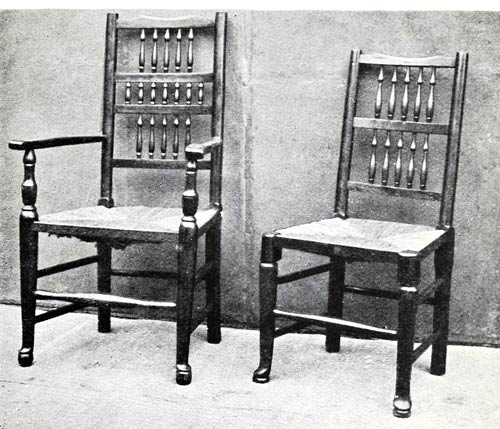
LANCASHIRE SPINDLE-BACK CHAIRS.
277 A carved oak chest of Welsh origin, dated 1636, with Welsh inscription on lid, is illustrated (p. 269). The table on which it stands is of a later date. The carving in this piece is delicate and the middle panel is typical of the representation of birds and foliage. The Welsh cupboard on the same page typifies the coarse woodcarving associated with Welsh farmhouse art. In style this really belongs to a date not later than 1650. But it is dated 1710 and bears the initials "I.S." This is an interesting example, showing how middle-Jacobean styles lingered in country districts remote from outside influence until the early eighteenth century.
An elm wardrobe, probably about 1670 in date, shows another type, but still retaining the coarse character of its carving and its well-filled panels and uprights (illustrated p. 273).
Scottish Types.—Scotland has antiquities of her own which are closely allied to those of all the Gaelic races. As with Welsh carved farmhouse furniture, there is a marked leaning towards coarse style. As a rule it is too utilitarian in appearance to display much carving. The spinning-wheel is still found in farmhouses, and is still used in Harris and the outlying islands. Sometimes these old Highland spinning-wheels come into the market with the smooth surface worn by generations of workers, a surface impossible to reproduce. The Scottish ironwork is especially interesting. Perhaps the most curious of the Scottish antiquities is the crusie. This is undoubtedly a survival of the classic oil lamp. It consists of a shallow trough with a spout in which 278 the wick stands, the oil being contained in the trough (see illustration, p. 289).
Lancashire Furniture.—The especial characteristics of Lancashire-made furniture are a strong leaning to solid structure and a very noticeable reticence in carving. Well-balanced as a rule, and possessing good joinery, they have been favourites with collectors of furniture designed for modern use. A Queen Anne oak dresser illustrated (p. 135) shows this Lancashire sturdiness at its best. This style of large dresser with cabriole legs is associated with Lancashire cabinet work.
A Lancashire dresser, the date of which is from about 1730 to 1750, shows the oak dresser inlaid with mahogany. The carved pediment and the carved underwork beneath the drawers mark this as an unusual specimen (p. 273).
A typical Lancashire oak settle is illustrated (p. 279), showing the Jacobean style in the carved work and in the arms. In date this is about 1660. It will be noticed that the front of the seat has a row of holes, which, prior to the upholstered cushion, a later addition, were intended for ropes to support a cushion, much in the same manner as the iron laths of a modern bedstead.
On the same page is illustrated an oak chest of drawers of Yorkshire origin, in date about 1770. Its plain lines suggest the Hepplewhite types of subdued character.
In regard to spindle-back chairs, Lancashire offers distinctive varieties. Two examples are illustrated (p. 275) as indicating this local type.
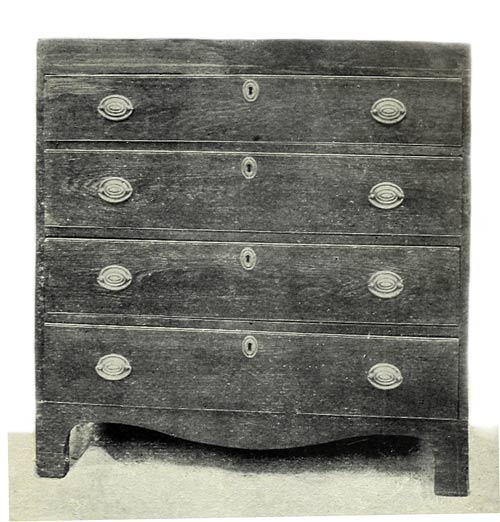
OAK CHEST OF DRAWERS. C. 1770.
Yorkshire type.
Height, 3 ft. 3 ins.; width, 3 ft. 1 in.; depth, 1 ft. 5-1/2 ins.
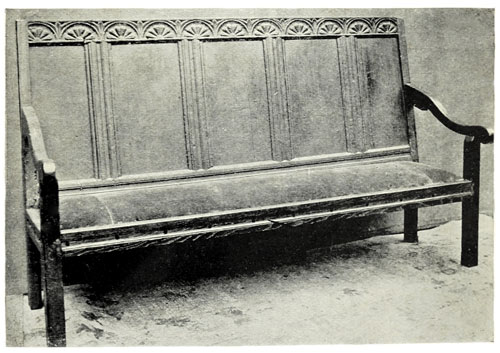
LANCASHIRE OAK SETTLE. C. 1660.
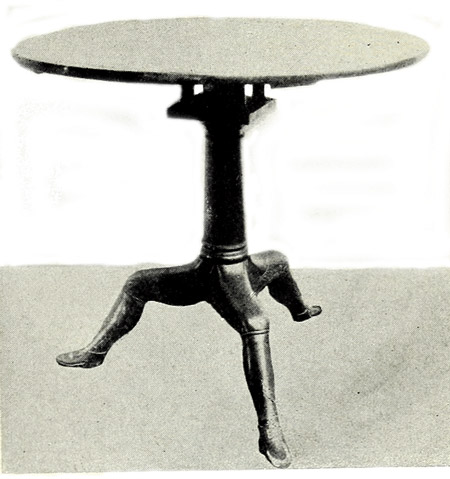
ISLE OF MAN TABLE.
Showing three legs with knee breeches and buckle shoes.
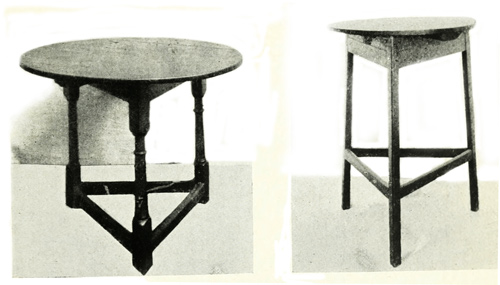
"CRICKET" TABLE. C. 1700.
"CRICKET." C. 1750.
(These types are found in Hertfordshire, South Bedfordshire, South Cambridge, and Essex.)
283 Three Legged Tables.—Hertfordshire, Bedfordshire, Cambridge, and Essex have produced a type of tables termed colloquially "cricket tables," possibly because the three legs are suggestive of three stumps. The term is a foolish one and not very appropriate. A very interesting flap-top table with the three flaps to turn down, illustrated (p. 275), is a very rare Hertfordshire example. This is small in size, having only a diameter of two and a half feet.
Two other tables, one in date about 1700 and the other, of slender form, in date about 1750, are typical of this class of table. A very interesting table is a specimen from the Isle of Man having three carved legs with knee-breeches and buckle shoes.
Sussex is also well-known for her ironwork (see Chapter X.).
Norfolk and Suffolk used to have a class of oak furniture of quaint type, less cumbersome than the Welsh. A type of Sheraton Windsor chair, often inlaid with brass, used also to be found there.
On the whole, those localities which are removed from important towns are the richest in cottage furniture, for example, Wales, Devonshire, Cumberland, Northumberland, and parts of Yorkshire. In places, where the prosperity of the peasants is of long standing, the cottage furniture has been maintained whole almost until the present day.
Altogether the study of local types affords considerable scope for critical study. It is essential that such pieces should be identified and classified before it is too late. Rapidly all cottage and farmhouse furniture is being scattered over all parts of England. 284 Collectors transfer furniture from the North to the South, and the rural treasures of the peasant have been brought to towns and dispersed to alien districts. The Education Act of 1870 and the halfpenny newspaper have brought town fashions to the door of the cottager, and the motor has laid a heavy tribute on rustic seclusion.
CHAPTER X
MISCELLANEOUS IRONWORK, ETC.
The rushlight-holder—The dipper—The chimney crane—The Scottish crusie—Firedogs—The Warming-pan—Sussex firebacks—Grandfather clocks.
The everyday iron utensils and implements of the cottages were simple. It is one of the curious features of the English peasantry that just as they clung to their oak of generations back when mahogany was in vogue, so they adhered tenaciously to ironwork of almost mediæval character when other metals were in fashionable everyday use. Thus the cottager did not feel the oncoming desire for the brass, or later silver and plated candlesticks, but remained firm in his affection for the rushlight-holders in iron, the same types which his ancestors had used, and the firedogs and firebacks of earlier type remained to decorate his hearth. Thus ironwork and rarely brasswork form the sum total of the metal portion of cottage furniture. We will deal with these various utilitarian objects one by one.
It must be remembered that the country farmer was not familiar with ready-made candles, and it 288 probably no more entered his head to purchase candles in a town than it occurred to him to do other than bake his own bread. The cottager therefore made his candles for himself. If he were well-to-do and could afford to entertain his friends in modest fashion, he would doubtless like to illuminate his table with candles of symmetrical form. In which case he would use a candle-mould, and the wax bought in towns would serve for this purpose. But he was not always so rich, and perhaps he was happiest of all with the faintly glimmering rush dips which his forbears used. These afforded a rough-and-ready form of lighting. They burned and spluttered like a torch or flickered faintly as the tallow grew thin. Their form closely resembled an amateur's first attempt at making a cigarette. They were made in the following manner: the thin wirelike rushes which grew by the water's edge were gathered and stripped of their green surface till only the soft white pith remained. This served as a wick. The wax was then melted over a fire in a trough or candle-dipper, of which an illustration appears (p. 289).
Across this long receptacle the pith wicks were laid till the wax soaked into them. They were then taken out for the wax to cool and were dipped once or twice afterwards in order to form their outer coating. By such a primitive process a kind of thin taper was formed. It was not parallel along its sides, but bulged and narrowed throughout its length in primitive manner.
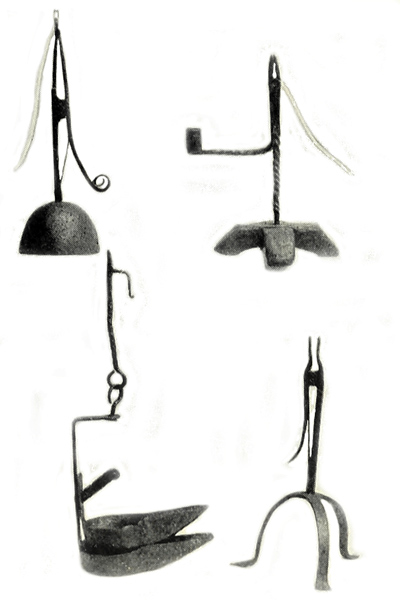
RUSHLIGHT HOLDERS.
Showing rush fixed ready for lighting.
SCOTCH CRUSIE.
With holder.
RUSHLIGHT HOLDERS.
Showing forceps for holding rushlight.

SUFFOLK PIPE CLEANER.
The long clay "churchwarden" pipes were placed in this iron rack and put into the fire, after which they came out perfectly cleaned.
CANDLE-DIPPER.
(In the collection of Messrs. Phillips, Hitchin.)
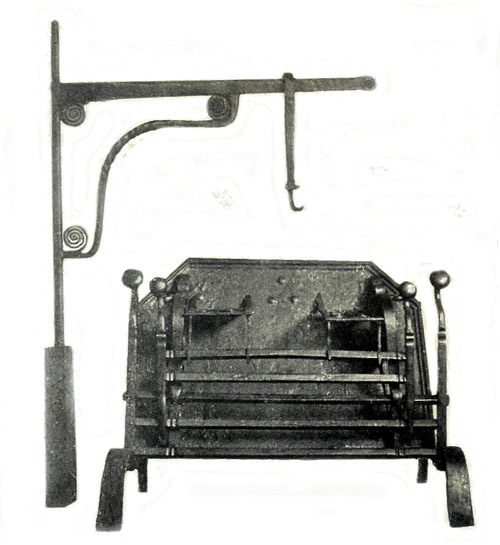
QUEEN ANNE POT-HANGER.
With original grate. Same date.
(By the courtesy of Messrs. Phillips, Hitchin.)

KETTLE TRIVET.
Brass and Iron. Dated about 1770.
Such a taper, from its uneven thickness, would 293 naturally not fit the socket of a candlestick, and the only receptacle would be a scissor-like mechanism with jaws capable of clasping it at any point. Thus we find the rushlight-holder of common use, as illustrated (p. 289).
The illustrations show two rush-holders with the rushlights affixed in position ready for lighting, and one showing how the jaws or forceps clip the rushlight. In practice about an inch or an inch and a half was above the clip and the rest below. A rushlight some twelve to fifteen inches long would burn half an hour, and it had to receive constant attention, being pushed upwards every five minutes. But it must be remembered that the persons who used this primitive form of light did not use it for reading nor for a long period at a time. They usually went to bed early after sunset.
In regard to rushlight-holders the earliest form was without the accompanying candle-socket, but when the use of tallow dip candles became prevalent, later forms are found, as illustrated, with the candle-socket in addition to the holder for the rushlight.
The Scottish crusie is an iron trough of dimensions like a small sauceboat, which was used for lighting purposes, and was often suspended, as in the one illustrated (p. 289), from a crane or hanger. This crusie was filled with oil and the illumination given by a floating wick, much in the same manner as classic examples, to which the shape bears a distant resemblance.
294 The firedogs were always simple, doubtless the product of the local blacksmith. Where they had hooks along the backs they held crossbars to prevent the logs falling into the room. The dates of these, as of all cottage ironwork, are almost impossible to fix, owing to the survival of the earlier types even so late as the middle of the nineteenth century.
The Chimney Crane.—A most important part of the cottager's fireplace was his chimney crane. These were of two kinds, the pot-hook and the swing-arm variety. The pot-hook hung in the chimney from a chain, and from its teeth was fixed a catch which might be lowered or raised to keep the cauldron at a level with the flames.
The swing-arm type is more elaborate, and was made to fit very large fireplaces, where the fire might not invariably be in the same spot on the hearth. This type was used in the kitchens of the better farmhouses. Its end was fixed to the wall of the hearth, and the pot could be swung backwards and forwards and sideways, besides being raised or lowered to the fire.
The pot-hook is of great antiquity, and belongs to days when man first learned to cook his food. Frequently in this country early examples are dug up. There are fine specimens to be seen of the late Celtic period at the Owens College Museum, at the Northampton Museum, at the Liverpool Museum, at the Pitt Rivers Museum at Farnham, at the Victoria and Albert Museum, and elsewhere.
"Pot-hooks and hangers" is an English phrase 295 denoting the beginning of things academic, and the French phrase pendre la crémaillère (literally to hang the pot-hook) is used to-day in reference to what we term a "house-warming" party on settling in a new abode.
Another interesting cottage treasure is the cake-baker. This was a kind of thick frying-pan having a lid, which protected the dough from the heat when it was held over the smouldering ashes. The tops of these are often incised with quaint patterns, the impress of which appears on the cake.
Kettle-trivets are sometimes found in cottages, possibly relics from better houses or having belonged to the more prosperous farmer. They are not wholly of iron, being partly of brass. The specimen illustrated (p. 291) is of late eighteenth-century days.
The Warming-pan.—There is an especial charm in the old brass warming-pan of the farmhouse and the treasured highly-polished ornament of many a proud cottager to-day. Many modern-made warming-pans from Holland and elsewhere have found their way into the possession of unsuspecting collectors. But fine old English warming-pans are interesting, and summon up memories of careful housewives and well-aired lavender-smelling sheets in ancient old-world inns. On fine examples inscriptions may be found, and the incised work of the pattern on the brass covers is often individual in character.
Of the examples illustrated (p. 307) one has an incised inscription around the edge, "The Lord only is my portion." The other has a dotted geometrical 296 pattern with a star-like design of conventional floral incised work.
It is unfortunate that the diligence of the housewife has often obliterated much of the fine work of some of these designs. The warming-pan offers in itself a complete field for the collector. He can compare the work of seventeenth-century Dutch examples, with their quaint religious inscriptions and their finely embossed and engraved ornamentation, with English specimens of the same date. That the warming-pan was in use in Elizabethan days is proved by references in Shakespeare. It has a long history, from Sir John Falstaff, when Bardolph was bidden to put his face between the sheets and do the office of a warming-pan, to Mr. Pickwick—to quote Sergeant Buzfuz, "Don't trouble yourself about the warming-pan—the warming-pan! Why, gentlemen, who does trouble himself about a warming-pan?"
Sussex Firebacks.—The fireback was usually part of the cottager's belongings, though perhaps only one would figure in his house, where possibly his only hearth was in his living-room.
These were cast and forged in various parts of the country, and large numbers appear to have been made in Sussex, which is, or rather was, the greatest hunting-ground for good specimens of cottagers' ironwork. Some highly interesting specimens of these are to be herein illustrated.
The records of the Sussex iron industry go back to a very early date, and the town of Lewes, in the thirteenth century, raised taxes by charging a toll on 299 every cartload of iron admitted. Under Edward III. the Sussex ironworks provided three thousand horseshoes and twenty-nine thousand nails for the English army in its campaign in Scotland. The local rhyme—
is not without reason, as in Bodiam Castle and elsewhere are mortars of Sussex work of fifteenth-century style. In the sixteenth century a considerable number of firebacks was made, some with the royal arms and with the royal cipher, "E.R.," and bearing dates and sometimes makers' names.
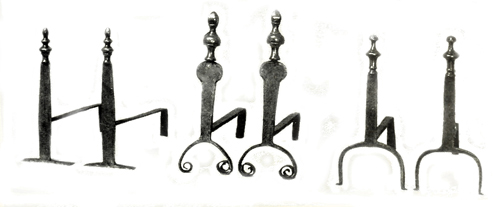
COUNTRY FIREDOGS. EIGHTEENTH CENTURY.
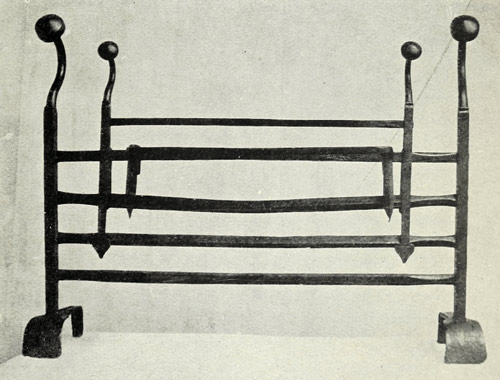
FIRE GRATE. EIGHTEENTH CENTURY.
The earliest form was stamped with the fleur-de-lys or with portions of twisted cable to form some sort of symmetrical design. We are enabled, by the kindness of Mr. C. Dawson, F.S.A., of Lewes, to reproduce some Sussex firebacks from his collection. An example of the first half of the sixteenth century, illustrated (p. 301), shows the rope-like border impressed on the sand mould, and the field impressed with repetitions of a fleur-de-lys from a single stamp. Another interesting fireback is the "Royal Oak" design, with the initials "C.R." This is commemorative of the escape of Charles II. from pursuit by Cromwell's Ironsides and his refuge in the oak-tree. It will be observed that this specimen has a moulded edge, which is from a single wood pattern carved in one piece. Amidst the oak foliage will be seen three crowns, and this exuberance of loyalty bears a resemblance to certain chairs of the period (copied 300 by the score nowadays), in which the crown finds a place in the stretcher.
One fireback illustrated (p. 303) shows an ironmaster with his hammer at his forge. The adjacent piece has the Tudor rose surmounted by the royal crown, and bears the date 1650, slightly earlier than the "Royal Oak" example.
All the foregoing specimens are native in their conception of design. They approximate closely to the Jacobean carved panel with its narrow range of subjects, and have a relationship to Stuart needlework with its royal symbolism. Later came the Dutch influence, most marked in its effect upon the shape, height, and character of these firebacks. This became especially noticeable in the eighteenth century, and in the illustrations (p. 303) of two wooden patterns from which the firebacks were made at Ashburnham, Sussex, this is clearly shown. The designs are ornate and represent either some scriptural or mythological subject. The woodcarving is of a style strongly under Dutch influence, and the tall proportions suggest gravestones (indeed, in Sussex there are headstones made of iron, with pictures and inscriptions).
The mode of casting these iron firebacks in sand and the employment of wooden patterns to form the mould into which the molten metal was to run is familiar to any foundry in casting iron. In regard to the early examples with the twisted cable rim, it is conjectured that pieces of twisted rope were actually laid on the wet sand to produce this pattern—that is, before the use of carved wooden patterns such 305 as are illustrated. In regard to the bolder "cable twist" pattern, it is believed this was produced by impression of pieces of rope stiffened with glue, and twisted around iron rods.
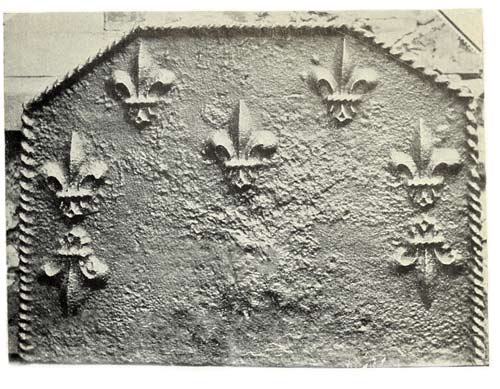
SUSSEX IRON FIREBACK. FIRST HALF OF SIXTEENTH CENTURY.
Rope-like border impressed on sand mould. The field impressed with repetitions from a single fleur-de-lys stamp.
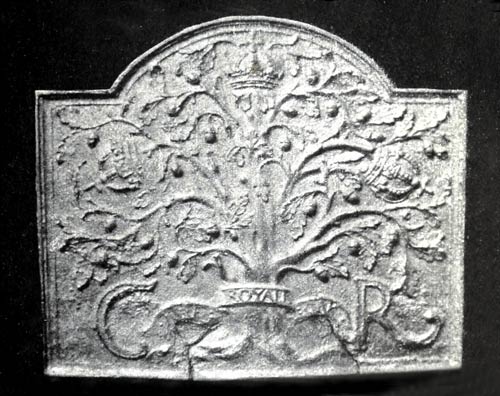
SUSSEX IRON FIREBACK.
The Royal Oak Design, commemorative of the Restoration. Late Seventeenth Century. Moulded edge and carved in one piece from a single pattern.
(In the collection of Charles Dawson, Esq., F.S.A., Lewes.)
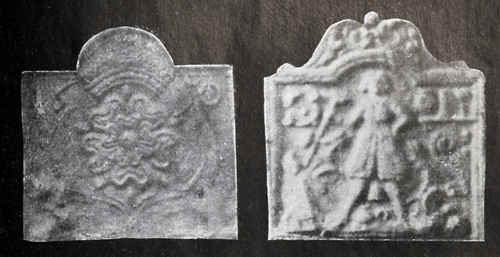
SUSSEX FIREBACKS.
Tudor Rose surmounted by Royal Crown. Dated 1650.
Depicting Ironmaster at his Forge.
(Very rusty and worn.)]
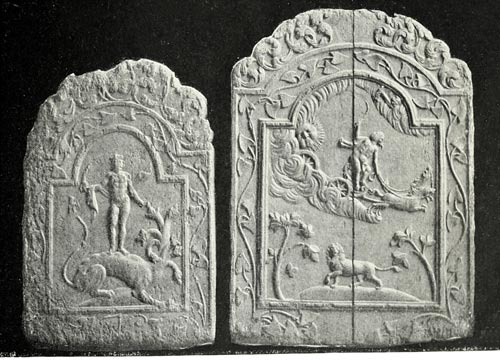
ORIGINAL WOODEN PATTERNS.
Dutch influence. Eighteenth Century. From which firebacks were made at Ashburnham, Sussex.
(By the courtesy of Charles Dawson, Esq., F.S.A., Lewes.)
The size of the wooden pattern is slightly larger than the resultant fireback, owing to the shrinkage of the metal on cooling. This diminution in design is a factor in the potter's art, when figures in some cases lose nearly a third of their original proportions when moulded in the clay prior to firing.
Firebacks have attracted a considerable amount of interest. There are many collectors, and a great deal of close study has been applied to the subject. Country museums in the vicinity of the Weald of Sussex and Kent contain many notable examples, especially those of Lewes, Hastings, Brighton, Rochester, Maidstone, and Guildford. In the first mentioned there are some very rare and beautiful examples of Sussex firebacks.
Especially interesting in connection with the Sussex ironworks is the illustration (p. 309) of a clock face made by a local maker, Beeching of Ashburnham, in the late seventeenth century. This brass dial of a thirty-hour clock, with single hand and alarum, is ornamented with designs showing various phases of the iron industry as carried on in Sussex. There is a cannon with diminutive figures holding the match. There are cannon-balls, and a liliputian fireback with a crown on it. Men with pickaxes, men felling trees, and others tending the furnaces, symbolise the business of a foundry.
It was not until 1690 that the minute numerals 306 were placed outside the minute divisions in clock faces, so that this face, having the minute numerals absent and the minute divisions in the inner circle, presumably belongs to the late seventeenth century.
Grandfather Clocks.—A volume on cottage and farmhouse furniture would be incomplete without some reference to grandfather clocks. At the beginning of the eighteenth century this type of clock had become popular. The early brass-bracket clock known as "Cromwellian," varying from six to ten inches in height, had a spring. With the use of the long pendulum and revolving drums, around which catgut is wound to support the heavy weights, these unprotected parts required a wooden case.
The "lantern" or "bird-cage" clocks (wallclocks from which the pendulum and weights hung unprotected) lasted till about 1680, when the first grandfather type with wood case came into use.
The early examples with cases exhibiting fine marquetry are outside the scope of the class of furniture now under consideration. In such specimens there is frequently a round or oval opening covered with glass in the centre of the panel.
In earlier types the metal dial is square, and later it became lunetted at top, and the wood case had a corresponding curve. In clocks made for great houses there were chimes, and their works were by well-known town makers. But in cottage examples, instead of the eight-day movement, more often than not the clock only ran for twenty-four hours. There is little attempt at ornament in these plain oak varieties. The case is soundly constructed, and 311 sometimes, in exceptional examples, the head is surmounted by brass ball finials, as in the finer examples. As a rule the country cabinet-maker confined himself to an ornamental scrolled head. In later examples the metal dial—and these come at the beginning of the nineteenth century—is painted with some rustic scene with figures, and frequently there is a revolving dial showing the days of the month.
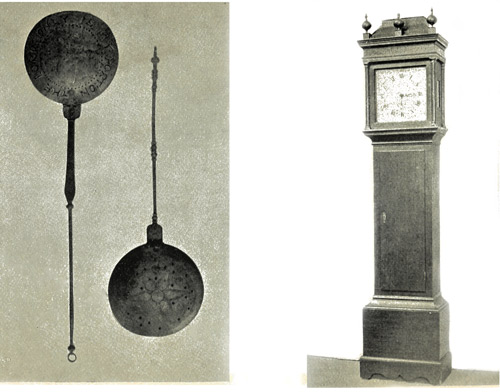
WARMING-PANS.
Finely decorated with incised work. One with inscription, "The Lord only is my portion."
(By the courtesy of Mr. S. G. Fenton.)
GRANDFATHER CLOCK.
With Oak Case.
Made by J. Paxton, St. Neots. Height, 6 ft. 10 ins.
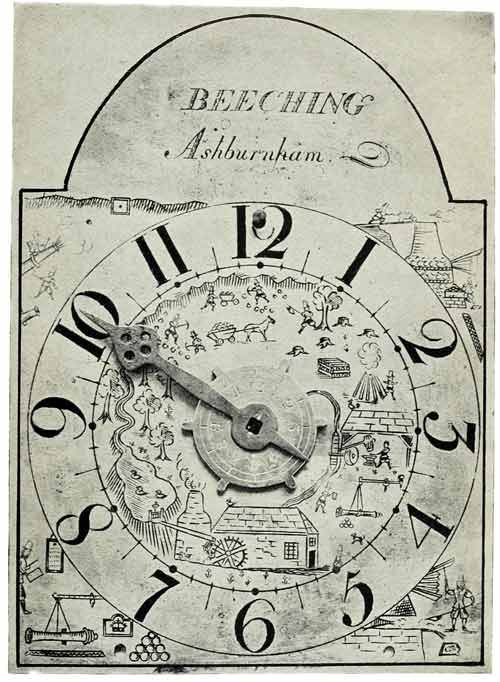
BRASS DIAL OF THIRTY-HOUR CLOCK.
Single Hand and Alarum. Late Seventeenth Century.
Ornamented with designs showing various phases of the iron industry, as carried on at Ashburnham, Sussex.
(In the collection of Charles Dawson, Esq., F.S.A., Lewes.)]
The entire head covering the dial is often removable in old clocks to which there is no hinged door, as in later made examples.
These country grandfather clocks are much treasured by their owners, and have been handed down in families for generations. Owing to the indefatigability of collectors and their persistent and tempting offers, many have left their old homes. The demand has been great, and thousands of "grandfather" clocks have been made during the last twenty years and sold as "antique," or old cases with plain panels have received the unwelcome attention of the modern restorer and have been carved to please a popular whim for carved oak panels.
In regard to dates of grandfather clocks the records of the Clockmakers' Company give a list of makers of the eighteenth century, enabling the period to be fairly accurately fixed. The walnut cases inlaid with floral marquetry, often attributed to the period 1690-1725, that is William and Mary and Queen Anne, frequently belong to a quarter of a century later. The case-makers clung more closely to old designs than did the clockmakers. Hence 312 the case very often is of apparently older style than the works, though both were made contemporaneously. In addition to this, new clocks were put in older cases, or vice versa, which, like putting new pictures in old frames, adds to the gaiety of collecting.
In general the London clock-cases are only roughly indicative, in comparison with the Company records, of contemporary styles of furniture. In country-made pieces the wood cases are anything from twenty to forty years behind London fashions. For example, the arched top occurs after 1720 in London, and after 1735 in the provinces. In the Director of Chippendale and in Sheraton's and Hepplewhite's books of designs there are illustrations of clock cases. The progression of styles of eighteenth-century grandfather clock cases is from plain oak to figured walnut, black and red lacquer, floral, "seaweed," or mosaic marquetry, and in the latter decades of the eighteenth century inlaid mahogany cases, and many of these have finely veneered panels. In many country clocks oak cases are veneered in mahogany, but as a rule country made grandfather cases are plain oak. The example illustrated (p. 307) indicates the plain type of solidly made provincial piece. The clock was made by J. Paxton at St. Neots.
The mahogany-cased grandfather clock is never found in cottages. There are no Chippendale styles in this field for the collector to search for. The plainness of the country style has happily in many instances preserved them from alien hands. An 313 interesting revival, chiefly on account of expense, is found in the Dutch clock, with china face painted with flowers, which the cottager bought in early and middle nineteenth-century days. This form of clock reverted to the unprotected pendulum and weights, and is an object-lesson in what the style of English clock was before the use of a long wooden case. But these Dutch clocks are interesting rather than valuable, and have not yet claimed the attention of collectors.
CHAPTER XI
OLD ENGLISH CHINTZES
By Hugh Phillips
The charm of old English chintz—Huguenot cloth-printers settle in England—Jacob Stampe at the sign of the Calico Printer—The Queen Anne period—The Chippendale period—The age of machinery.
The present chapter has been added with perhaps some justification, since it seemed to the writer that such a subject as old English chintzes might appropriately take its place beside the equally homely craft of the rural cabinet-maker.
For the chintz is the tapisserie d'aubusson of the peasant—it covers his chairs and drapes his windows, giving warmth and wealth of colour to the otherwise barren appearance of his cottage. Further, it reflects his simple horticultural tastes, for the brilliantly coloured roses, pansies, and convolvuluses which shine prominently on the glazed surface of the cloth are those flowers which are always to be found in his garden.
318 Chintz or printed cotton is the only decorative fabric known to the village upholsterer. When persons of wealth hung their windows with silk brocades and covered their chairs with costly needlework and damasks, the rural cabinet-maker was supplying his modest clientèle with these homely patterns printed upon common cloth.
These unassuming fabrics were as much cherished by the cottagers as anything which they possessed. The classical ornament of expensive silks they did not understand, and the freely treated birds and flowers which figured on chintz represented the Alpha and Omega of beauty in textile design.
So great, indeed, is the fascination of these for the cottagers that to-day, in districts less penetrated by modern advance, the rural populace will not extend their affections to the up-to-date designs of upholsterers, but insist upon the old spot and sprig patterns of their ancestors.
There is much wisdom in the conservative taste of the peasant, for the old chintz of the eighteenth and early nineteenth centuries was of the highest artistic merit. In the heyday of its fame the fabric was exceedingly fashionable amongst the richest persons, and there are abundant records of the popularity of old English chintzes upon the Continent. For, at its best periods, the chintz was not a base imitation of more expensive fabrics; it did not, for instance, occupy the relationship of pewter to silver or moulded composition to genuine woodcarving. On the contrary, the designing of chintzes is an art of distinction, governed by canons which bear little 321 relationship to other decorative textile crafts. For where the silk-weaver is confined to solid patterns which will appear in his transverse threads, the printer of cloths can wander unrestrained into designs of wonderful intricacy and beauty: every colour in nature he can imitate, and no object is too delicate or too rich to stamp upon his cotton. Indeed, his art stops little short of that of the painter of pictures.
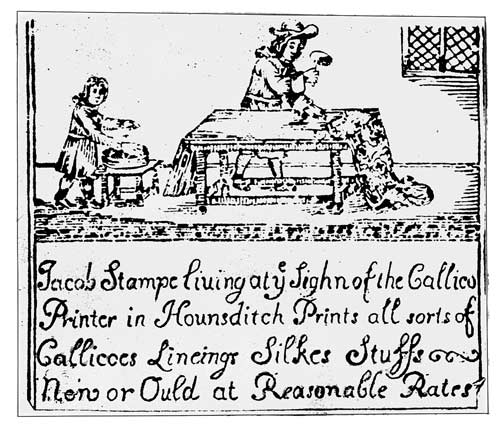
OLD TRADE CARD SHOWING CALICO PRINTERS AT WORK.
"Jacob Stampe living at ye Sighn of the Callico Printer in Hounsditch Prints all sorts of Callicoes Lineings Silkes Stuffs New or Ould at Reasonable Rates."
(From old print at British Museum.)
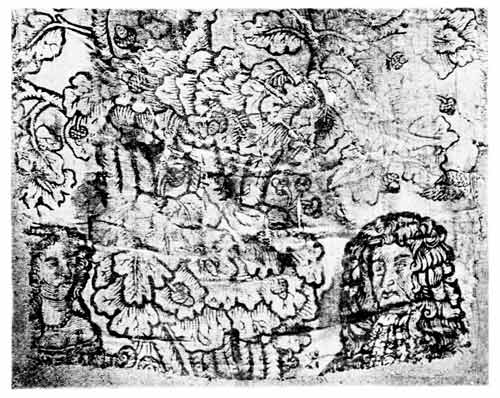
ENGLISH PRINTED CALICO. ABOUT 1690.
With contemporary portraits.
(By courtesy of Mr. T. D. Phillips.)
A glance at the illustrations will more closely confirm this, for such designs could not be imitated by any other textile process, the multitudinous twists and curves and the delicate shades and patches of colour being only possible to the printer.
Interesting as is the study of old chintzes, the history of the art in England is even more fascinating. From the obscurity of a small local craft it became one of our great national industries.
Of its earliest history in England we know nothing, and a search among old documents fails to reveal any traces of chintz-printing before the Renaissance. There are several vague references to the subject in the sixteenth and seventeenth centuries, but none of them disclose any solid information. Thus the question of who was the first chintz-printer remains an unsolved riddle. It appears, however, that in the seventeenth century there was a gradual immigration of foreign workmen of Dutch and French nationalities who were well versed in the art of cotton-printing—then well established upon the Continent. These people came over in gradually increasing numbers, their arrival culminating in the huge influx of foreigners about 1650 to 1700.
322 The majority of them were by trade silk-weavers and printers. Their departure was a serious blow to France, for they transferred to England what had been great national industries in France. Settling in and about London, the refugees peaceably recommenced their work, and soon the weaving of silks in Spitalfields and the printing of chintzes in Richmond, Bow, and Old Ford became a source of great prosperity to this country.
On p. 319 is an illustration of a seventeenth-century trade card of one of the chintz-printers, or, as they were then called, calico-printers. Here we see in a most lucid manner the process by which chintzes were produced in the time of James II. The inscription runs: "Jacob Stampe living at Ye Sighn of the Callico Printer in Hounsditch Prints all sorts of Callicoes Lineings Silkes Stuffs, New or Ould, at Reasonable Rates."
A printer is standing at a table upon which is stretched a length of cloth, which falls in folds on the floor. He holds in his hand a wooden block, which he is applying at intervals to the cloth. The other hand contains a mallet, which is about to strike the wooden block and stamp the colour firmly into the threads of the material. Behind him is an apprentice boy, standing over a tub of colour, preparing the blocks for his master to use.
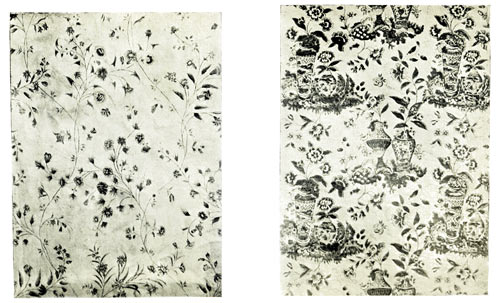
HAND-PRINTED CHINTZ.
Queen Anne Period.
HAND-PRINTED CHINTZ.
Chinese style. Middle Eighteenth Century.
By so clumsy a process very delicate work could not be produced, and, indeed, the few examples of this period which remain are very heavy in character. One of these, which has been lent by Mr. J. D. Phillips, the owner, is illustrated on p. 319. It belongs to the 325 end of the seventeenth century and corresponds to the William and Mary period of English furniture, being contemporary with the pieces illustrated on pp. 77, 117 in the earlier chapters. It will be seen that this example contains two portraits in costume of the late Stuart period, possibly intended for portraits of William and Mary. Their portraits are of frequent occurrence on Lambeth delft of this period.
The printer has only produced the outline, the colour being added by hand with a brush, for at this date the printing of colour by the successive application of blocks had not been mastered. The black ink to-day lies thick upon the cloth, as coarsely as though it had been dabbed on with a stencil. The material is a rough hand-woven canvas. Printed cloths of the period of Charles II. and James II. and William and Mary are exceedingly rare and seldom met with, as, owing to their roughness, they have been destroyed by subsequent owners. A few, however, are to be found on walnut chairs under the coverings of later date. Often, indeed, one meets a chair covered in Victorian horsehair which will reveal underneath the successive coverings of many generations of owners, including perhaps the material in which it was first upholstered.
As the seventeenth century wore on and we enter upon the early years of the eighteenth century—the days of Queen Anne—the chintz-printers became more prosperous. Their work, owing to its increasing delicacy, met with great public approval, 326 and it began to supplant woven silks for the purposes of curtains, coverings, and dresses. Thus the silk-weavers of Spitalfields found a declining market for their goods and soon came into friction with the printers. Much bad feeling ensued, and eventually their quarrels resulted in the distribution of defamatory literature which is to-day most amusing. The weavers circulated the curious "Spittlefields Ballad" against "Calico Madams," or the ladies who wore chintz dresses.
THE SPITTLEFIELDS BALLADS
OR THE
Weaver's Complaint Against the Callico Madams
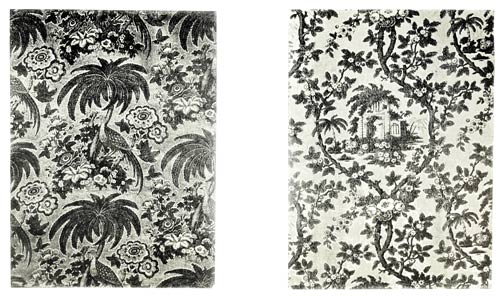
HAND-PRINTED CHINTZ.
Exotic-Bird style. Middle Eighteenth Century.
HAND-PRINTED CHINTZ.
Gothic style. Late Eighteenth Century.
The poet in several long stanzas warms in his indignation, and finally directs his verse against the male friends of all fair wearers of chintzes, suggesting that—
It is not surprising that the weavers should find it difficult to set their productions against those of the cloth-printers, for the chintzes of this period are surpassingly beautiful. One of them is illustrated on p. 323. Here the material is no longer a rough canvas, but is now a light dress cambric, similar to the thin smooth chintz cloth which has survived till to-day. A delicate pattern of intertwining stems winds upwards, the stalks having blossoms of finely cut outline and brilliant colours. Old chintzes of this period may be recognised by their lightness and by the long thin designs of intermingling flowers of Indian type. These were all more or less borrowed from the Marsupalitan printed cloths brought over by the India trading companies, and the flowers and colourings of this date are nearly always very closely copied from Eastern originals, the cornflower and carnation being among those most frequently met with.
330 The ill-feeling between the printers and weavers was of long duration, and eventually took the form of open riots and street demonstrations similar to those of to-day. On one occasion, in 1719, they went from Spitalfields to Westminster and protested against the popularity of chintzes and suggested that their use be forbidden. On the return journey they manifested their feelings by tearing off the chintz gowns of various ladies whom they met upon the route. Evidently Parliament pandered to these labour riots, for in 1736 printed cloths were forbidden by Act of Parliament, but this legislation was of short duration; the Act was soon repealed and the fascinating material became the rage once more.
The next stage at which we look upon chintz-printing is about 1760, in the middle of the period of Chippendale furniture. This is the golden period of its printing. Technically and artistically the hand-printed chintz now reached its climax. Colour-work by superimposed blocks was in full swing, and the designer had, in the works of contemporary artists, a wider field for the selection of subjects suitable for his fabric. Among the many varieties of chintzes which we find at this date the most prominent are the Gothic and Chinese designs to suit the current taste in furniture, and the exotic bird patterns, which are perhaps the finest of all.
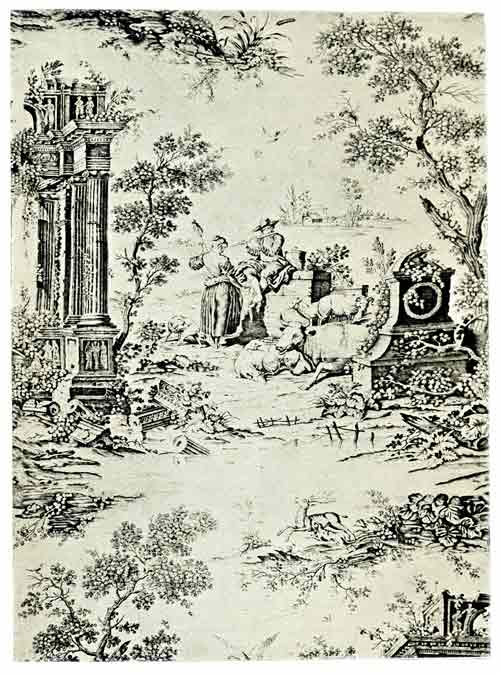
HAND-PRINTED CHINTZ. ABOUT 1760.
By R. Jones, of Old Ford, London.
The formation of the designs has changed considerably by this time and we no longer find the intertwining or serpentine form as in the Queen Anne chintzes. The flowers and objects to be printed are now massed together and represented as 333 little disjointed islands floating in mid-air. By this distinctive feature they may easily be recognised. One of these charming exotic bird chintzes is illustrated on p. 327. Here a pheasant is resting under a palm-tree upon a small island of densely packed foliage. The whole idea of the design is taken from the Chinese porcelain of the period. The bird, the flowers, and every object portrayed come from the East and are drawn in the manner constantly seen upon the Famille Rose dishes and vases of the period. These exotic bird patterns are not exclusively found upon chintzes, for the collector of English porcelain will be familiar with them in the early productions of the Bow and Worcester factories.
Another feature which one notices in printed fabrics at this date is the buff ground. The cloth is white, and the pattern is printed upon it in this state so that the pinks, blues, and greens of the flowers may have every advantage of transparency. The buff background is then printed in afterwards, leaving a thin margin around the design. In this manner great richness and depth is given to the colours without undue harshness, which would be the result if they were exhibited upon a white background. The illustration on p. 323 shows a chintz in the Chinese manner, designed to conform with the oriental furniture of Chippendale. Here again we see the detached islets of vegetation, but instead of exotic birds we have Chinese vases containing flowers, and in the foreground a rococo shell, one of the then little-known species from the East greatly treasured in England. The carnations and foliage 334 will be readily recognised as copies from Chinese paintings. One might illustrate a very large number of these Chinese chintzes, but space will only permit one example. This particular specimen is probably unique; it is taken from an old roll of chintz printed about 1760 and left over after the owner had curtained his house. The roll (about twenty yards long) has been carefully preserved and handed down from generation to generation, so that its original colours and soft glaze remain intact.
A chintz in the Gothic manner is illustrated on p. 327. It differs slightly from the others in that the island formation is combined with serpentine foliage. In the centre is a patch of ground upon which are the ruins of a Gothic church. The artist, however, has not forgotten to please those patrons who might prefer the Chinese style, and therefore he has quietly added the incongruous elements of prunus flowers in the foreground and palm-trees in the background. At first this quaint admixture may appear a bad art, but it must be remembered that at this quaint period the whole principle of decorative design was upset by the rococo school, and quaintness and delicacy of detail outweighed the greater considerations of line and proportion. We find a similar treatment of design later on in many Spode plates, especially in blue transfer-printed subjects.
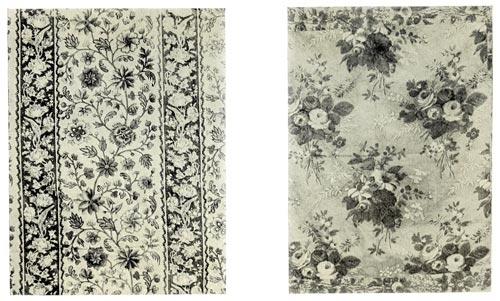
PRINTED CHINTZ.
Hepplewhite Period.
PRINTED CHINTZ.
Victorian Period.
In the third quarter of the eighteenth century we enter upon a new era in the history of chintzes. We may appropriately call it the age of machinery, for from this date the mechanical processes came in whereby chintz-printing was raised from the 337 position of a comparatively small craft to that of a huge national industry. The great manufacturing towns in the North, such as Manchester, were rising in importance, and Lancashire was forming the basis of its gigantic cotton trade. Following these trade movements, the old industry of cloth-printing gradually left its centre in London and was developed on a larger scale in the North of England.
In spite of this great commercial spirit which seized the printing of textiles, hand-block printing did not pass away, for it has survived till to-day as the best method for fine artistic work; cretonnes and chintzes produced in this manner, even during the nineteenth century, are always good. Mechanical roller work, however, was responsible for a large output of work which is little worthy of preservation, and in the nineteenth century we find much machine-printed chintz which, to say the least, is not reminiscent of the fine handwork which preceded it in the mid-eighteenth century. The earliest machine-work was carried out by means of engraved copper plates applied to the cloth in a printer's press. One of these is illustrated on p. 331. It is exceedingly fine in its details, and very few old specimens of this pattern are in existence. In several places are inserted the printer's name and date, "R. Jones, Old Ford, 1761." The design is doubtless borrowed from the Toiles de Jouy, printed by a Bavarian at Jouay, near Versailles, about this time. The drawing, however, is finer than any specimens of his work which have come to the author's notice. A shepherdess is 338 tending to her flock amid a classical ruin while she is listening to the music of a flute. In another portion of the design, a cock and hen are mourning for the loss of one of their brood which has been carried off by an eagle. This design is worthy of interest for its superior quality, as it must have been produced for some very fine house. There is another specimen printed in red in the Victoria and Albert Museum. The one which is illustrated here was found upon an exceedingly fine Chippendale bedstead.
During the Hepplewhite and Sheraton periods of furniture the chintz ceases to have its pattern detached and grouped. Architectural details with figures disappear, and once more the designer returns to flowers as his subject for illustration. The foliage, however, now takes the form of vertical stripes, being contained within lace-like ribands placed at even distances. On p. 335 is an illustration of a chintz about 1790 in which these features will be noticed.
In the nineteenth century we find the chintz covered with disjointed sprigs, as though the flowers had been plucked and cast upon the cloth. Their outline is softened by a margin of dots. An illustration of this style is shown on p. 335.
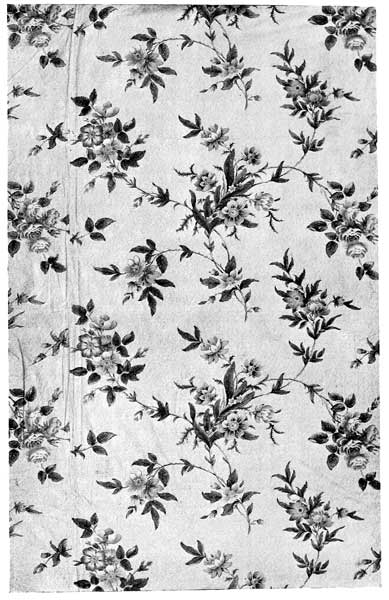
PRINTED CHINTZ.
From the Calico Printing Factory at Sobden, in Lancashire. Printed in 1831 under the direction of Richard Cobden.
(In the collection of Mrs. Cobden Unwin.)
One need not pursue the history of chintzes further, for to do so would entail a discussion of modern methods. Suffice it to say that in the nineteenth century we come across the hideous black grounds, the base imitation of woven designs, leopard skins, and other inartistic perversions. We must rather bid adieu to this beautiful art ere it has begun 341 to decline. It will afford the reader much pleasure if he should form a collection of old specimens and frame them around his walls, for then he will fully appreciate their charm. In examining his own collection the author has spent many a pleasant hour, for these gaily coloured chintzes are among the most articulate relics which have come down to us. They breathe the spirit, the feelings, and the ideals of the periods wherein they were made. They show lucidly the various changes in fashion and the rise and wane in the popularity of certain forms of decoration. So delectable are their soft, faded colours, so fascinating are the designs, and above all, so enchanting is the old-world musty scent which always clings to them, that it would be hard indeed to withhold one's affection from them.
UNWIN BROTHERS, LIMITED, THE GRESHAM PRESS, WOKING AND LONDON.
[1] Those interested in the method pursued in Sweden and Denmark and the grave necessity for speedy measures to preserve our national cottages and farmhouses from effacement will find illuminating articles on the subject from the pen of "Home Counties" in the World's Work, August, October, and November, 1910, and in the American Educational Review, February, 1911, in an article by Lucy M. Salmon. "Old West Surrey," by Gertrude Jekyll (Longmans & Co.), 1904, contains a wealth of suggestive material relating to cottage furniture and articles of daily use of old-style country life now passing away.
[2] Pepys's Diary, June 12, 16 8.
[3] Postlethwaite's "Dictionary of Roads."
VOLUMES FOR COLLECTORS
———BY THE SAME AUTHOR———
CHATS ON OLD FURNITURE
Companion volume to "Chats on Cottage and Farmhouse Furniture"
Press Notices, First Edition
"Mr. Hayden knows his subject intimately."—Pall Mall Gazette.
"The hints to collectors are the best and clearest we have seen; so that altogether this is a model book of its kind."—Athenæum.
"A useful and instructive volume."—Spectator.
"An abundance of illustrations completes a well-written and well-constructed history."—Daily News.
"Mr. Hayden's taste is sound and his knowledge thorough."—Scotsman.
"A book of more than usual comprehensiveness and more than usual merit."—Vanity Fair.
"Mr. Hayden has worked at his subject on systematic lines, and has made his book what it purports to be—a practical guide for the collector."—Saturday Review.
CHATS ON ENGLISH CHINA
Press Notices, First Edition
"A handsome handbook that the amateur in doubt will find useful, and the china-lover will enjoy for its illustrations, and for the author's obvious love and understanding of his subject."—St. James's Gazette.
"All lovers of china will find much entertainment in this volume."—Daily News.
"It gives in a few pithy chapters just what the beginner wants to know about the principal varieties of English ware. We can warmly commend the book to the china collector."—Pall Mall Gazette.
"One of the best points about the book is the clear way in which the characteristics of each factory are noted down separately, so that the veriest tyro ought to be able to judge for himself if he has a piece or pieces which would come under this heading, and the marks are very accurately given."—Queen.
CHATS ON
ENGLISH EARTHENWARE
(Companion volume to "Chats on English China")
"Complementary to the useful companion volume, in this 'Chats' Series, on English China which Mr. Hayden issued five years ago."—Times.
"Is a compendious account of our native English faïence, abundantly illustrated and accurately written."—Guardian.
"A thoroughly trustworthy working handbook."—Truth.
"It is a mine of knowledge, gathered from all quarters, and the outcome of personal experience and research, and it is written with no little charm of style."—Lady's Pictorial.
"Mr. Hayden knows and writes exactly what is needed to help the amateur to become an intelligent collector, while his painstaking care in verifying facts renders his work a stable book of reference."—Connoisseur.
"The volume has been written as a companion to Mr. Hayden's 'Chats on English China' in the same series, and those who recall the admirable character of that book will find this to be in no way inferior."—Nation.
"The illustrations are profuse and excellent, and the author and the publishers must be commended for offering us so many reproductions of typical specimens that have not appeared in any previous handbook. The illustrations alone are worth the cost of the book."—Manchester Guardian.
"Mr. Hayden's book is filled to overflowing with beautiful and most instructive and helpful illustrations, and altogether it is one that will give immense pleasure to collectors, and much information to the admiring but ignorant."—Liverpool Courier.
CHATS ON OLD PRINTS
A Practical Guide to Collecting and Identifying Old Engravings.
"Mr. Hayden writes at once with enthusiasm and discrimination on his theme."—Daily Telegraph.
"Any one who, having an initial interest in matters of art, wants to form sound and intelligent opinions about engravings, will find this book the very thing for him."—Literary World.
"These 'Chats' comprise a full and admirably lucid description of every branch of the engraver's art, with copious and suggestive illustrations."—Morning Leader.
Transcriber's note:
The original page numbers that refer to illustrations have been retained, however, if you click
on a link, it will take you to the page where the illustration now resides.